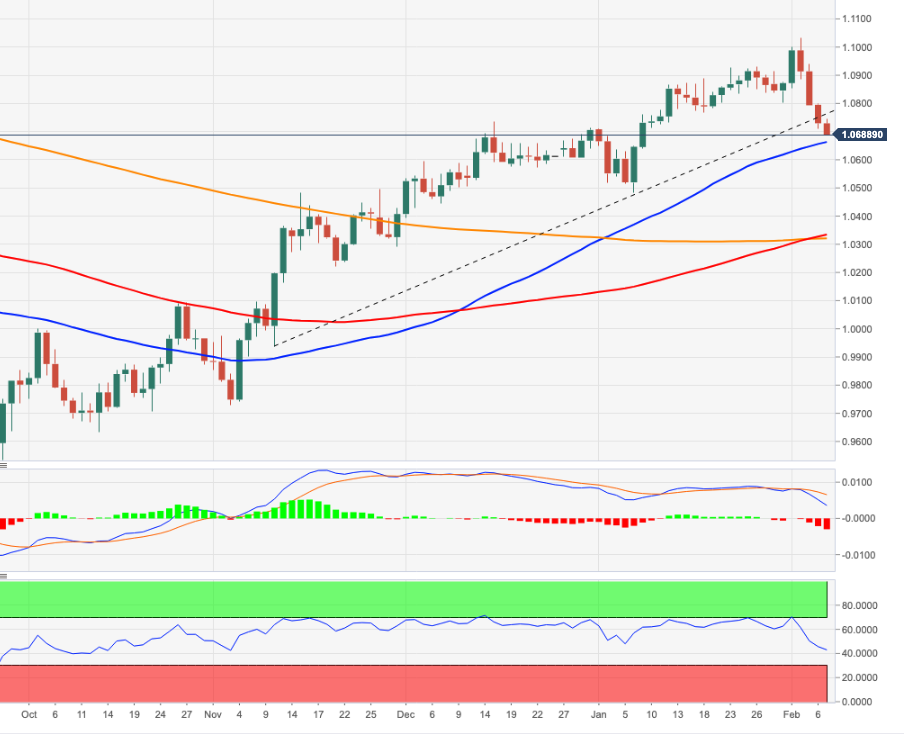- Analytics
- News and Tools
- Market News
CFD Markets News and Forecasts — 07-02-2023
- EUR/GBP is aiming to extend gains after a recovery move as ECB policymakers favor one more 50 bps rate hike ahead.
- Preliminary German HICP is expected to escalate to 10.0% from the former release of 9.6% on an annual basis.
- UK Sunak considered a cabinet mini re-shuffle to split Shapps’s Department for Business, Energy, and Industrial Strategy.
The EUR/GBP pair has picked demand after dropping below the round-level cushion of 0.8900 in the early Tokyo session. The cross is aiming to extend its recovery as bets for more interest rate hikes by the European Central Bank (ECB) in its upcoming monetary policy are mounting vigorously.
Annual inflation in Eurozone has softened significantly to 8.5% as the European Central Bank (ECB) is continuously hiking interest rates. Supply chain disruptions are easing now along with energy prices. Despite a win-win situation for the Eurozone inflation, ECB President Christine Lagarde is expected to remain hawkish ahead.
Isabel Schnabel, a Member of the European Central Bank (ECB)’s Executive Board, wrote in a press release entitled, 'Monetary policy in times of pandemic and war' that inflation momentum remains ‘quite elevated,‘ but cannot give all clear on inflation yet and that the ECB Intends to raise rates by 50bps in March.
For guidance on Eurozone inflation, ECB policymaker Francois Villeroy de Galhau said on Tuesday that the Eurozone was not very far from the peak of inflation, as reported by Reuters. He further added "I don't think we have to choose between fighting inflation and avoiding a recession,"
On Wednesday, investors will keenly focus on the German inflation data. The preliminary German Harmonized Index of Consumer Prices (HICP) (Jan) is expected to escalate to 10.0% from the former release of 9.6%.
Meanwhile, Pound Sterling is likely to dance to the headlines of a mini cabinet re-shuffle by United Kingdom PM Rishi Sunak after completing his stressed 100 days of work. Sunak will appoint a new Conservative Party chair, after he sacked Nadhim Zahawi over a tax scandal more than a week ago, as part of a wider overhaul, officials told Cabinet ministers Monday, as reported by Bloomberg.
- WTI grinds higher after crossing one-week-old resistance line.
- Unimpressive oscillators, 50-DMA challenges Oil bulls ahead of the key 100-DMA hurdle.
- Pullback remains elusive below $75.60 support confluence, $73.00-72.50 region appears a tough nut to crack for bears.
WTI crude oil struggles to extend the previous day’s stellar run-up around the weekly top, making rounds to $77.70-60 during early Wednesday. In doing so, the black gold seesaws around the 50-DMA amid sluggish RSI (14) and MACD signals.
It’s worth noting, however, that Tuesday’s upside break of a one-week-long descending trend line keeps WTI bulls hopeful.
Hence, a clear upside break of the 50-DMA hurdle, currently around $77.80, appears necessary for the WTI bulls to keep the reins.
Even so, the 100-DMA and a two-month-old descending resistance line, respectively around $80.90 and $82.70, could challenge the Oil buyers before giving them control.
That said, the 61.8% Fibonacci retracement level of the commodity’s November-December 2023 downturn near $84.30, also known as the “Golden Ratio”, acts as the last defense of the Oil bears.
Meanwhile, the resistance-turned-support line joins the 23.6% Fibonacci retracement to highlight $75.60 as the key support confluence for WTI bears to watch for taking entries.
Following that, a horizontal area comprising multiple levels marked since early December 2022, near $73.00-72.50, will be crucial as a break of which can quickly drag the prices toward late 2022 low near $70.30.
Overall, Oil buyers need to wait for a clear sign but the bears are clearly off the table.
WTI: Daily chart
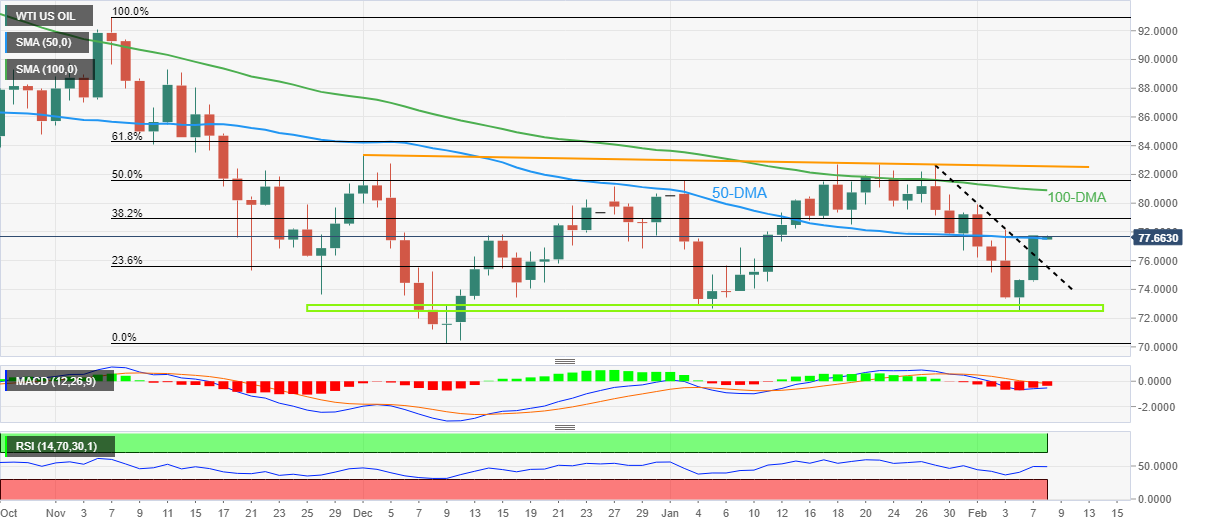
Trend: Sideways
Morgan Stanley upwardly revised its Federal Reserve (Fed) rate forecasts after Fed Chair Jerome Powell’s speech.
The investment bank unveiled a 0.25% rate hike expectation for the March meeting after a strong US jobs report on Friday, before conveying hopes of 25 basis points (bps) Fed rate hike in May following Powell’s speech.
The same brings Morgan Stanley’s expectation for the peak rate to 5.00% to 5.25% as per the latest forecasts.
It should be noted, however, that Fed’s Powell showed hesitance in praising the latest jump in the US Nonfarm Payrolls (NFP) during the latest appearance while asked the same of being a force to the Fed's benchmark interest rate higher than the 5% to 5.25% range currently anticipated. The same suggests a pause in the Fed rate after currently priced-in two rate hikes worth 0.25%.
Also read: Fed's Powell: Jobs report was strong, need to do further interest rate increases
- AUD/JPY remained sideways for the fourth consecutive day, unable to register new daily highs/lows.
- AUD/JPY Price Analysis: In the short term, downward biased, and it can test the 90.00 figure.
As the Asian session begins, the AUD/JPY trims some of Tuesday’s losses, though it remains trapped within the 20 and 50-day Exponential Moving Averages (EMAs), each at 91.10 and 91.27, respectively. Tuesday’s session was volatile, with the AUD/JPY reaching a weekly high of 91.93 before collapsing toward the day’s low on an intervention in the FX markets by Japanese authorities. The AUD/JPY is trading at 91.22, registering minimal gains of 0.07%.
AUD/JPY Price Analysis: Technical outlook
After Tuesday’s session, the AUD/JPY shifted neutral, with most of the Exponential Moving Averages (EMAs) staying at around 91.10-91.87. However, the AUD/JPY pair is slightly tilted to the downside since consolidating on January 26, recording successive series of lower highs/lows, meaning that in the near term, the AUD/JPY pair is downwards.
Hence, the AUD/JPY first support would be the 20-day EMA at 91.10. A breach of the latter would expose the 91.00 psychological level, which, once cleared, might send the pair diving towards the February 3 swing low at 90.34.
As an alternate scenario, the AUD/JPY supply zone would be the 50-day EMA at 91.27. Moving upwards from that level and the AUD/JPY would test the 200-day and 100-day EMAs, each at 91.52 and 91.86, respectively. Once broken, the 92.00 figure is up for grabs.
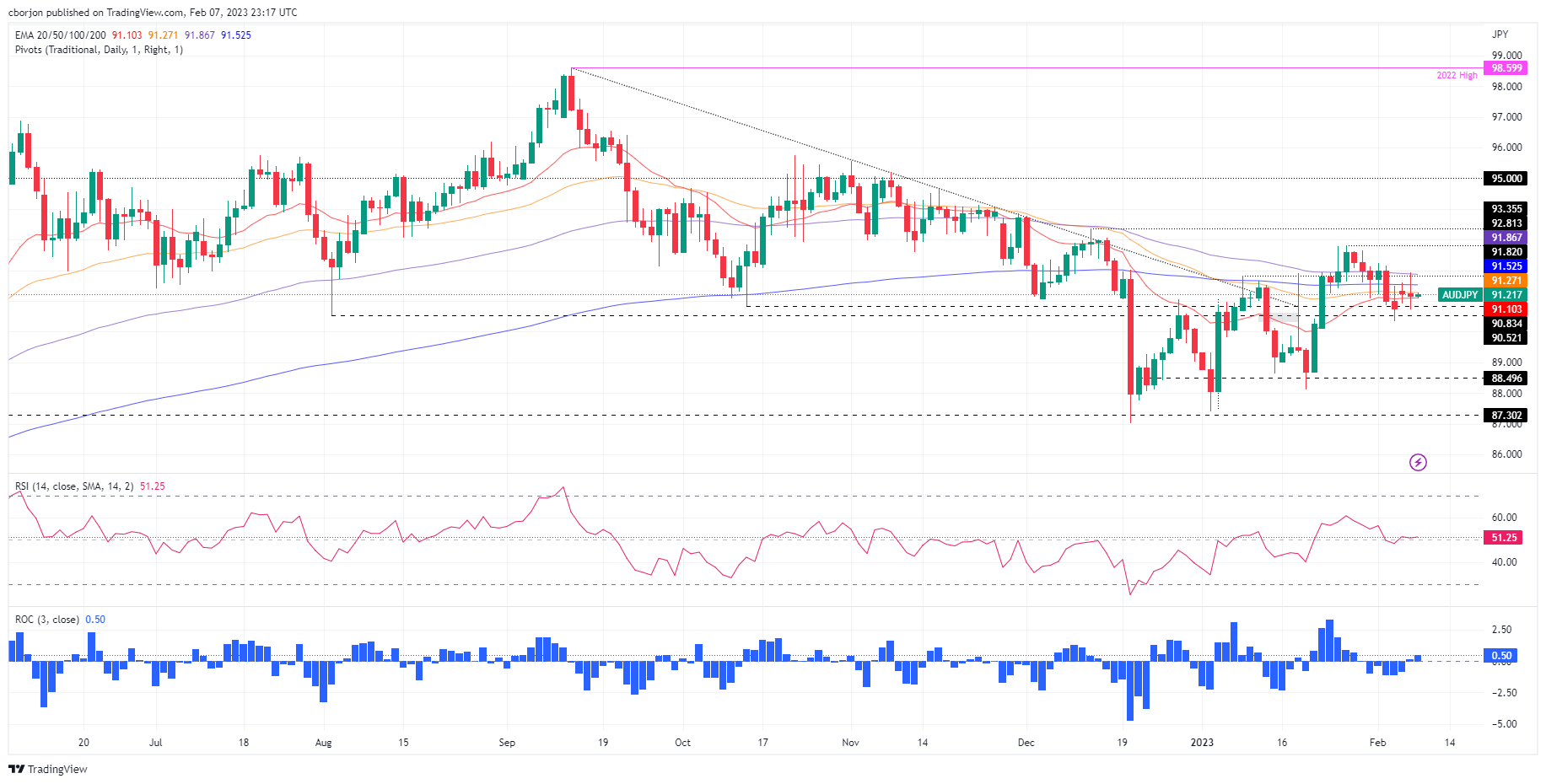
AUD/JPY Key Technical Levels
- GBP/USD picks up bids to defend the previous day’s rebound from one-month low.
- UK Prime Minister Rishi Sunak reshuffled British Cabinet on Tuesday but gained little accolades.
- Fed Chair Powell sounds mixed despite signaling higher rates.
- US President Joe Biden’s SOTU, risk catalysts are the key.
GBP/USD holds onto the previous day’s recovery moves near 1.2050 during Wednesday’s initial Asian session, despite the pause in the US Dollar’s weakness and sluggish markets. The reason could be linked to the fresh optimism surrounding the UK Prime Minister Rishi Sunak’s Cabinet reshuffle and mixed comments from the Federal Reserve (Fed) officials.
UK PM Sunak broke the British Cabinet into two departments to justify his pledge to bolster the economy and reduce energy prices, not to forget defending the Tory party's interest before the anticipated election in the next year. “Sunak created a new energy security and net zero department, led by former business minister Grant Shapps, and three other departments, with one focusing on science and innovation, a personal passion for the British leader,” said Reuters while giving details of the action.
On the other hand, Minneapolis Federal Reserve (Fed) President Neel Kashkari told CNN, "We may have to hold rates at a higher level for longer," while adding that he is not forecasting a recession. Following that, Federal Reserve Chairman Jerome Powell said, “Expect 2023 to be a year of significant declines in inflation,” while also adding that if data were to continue to come in stronger than expected, would certainly raise rates more.
Elsewhere, China’s rejection of the Pentagon request keeps the geopolitical tension high and the British workers’ strikes are also keeping the GBP/USD pressured despite the Bank of England (BOE) officials’ hawkish comments of late.
Amid these plays, Wall Street closed on the positive side but the US 10-year Treasury bond yields print a three-day uptrend to refresh a one-month high of around 3.68%.
Moving on, a light calendar may help the GBP/USD pair to defend the latest rebound. However, the US-China tension, the UK’s labor problems and the State of the Union (SOTU) speech from United States President Joe Biden will be crucial for immediate direction.
Technical analysis
Tuesday’s bullish spinning top candlestick defends GBP/USD buyers unless the quote breaks the 200-DMA support surrounding 1.1950 by the press time.
- A confirmation of more interest rate hikes by the Fed has strengthened the US Treasury yields.
- NZD/USD has scaled above 61.8% Fibo retracement after a bullish reversal supported by the double bottom formation.
- The RSI (14) has shifted into the 40.00-60.00 zone from the bearish range, which adds to the bullish reversal filters.
The NZD/USD pair is displaying topsy-turvy moves in the early Asian session after rebounding from 0.6290 on Tuesday. The Kiwi asset is expected to extend its recovery towards the critical resistance of 0.6360 as the market mood is cheerful after investors shrugged off volatility inspired by the hawkish speech from Federal Reserve (Fed) chair Jerome Powell.
S&P500 witnessed stellar buying interest as investors were already expecting a continuation of policy tightening by the Fed to tame higher inflation. The US Dollar Index (DXY) has surrendered the 103.00 support as investors shunned the risk aversion theme. However, the confirmation of more interest rate hikes by the Fed accelerated return from 10-year US Treasury bonds to 3.68%.
NZD/USD has formed a Double Bottom chart pattern on a three-hour scale after dropping below the 61.8% Fibonacci retracement (placed from January 6 low at 0.6190 to February 2 high at 0.6538) at 0.6327. The aforementioned chart pattern plotted around 0.6272 indicates a bullish reversal amid the absence of significant selling interest while testing previous lows. A bullish reversal after testing previous lows has pushed the Kiwi asset above 61.8% Fibo retracement again.
The Kiwi asset is still below the 20-period Exponential Moving Average (EMA) at 0.6400, indicating that the upside bias is still not in the picture.
However, a range shift by the Relative Strength Index (RSI) (14) into the 40.00-60.00 zone from the bearish range of 20.00-40.00 adds to the bullish reversal filters.
For an upside move, the New Zealand Dollar is required to push the asset above the 50% Fibo retracement placed at 0.6364, which will drive the asset toward January 9 high at 0.6412 followed by January 25 low around 0.6450.
On the flip side, a breakdown below February 6 low at 0.6270 will drag the asset toward December 22 low at 0.6230. A slippage below the latter will expose the Kiwi for more downside toward January 6 low at 0.6190.
NZD/USD three-hour chart
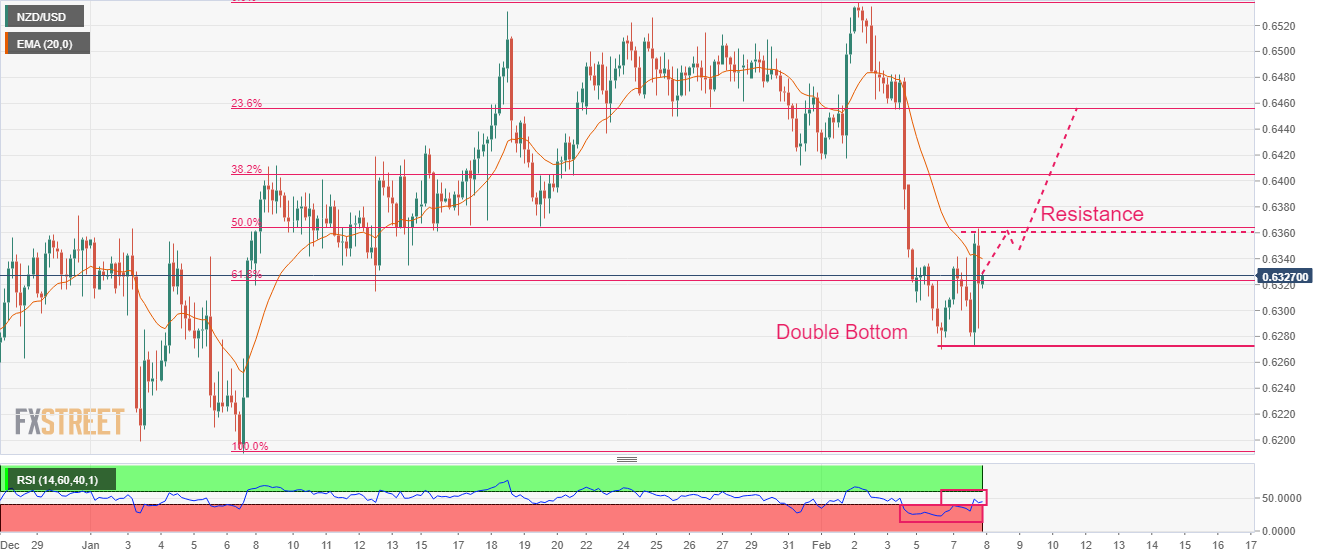
- Gold price stays pressured below short-term key Simple Moving Average.
- Federal Reserve officials sound hawkish during their latest appearances.
- United States Treasury bond yields weigh on XAU/USD despite US Dollar retreat.
- US President Joe Biden’s speech will be eyed to gauge immediate directions of Gold price.
Gold price (XAU/USD) stays defensive around $1,870, after the last two days’ failed attempt to rebound from $1,860, as market sentiment stays sluggish amid mixed signals from the Federal Reserve and the geopolitical front. Adding confusion to the metal traders’ minds could be the lack of major data/events. Even so, the bullion remains on the bear’s radar as the United States Treasury bond yields remain firmer.
Federal Reserve officials keep Gold bears hopeful
The Federal Reserve (Fed) officials managed to praise the recent upbeat data from the United States even as their tone appears mixed, which in turn exerts downside pressure on the Gold price. The same joins sluggish market sentiment and the previous week’s dovish Fed hike to probe the XAU/USD bears.
On Tuesday, Minneapolis Federal Reserve (Fed) President Neel Kashkari told CNN, "We may have to hold rates at a higher level for longer," while adding that he is not forecasting a recession.
Following that, Federal Reserve Chairman Jerome Powell said, “Expect 2023 to be a year of significant declines in inflation,” while also adding that if data were to continue to come in stronger than expected, would certainly raise rates more.
United States-China tension also weighs on XAU/USD
Apart from the Fed talks, the latest tension between the United States and China also please the Gold bears. Although US President Joe Biden tried placating the fears of another round of Sino-American tussles by saying, “The balloon incident does not weaken US-China relations,” China’s rejection of the Pentagon request keep the geopolitical tension high and tease XAU/USD sellers. “China has declined a US request for a phone call between U.S. Defense Secretary Lloyd Austin and Chinese Defense Minister Wei Fenghe,” a Pentagon spokesman said on Tuesday reported Reuters.
Treasury yields cheer easing fears of US recession and tease Gold sellers
It’s worth noting that the United States Treasury bond yields remain firmer, even if the US Dollar retreats of late. The reason could be linked to the comments from US Treasury Secretary Janet Yellen and President Joe Biden which pushed back the US recession concerns, as well as slightly hawkish Federal Reserve comments. Also underpinning the US bond yields, as well as weighing on the Gold price, are mixed talks from the rest of the world's central bank officials.
That said, the US 10-year Treasury bond yields print a three-day uptrend to refresh a one-month high of around 3.68% while the US Dollar Index (DXY) eases from its monthly peak to 103.35 as of late.
Central banks favor Gold buyers
It’s worth noting that the global central banks seek solace in Gold buying, despite the aforementioned negative catalysts. As a result, the latest revised World Gold Council (WGC) update states, “Following a correction to the historical data from 1950-1969, Gold Demand Trends has been amended to report that 2022 was a record year for annual central bank buying. Previously, 2022 had been reported as the second-highest year on record.”
US President Joe Biden’s speech eyed
Although the aforementioned mixed signals and firmer yields weigh on Gold prices, the traders lack clear directions and hence today’s State of the Union (SOTU) speech from United States President Joe Biden will be crucial for immediate direction. Ahead of the 02:00 AM GMT release, Reuters said, “US President Joe Biden will face Republicans who question his legitimacy and a public concerned about the country's direction in Tuesday's State of the Union speech that is expected to serve as a blueprint for a 2024 re-election bid.”
US President Biden’s SOTU will be closely observed for the Sino-American tussles and could weigh on the Gold price in the case that appears tough.
Gold price technical analysis
Gold’s failure to cross the 200-bar Simple Moving Average (SMA), despite bouncing off $1,860, portrays the underlying momentum weakness for the commodity.
That said, the gradual rebound in the Relative Strength Index (RSI), placed at 14, joins mildly bullish signals from the Moving Average Convergence and Divergence (MACD) indicator to challenge the XAU/USD bears.
As a result, the metal sellers seem to wait for a clear break of $1,860 to confirm further downside of the Gold price.
Even so, an upward-sloping support line from mid-December 2022, close to $1,850 at the latest, may act as an extra filter toward the south before directing the XAU/USD bears toward the $1,800 threshold. Though, seven-week-old horizontal support near $1,825 may act as an intermediate halt.
Meanwhile, the Gold price rebound needs validation from the 200-SMA, around $1,883 by the press time, as well as the $1,900 to recall the buyers.
Following that, the $1,930 and the $1,945 levels may probe the XAU/USD bulls before directing them to the recent high near $1,960 and a three-week-old ascending resistance line, around $1,970 as we write.
Overall, the Gold price remains on the bear’s radar even as the road toward the south appears bumpy.
Gold price: Four-hour chart

Trend: Further weakness expected
- The EUR/JPY cut last Friday’s gains, dropping towards the 200-day EMA, as sellers target 140.00 and below.
- EUR/JPY Price Analysis: The pullback towards the 200-DMA might pave the way for a deeper correction before resuming the uptrend.
EUR/JPY continued to trade lower for two consecutive days, retracing most of last Friday’s gains, and reclaimed the 50 and 20-day Exponential Moving Averages (EMAs), on its way south. The Euro’s (EUR) collapse was capped by the trend-setter 200-day EMA at 140.30, though it would likely remain under pressure. At the time of writing, the EUR/JPY is trading at 140.52, with losses of 1.20%, as Tuesday’s session ends.
EUR/JPY Price Analysis: Technical outlook
The EUR/JPY shifted to neutral from neutral-upwards, according to the daily chart, following Tuesday’s fall beneath essential demand zones. In addition, the EUR/JPY pair could turn neutral downwards as the spot price hovers nearby the 200-day EMA, which, once cleared, could pave the way for further losses.
The Relative Strength Index (RSI) and the Rate of Change (RoC) supported the above-mentioned scenario, meaning that in the short term, the EUR/JPY might pull back before resuming its uptrend.
Therefore, the EUR/JPY first support would be the 200-day EMA at 140.30. A breach of the latter will send the pair sliding towards the 140.00 figure, which, once cleared, the EUR/JPY might fall toward the January 20 daily low of 139.03.
As an alternate scenario and the current trend, the EUR/JPY first resistance would be the 20-day EMA at 141.03. A break of that supply zone and the EUR/JPY might rally toward the psychological 142.00 area followed by the February 7 high fo 142.33.
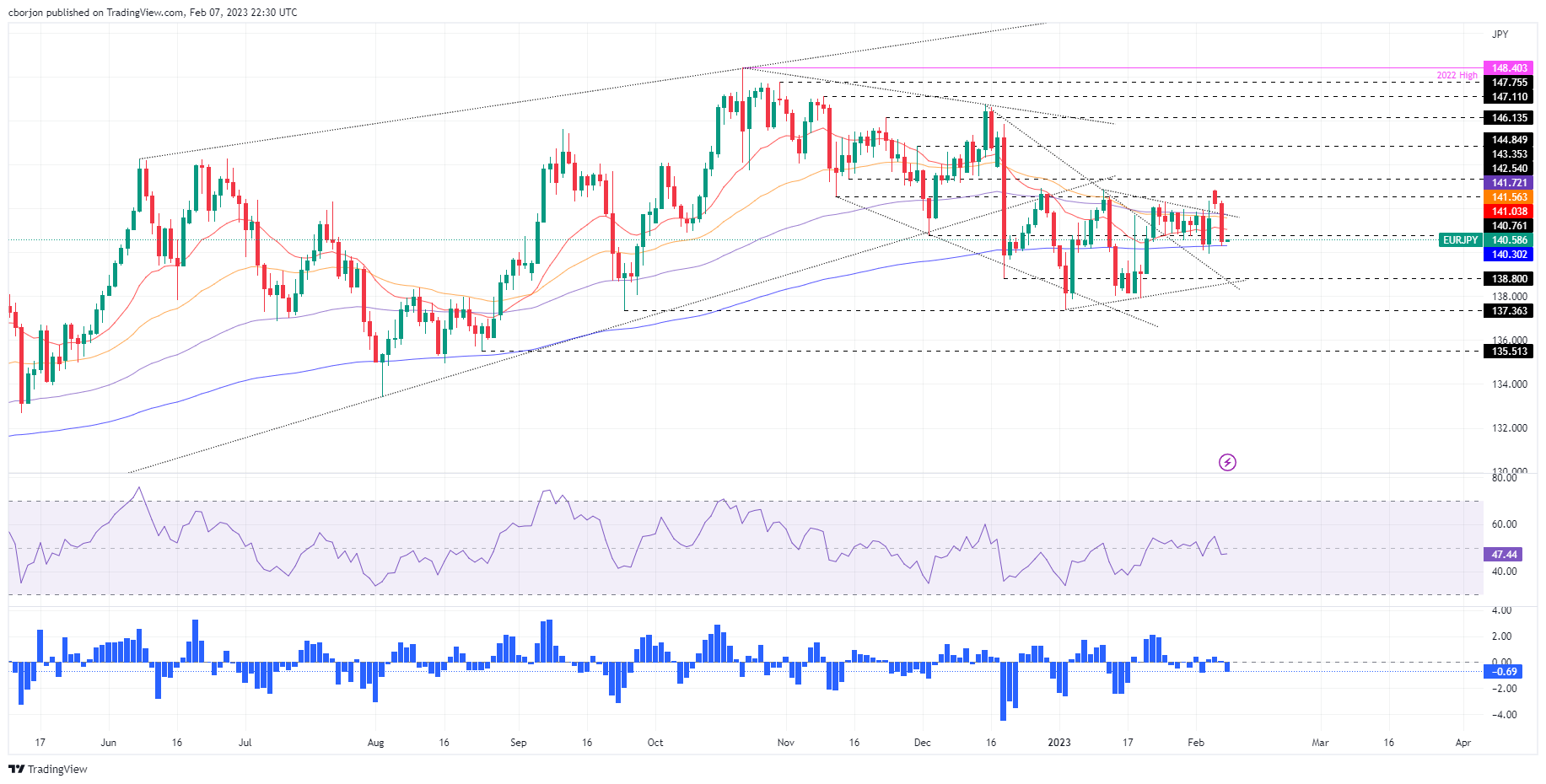
EUR/JPY Key Technical Levels
- USD/CAD has slipped below the 20-period EMA amid risk-on mood and the higher oil price.
- Fed Powell’s hawkish commentary failed to infuse blood into the safe-haven assets.
- A Fakeout of the Falling Channel pattern has trimmed demand for the US Dollar.
The USD/CAD pair has dropped vertically below the crucial support of 1.3400 in the early Tokyo session. The Loonie asset is facing immense pressure amid a decline in the US Dollar Index (DXY) and a sheer recovery in the oil price. The USD Index showed immense volatility despite Federal Reserve (Fed) chair Jerome Powell favors for a continuation of interest rate hikes after a stronger-than-expected January United States Nonfarm Payrolls (NFP) report.
Risk-perceived assets like S&P500 settled Tuesday’s session on a bullish note supported by tech-savvy stocks, portraying that the risk appetite theme is in traction. The alpha generated by 10-year US Treasury bonds has surged to near 3.68%.
USD/CAD sensed the presence of sheer selling pressure after an attempt of delivering a breakout of the Falling Channel chart pattern on a two-hour scale. The formation of a Fakeout pushed the asset below the 20-period Exponential Moving Average (EMA) around 1.3414, which indicates that the short-term trend is bearish.
The Relative Strength Index (RSI) (14) has shifted into the 40.00-60.00 range from the bullish range of 60.00-80.00, which indicates that the bullish view has been negated for now.
The bullish view for the US Dollar was negated after a failure in delivering a Falling Channel breakout, which has exposed the loonie for a downside till January 3 low at 1.3321 and February 2 low at 1.3262 as the asset has slipped below the round-level support of 1.3400.
In an alternative scenario, a break Above February 7 high at 1.3469 will drive the asset toward January 19 high at 1.3521 followed by January 6 low at 1.3538.
USD/CAD two-hour chart
-638114057321041780.png)
“China has declined a US request for a phone call between U.S. Defense Secretary Lloyd Austin and Chinese Defense Minister Wei Fenghe,” a Pentagon spokesman said on Tuesday reported Reuters.
Brigadier General Patrick Ryder also stated, per Reuters, “The Pentagon submitted the request for a secure call on Saturday, immediately after shooting down a suspected Chinese surveillance balloon off the coast of South Carolina.”
"Unfortunately, the PRC (People’s Republic of China) has declined our request. Our commitment to open lines of communication will continue," Ryder added.
On the same line was news from Reuters saying, “The US Coast Guard on Monday imposed a temporary security zone in waters off South Carolina during the military's search for debris from a suspected Chinese spy balloon shot down by a US fighter jet, and the White House said it would keep a calm approach to relations with Beijing.”
Market implications
Following the news, AUD/USD retreats from 0.6960 while paring the Reserve Bank of Australia (RBA) inspired gains, last seen around 0.6950 during early Wednesday morning in Asia.
Also read: AUD/USD Price Analysis: Bulls at the ready for a test of 0.7020
- EUR/USD has shifted its business above 1.0700 despite hawkish Fed commentary.
- Fed’s Powell has given the green signal to policy tightening continuation amid a strong job report.
- ECB Schnabel has advocated for a 50 bps interest rate hike in March.
The EUR/USD pair has shifted its auction profile above the round-level resistance of 1.0700 in the early Asian session. The major currency pair rebounded firmly after dropping to near 1.0670. The recovery move in the shared currency pair is looking to extend its recovery above the immediate resistance of 1.0725 ahead.
The Euro has gained strength despite hawkish commentary by Federal Reserve (Fed) chair Jerome Powell. The US Dollar Index (DXY) dropped to near 102.70 after failing to sustain above the 103.50 resistance. S&P500 futures recovered firmly after terminating the two-day winning streak as the confirmation of further policy tightening by the Fed chair Jerome Powell was already anticipated by the market participants. Therefore, the speech from Fed Powell triggered the ‘Sell on Rumor and Buy on News’ indicator.
A sheer recovery in the 500-US stock basket is portraying an improvement in the risk appetite of the market participants. Meanwhile, the demand for US government bonds weakened further as the Fed will keep higher interest rates steady for a longer period along with more interest rate hikes. This led to a jump in the 10-year US Treasury yields to near 3.68%.
Fed Powell cited “The jobs report was certainly stronger than anyone expected and the strong jobs report shows you why we think that inflation taming will be a process that takes a significant period of time.”
On the Eurozone front, Isabel Schnabel, a Member of the European Central Bank (ECB)’s Executive Board, wrote in a press release entitled, 'Monetary policy in times of pandemic and war' that inflation momentum remains ‘quite elevated,‘ but cannot give all clear on inflation yet and that the ECB Intends to raise rates by 50bps in March.
There is no denying the fact that Eurozone inflation has slowed down significantly in the past two months and activities are also showing contraction. In spite of that, the road of a 2% inflation recovery is far from over, which bolsters the case of further interest rate hikes by the ECB.
- AUD/USD bulls look for a move to test 0.720 commitments.
- A first bullish day following a series of red days opens the risk of a move into the M-formaiton's neckline.
AUD/USD caught a bid on the back of US Federal Reserve Chair Jerome Powell who spoke on Tuesday and doubled down on statements last week that disinflation has started. He was however arguing that stronger data could lead to a higher terminal rate than what the market is currently pricing.
Nonetheless, the markets were released that there was nothing uber dovish in his comments following a blockbuster Nonfarm Payrolls outcome from Friday's data. Subsequently, the stock market rallied and the high beta currencies, such as the Aussie, benefitted as Powell expects declines in inflation this year. Consequently, the following analysis is based on a bullish bias with both technicals and fundamentals aligning:
AUD/USD daily chart

The daily chart's daily M-formation leaves the scope for a move to head into the M-formaiton's neckline in a 50% mean reversion to test the 0.70s with the 61.8% ratio eyed higher up in the 0.7020s.
AUD/USD H4 chart
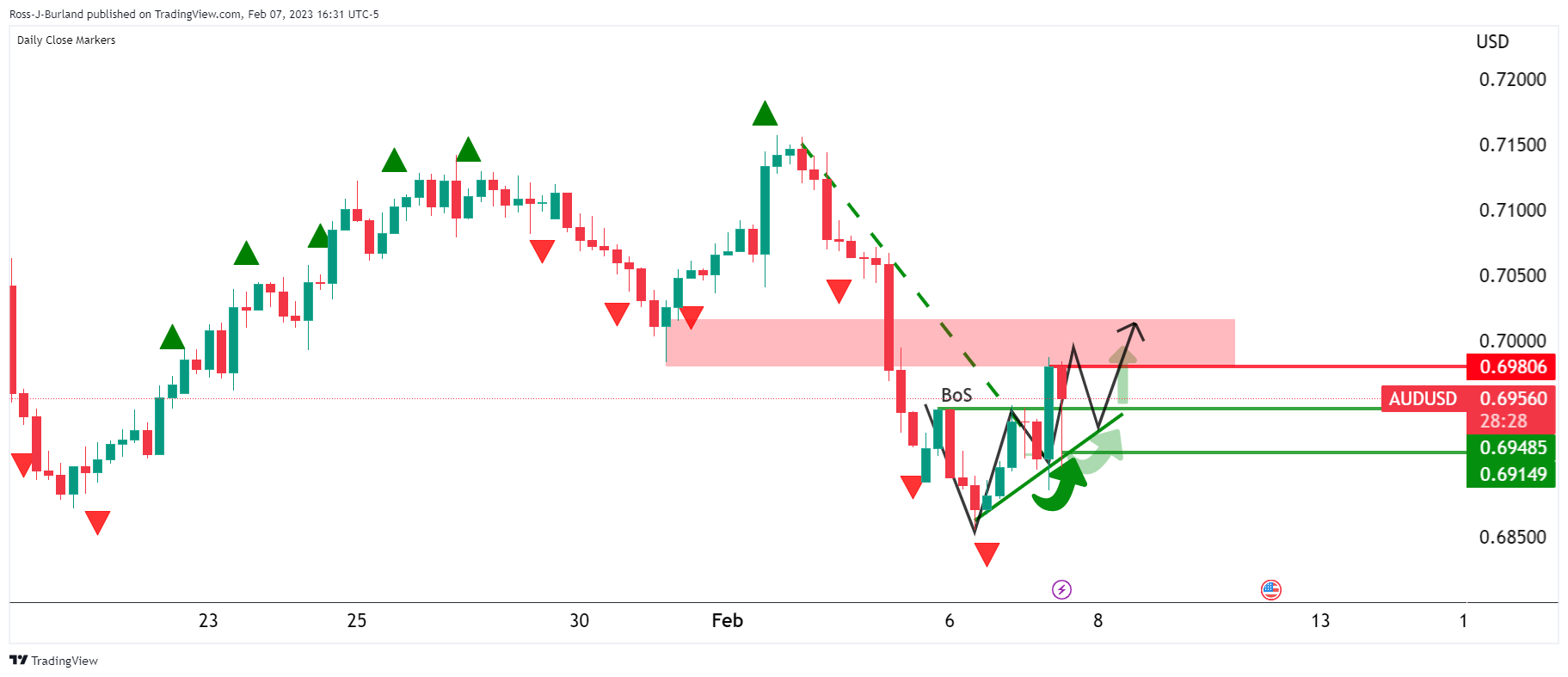
The W-formation on the 4-hour chart is a meanwhile bearish pattern that leaves the dynamic support structure vulnerable to a restest. However, the day is headed for a bullish close which puts the directional bias for the day ahead to the upside following three bear closes as signified by the red arrows.
AUD/USD H1 chart
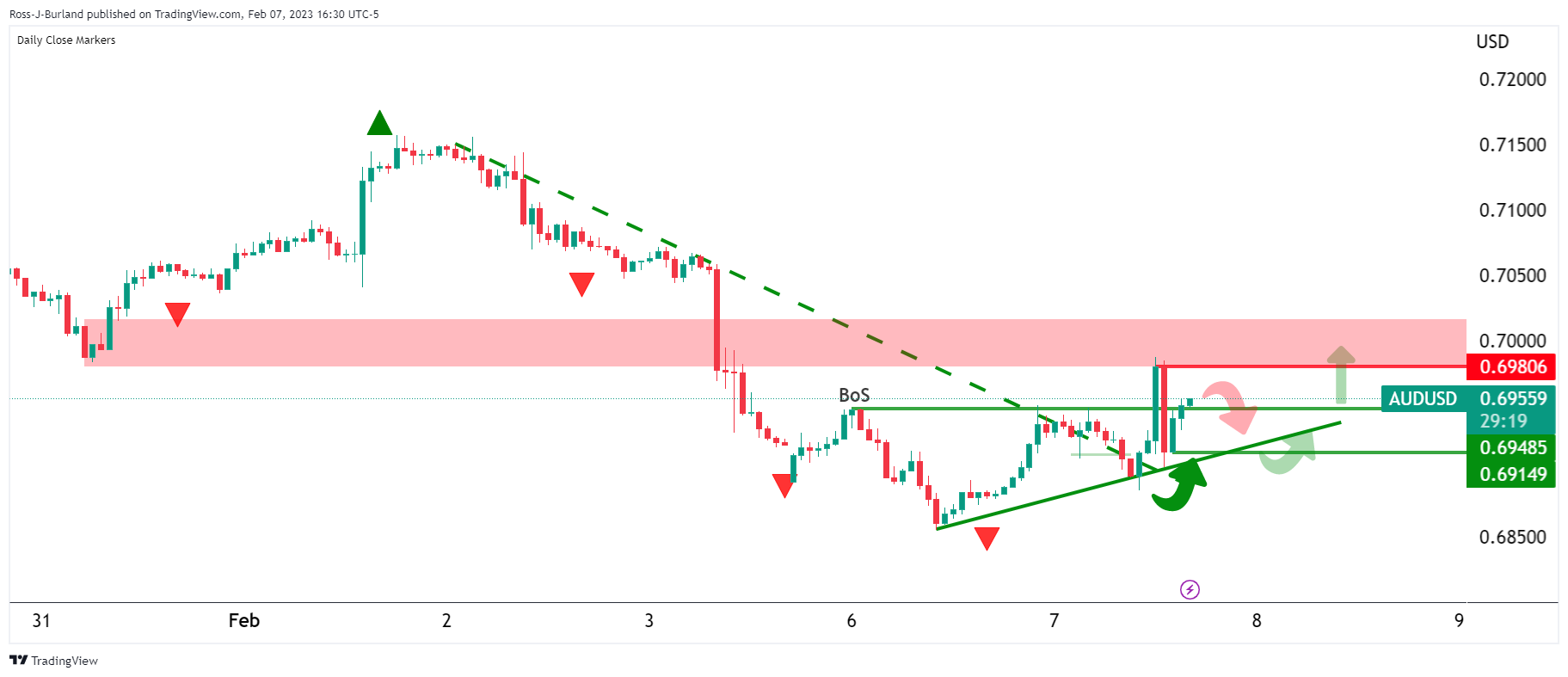
The hourly chart shows that the price is riding the trendline support with eyes on the 0.6980s and then a test of the 0.70s for the day ahead. This thesis is founded on the basis that we are about to correct towards the daily M-formaiton's neckline as illustrated above. The price is now on the backside of the prior bearish leg and has also broken the structure of 0.6950 or thereabouts.
- USD/CHF will likely remain pressured following Powell’s “neutral” speech.
- USD/CHF Price Analysis: Downward biased, but it could print a leg-up once it clears the 50-day EMA.
USD/CHF slid from weekly highs and reached around 0.9290 after the US Federal Reserve (Fed) Chair Powell’s speech failed to push back against a perceived dovish rate hike, even though he acknowledged a strong US jobs report. At the time of writing, the USD/CHF exchanges hands at 0.9219, below its opening price.
USD/CHF Price Analysis: Technical outlook
The USD/CHF is resting at around the 20-day Exponential Moving Average (EMA) at 0.9217 as Wall Street’s session wanes. Failure to crack the latter would keep USD/CHF bulls hopeful for higher prices, but they will need to challenge the 50-day EMA at 0.9303 if they want to shift the bias to neutral upwards. In that outcome, the USD/CHF could aim higher and face the next supply zone at a downslope trendline drawn from December’s highs, which passes in the 0.9320-35 area. Once cleared, the 100-day EMA would be up for grabs at 0.9420.
For a resumption of the downtrend, the USD/CHF needs a break below the 20-day EMA and February 7 low of 0.9191. A breach of the latter will poise the USD/CHF pair towards the February 3 daily low of 0.9112, ahead of the 0.9100 figure.
Momentum indicators are beginning to show bearish signals, with the Relative Strength Index (RSI) crossing below the 50-mid line. The Rate of Change (RoC) portrays buying pressure is fading, strengthening the bearish outlook in the near term.
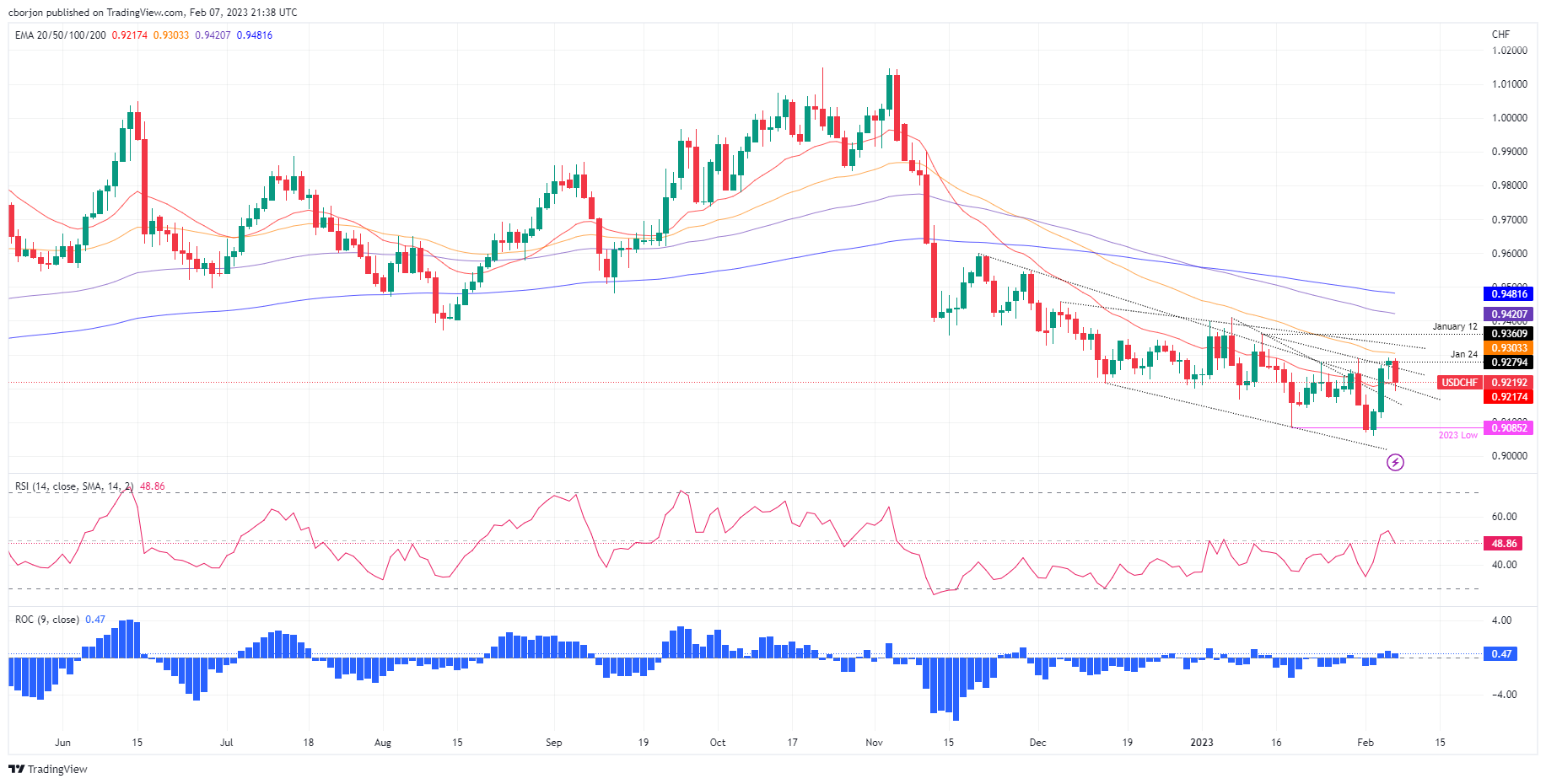
USD/CHF Key Technical Levels
- The Japanese Yen gained traction, as shown by the USD/JPY sliding 1% toward 131.10s.
- USD/JPY Price Analysis: On a pullback in the near-term, as bull’s eye, the 20-DMA
The USDJPY erased Monday’s gains and collapsed to the 131.00 area after hitting a week-high of 132.90. Intervention by Japanese authorities weakened the US Dollar (USD), giving way to a 140 pip drop. At the time of writing, the USD/JPY exchanges hand at 131.21, below its opening price by 1.08%.
USD/JPY Price Analysis: Technical outlook
From a daily chart perspective, the USD/JPY remains upward biased, even though it failed to crack Monday’s daily high and tumbled beneath the 20-day Exponential Moving Average (EMA) at 130.58. However, bulls stepped in around the latter, and the USD/JPY reclaimed the 131.00 figure, which could exacerbate a re-test of 132.00. Then, the USD/JPY next resistance would be the 50-day EMA at 132.84, ahead of the 200-day EMA at 133.85.
As an alternate scenario, the USD/JPY first support would be the 131.00 figure. Once broken, the 20-day EMA at 130.58 would be the following line of defense for USD/JPY bulls, followed by a move lower to the 130.00 psychological level.
Indicators portrayed a sideways scenario, with the Relative Strength Index (RSI), although remaining upward biased, about to turn bearish. Contrarily, the Rate of Change (RoC) suggests that buyers remain in control, albeit being outpaced by sellers on Monday.
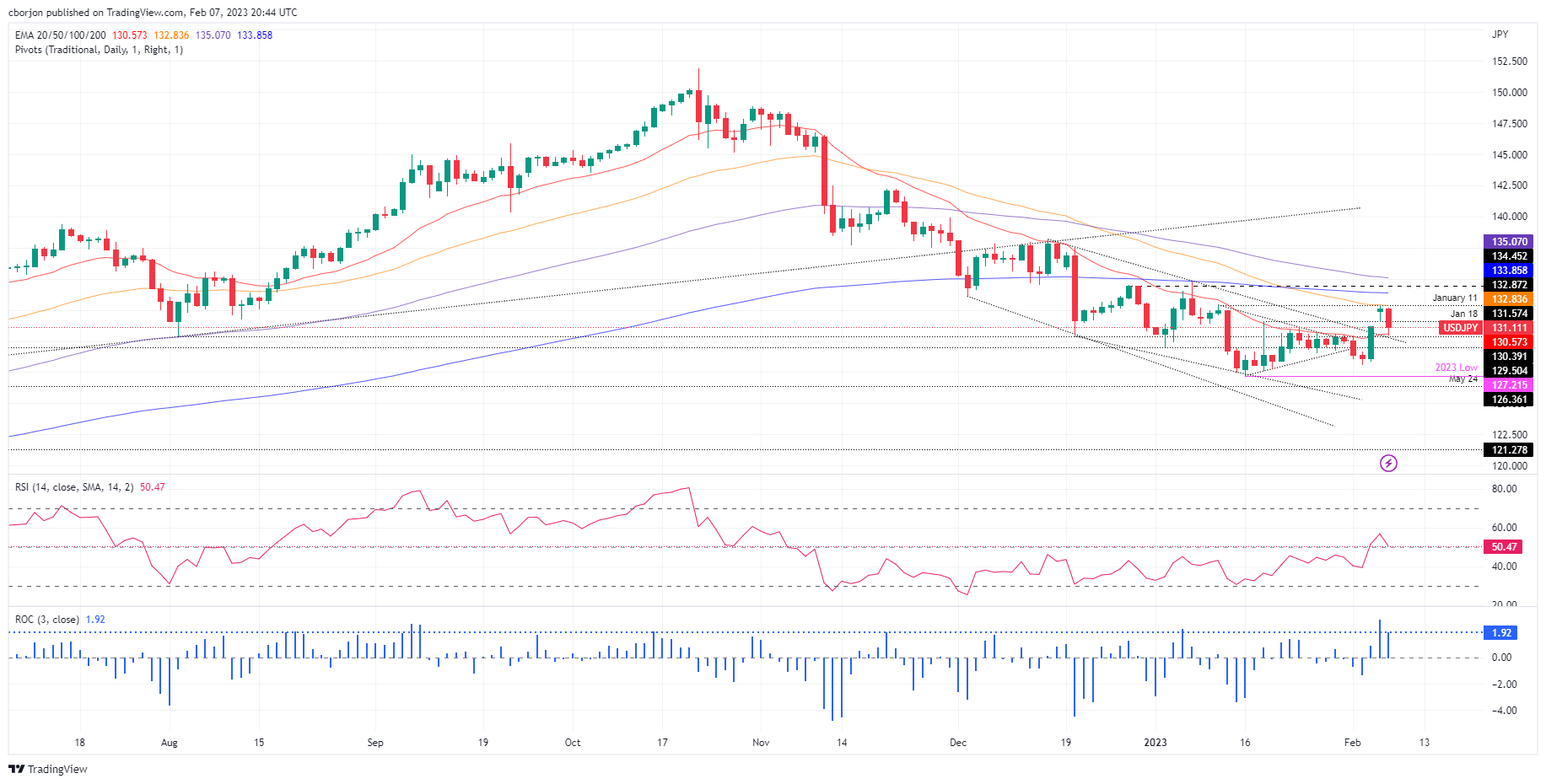
USD/JPY Key Technical Levels
- GBP/USD is setting the foundations for a bullish setup with the 1.2180s eyed in a 50% mean reversion target.
- A 38.2% Fibonacci retracement is located at 1.2195.
- Nevertheless, bears will be lurking considering the break of structure at 1.2090.
GBP/USD bulls moved in on Tuesday and are setting the foundations for a bullish correction of the recent slide from the 1.23s at the start of February. The following illustrates the bullish bias for the day ahead.
GBP/USD M15 chart
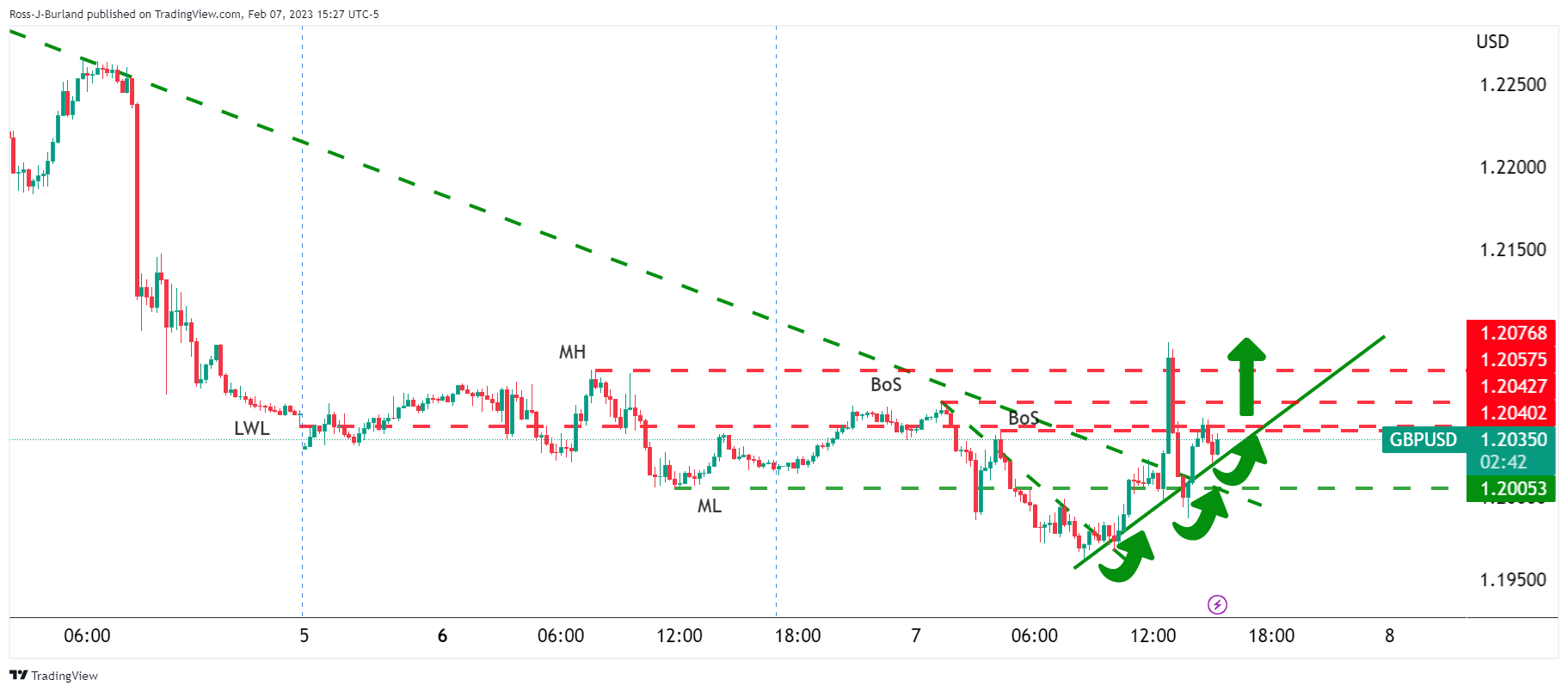
The price has rallied from a low of 1.1960 to a high of 1.2095, taking out Monday's high, MH, and breaking structures, BoS, along the way, The price has also moved to the backside of the prior bearish dynamic resistance, (bearish trendline), that would now be expected to act as a counter-trendline.
The breakout of these structures leaves the directional bias in favour of a meanwhile bullish correction on the daily chart for the day ahead, pending a bullish close on Tuesday:
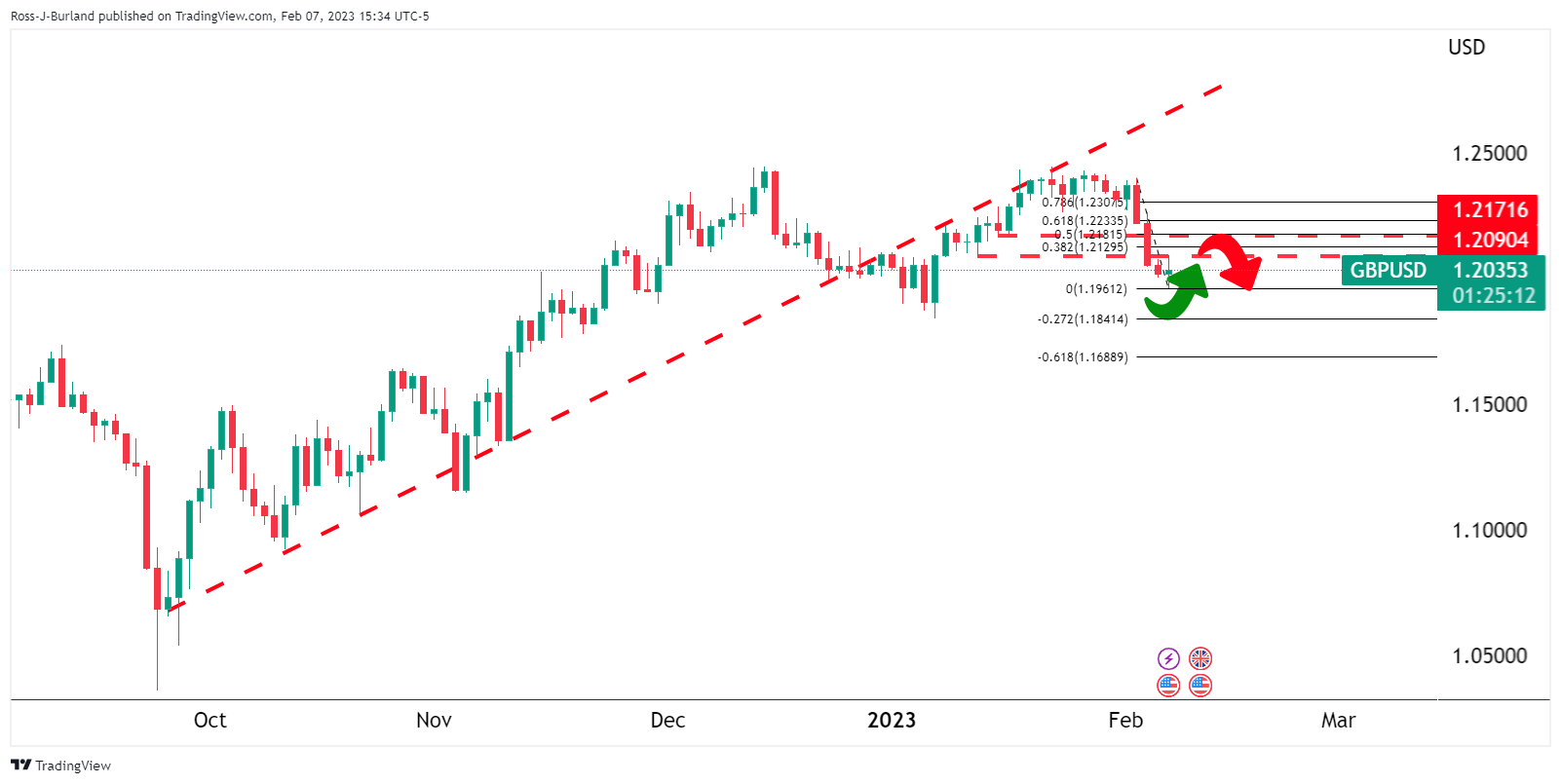
Zoomed in ...
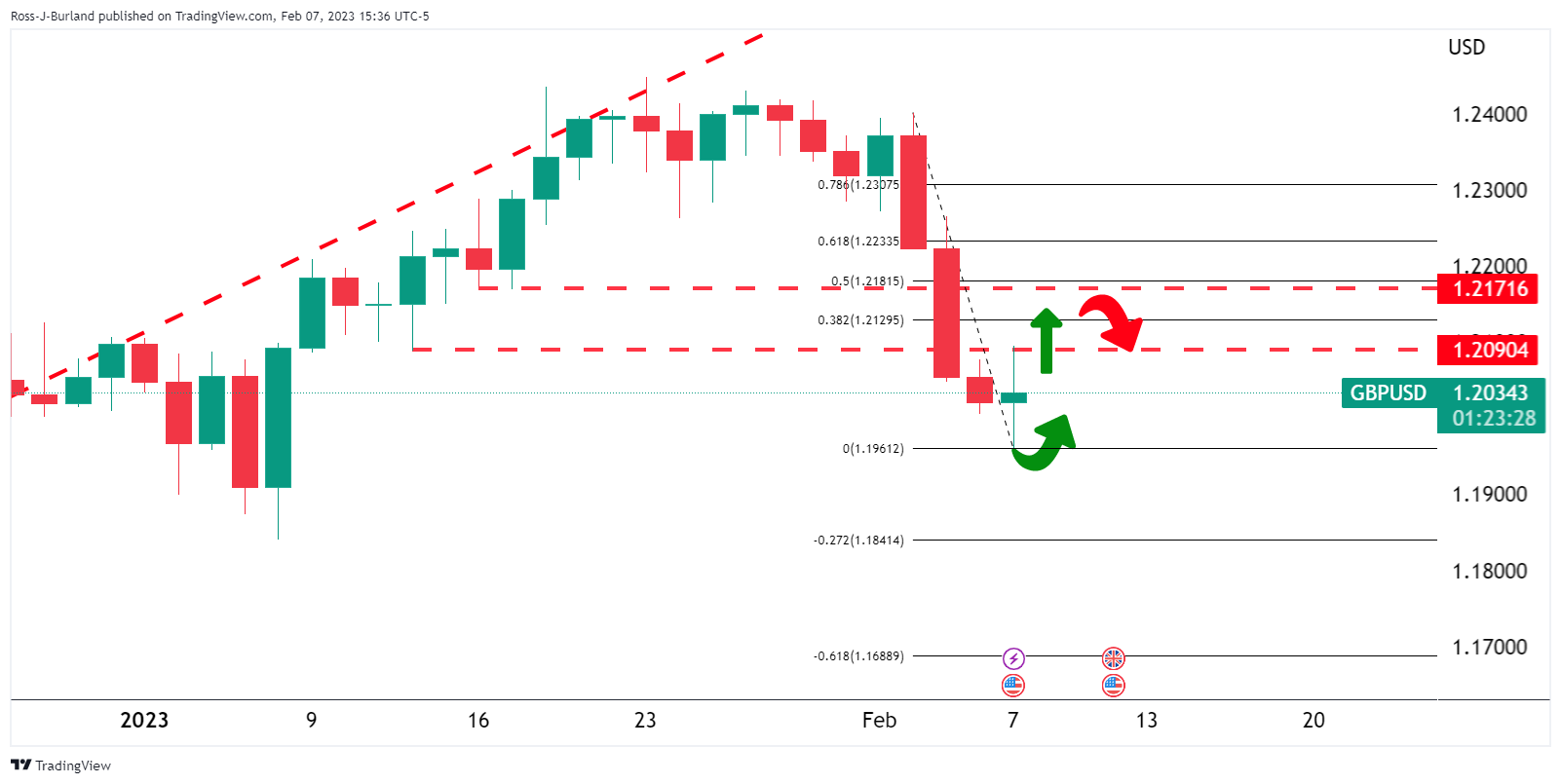
This leaves the foundations of a long trade for whichever session traders are in, looking for a bullish setup with the 1.2180s eyed in a 50% mean reversion target. On the way there, a 38.2% Fibonacci retracement is located at 1.2195. Nevertheless, bears will be lurking considering the break of structure at 1.2090.
What you need to take care of on Wednesday, February 8:
The US Dollar ended the day mixed across the FX board. The American currency extended its February rally throughout the first half of the day, but shed ground unevenly in the last trading session, as US Federal Reserve Chairman Jerome Powell participated in a moderated discussion at the Economic Club of Washington DC.
Federal Reserve Chair Jerome Powell started repeating his hawkish message, stating they would probably need to do further interest-rate increases adding that the process is going to be “bumpy.” The market welcomed the concept delivered by Powell that stronger than anticipated data will see the Fed raising rates accordingly. The US Dollar fell as Wall Street soared as an immediate reaction. Nevertheless, he then added that strong labor market report, or higher inflation reports will result in the Fed raising rates by more than what is currently priced in.
The USD recovered as stocks collapsed to fresh daily lows, but then again changed course and finished the day with substantial gains.
The Euro was the weakest USD rival, with the pair ending the day at around 1.0710. European Central Bank (ECB) policymaker Joachim Nagel said that ECB rate cuts are not on the agenda in the foreseeable future and noted that the central bank’s rates are not yet restrictive. He added that “more significant” hikes are needed. Additionally, Isabel Schnabel Member of the Executive Board of the ECB, said that she intends to raise rates by 50 bps in March.
GBP/USD battled to retain the 1.2000 mark, after falling to a fresh multi-week low of 1.1960.
The AUD/USD pair settled at around 0.6940, helped by the Reserve Bank of Australia. The RBA delivered a hawkish message while raising rates by 25 bps. Substantial gains in Wall Street provided additional support.
USD/CAD trades around 1.3410. Bank of Canada Governor Tiff Macklem said on Tuesday that no further rate hikes will be needed if, as expected, the economy stalls and inflation comes down.
USD/JPY finally closed the weekly opening gap, currently trading at 131.20.
Spot gold was unable to attract investors and consolidate in the $1,860/70 price zone.
Crude oil prices benefited from Wall Street’s rally, with WTI ending the day at $77.30 a barrel.
Top 3 Price Prediction: Bitcoin, Ethereum, Ripple: When all signs point north
Like this article? Help us with some feedback by answering this survey:
- NZD/USD could be headed for a deep bullish correction if they get above 0.6365.
- If the bulls hold the fort, we will be closing in the green for a second day putting the directional bias in favour of longs.
NZD/USD is up on the day with the US dollar still under pressure despite a hawkish tone from the Federal Reserve pertaining to the recent Nonfarm Payrolls data. Federal Reserve's chairman Jerome Powell said in comments day made at The Economic Club of Washington, D.C. Signature Event that he expects 2023 to be a year of significant declines in inflation.
The US Dollar fell during a slew of comments that gave something to both the bulls and the bears. However, the greenback bounced back when investors digested some of the more hawkish tones. Powell explained that the ‘base case is that it will take time and more rate increases to finish the process.
Nevertheless, the greenback remains on the back foot technically and the high beta currencies such as the Kiwi have enjoyed a bounce in US stocks on Tuesaday following a series of down days since the NFP report. The US economy added 517K jobs in January, the most since July and much more than market expectations of 185K. Following the release of the data on Friday, ISM services also pointed to a strong services sector, adding to concerns about persistent inflation and bolstering the case for more rate increases.
Meanwhile, the latest domestic data showed that New Zealand's Unemployment Rate edged up to 3.4% in the 4th quarter of 2022 from 3.3% in the 3rd quarter, bolstering bets that the central bank will shift to a less aggressive stance. NZ's annual inflation also came in below the Reserve Bank of New Zealand's 7.5% projection and investors now expect the RBNZ to downshift to a 50 basis point rate hike in February after delivering a record 75 basis point increase in November.
As for the direction for the Bird, analysts at ANZ Bank wrote in a note on Wednesday that they upgraded their NZD forecasts – ''we now see it reaching 0.65 in Q3, 0.67 in Q4, and 0.68 by the fourth quarter next year''.
NZD/USD technical analysis
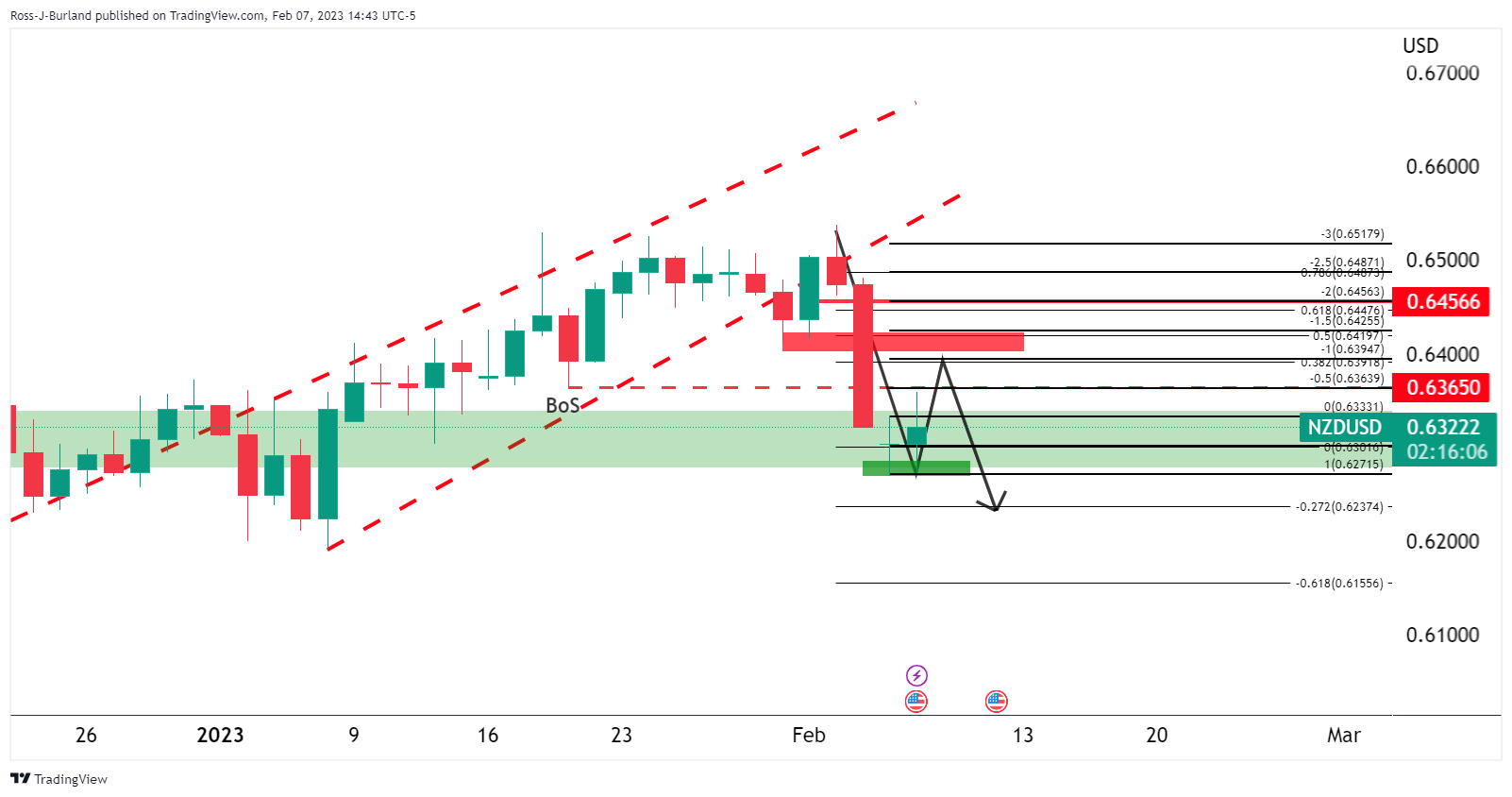
NZD/USD could be headed for a bullish correction given that it closed green on Monday, with prospects of a move into in-the-money shorts from Friday's selloff. We have a double bottom under last week's lows and bulls are moving in on those lows at around 0.6320.
If the bulls hold the fort, we will be closing in the green for a second day putting the directional bias in favour of longs for the sessions ahead. A 100% measured move of the current consolidation range has a confluence with the 38.2% Fibonacci near 0.6390. a break of 0.6400 opens the risk of a move to 0.6425 in a 50% mean reversion to near the prior lows 31 Jan lows. However, 0.6365 needs to give first as a prior Jan 19 support structure.
- Western Texas Intermediate got bolstered as the US Dollar weakens on soft US Fed Powell remarks
- China’s reopening and Turkey’s earthquake are one of the multiple factors underpinning oil prices.
- WTI Technical Analysis: Range-bound, but it could test $78.00 PB in the short term.
The US crude oil benchmark, also known as Western Texas Intermediate (WTI), advances sharply as the US Dollar (USD) weakens, as the US Federal Reserve (Fed) Chair Jerome Powell speaks at the Economic Club of Washington. At the time of writing, WTI is trading at $76.50 PB.
Wall Street turned green as Fed Chair Jerome Powell failed to pushback against the last week’s astonishing employment report in the United States (US), which spurred a market’s reaction, sending the US Dollar soaring and US Treasury bond yields jumping more than 20 bps, namely the 10-year benchmark note rate.
However, the US Dollar Index (DXY) is falling 0.35%, down at 103.264, sparking an upward reaction in WTI, hovering around the 20-day Exponential Moving Average (EMA) at $77.61.
Additional factors influencing oil prices are optimism about China’s reopening, and worries about supply shortages as a major export terminal in Turkey was shut down following an earthquake in the country.
China’s reopening following the relaxation of the Covid-19 zero-tolerance policy augmented speculations that oil demand would increase during 2023. Even the International Energy Agency (IEA) estimates that half of 2023 global oil demand will come from China.
Meanwhile, operations at Ceyhan, Turkey’s main oil export terminal, were shut after an earthquake hit the region. The terminal will remain closed until February 8.
WTI technical analysis
WTI is trading sideways after the US Federal Reserve Chair Jerome Powell finished its speech. It should be said that WTI broke to new daily highs of $77.11 on dovish remarks by Powell, weakening the US Dollar. Nevertheless, oil failed to gain traction and clear the 20-day EMA at $77.58, which could’ve exposed last Friday’s high at $77.96. Break above and the $78.00 figure is up for grabs.
On the flip side, WTI's first support would be $74.40, which, once cleared could pave the way for further downside.
Reuters reported that Bank of Canada Governor Tiff Macklem said on Tuesday that no further rate hikes will be needed if, as expected, the economy stalls and inflation comes down.
Key comments
"If new data are broadly in line with our forecast and inflation comes down as predicted, then we won't need to raise rates further," Macklem said in a speech to financial analysts in Quebec City.
"Inflation is turning the corner. Monetary policy is working," Macklem said, adding that economic growth would be "close to zero" through the third quarter of this year.
USD/CAD update
We are headed for an inside day as the US Dollar picks up a bid in the aftermath of the Federal Reserve's chairman Jerome Powell's comments:
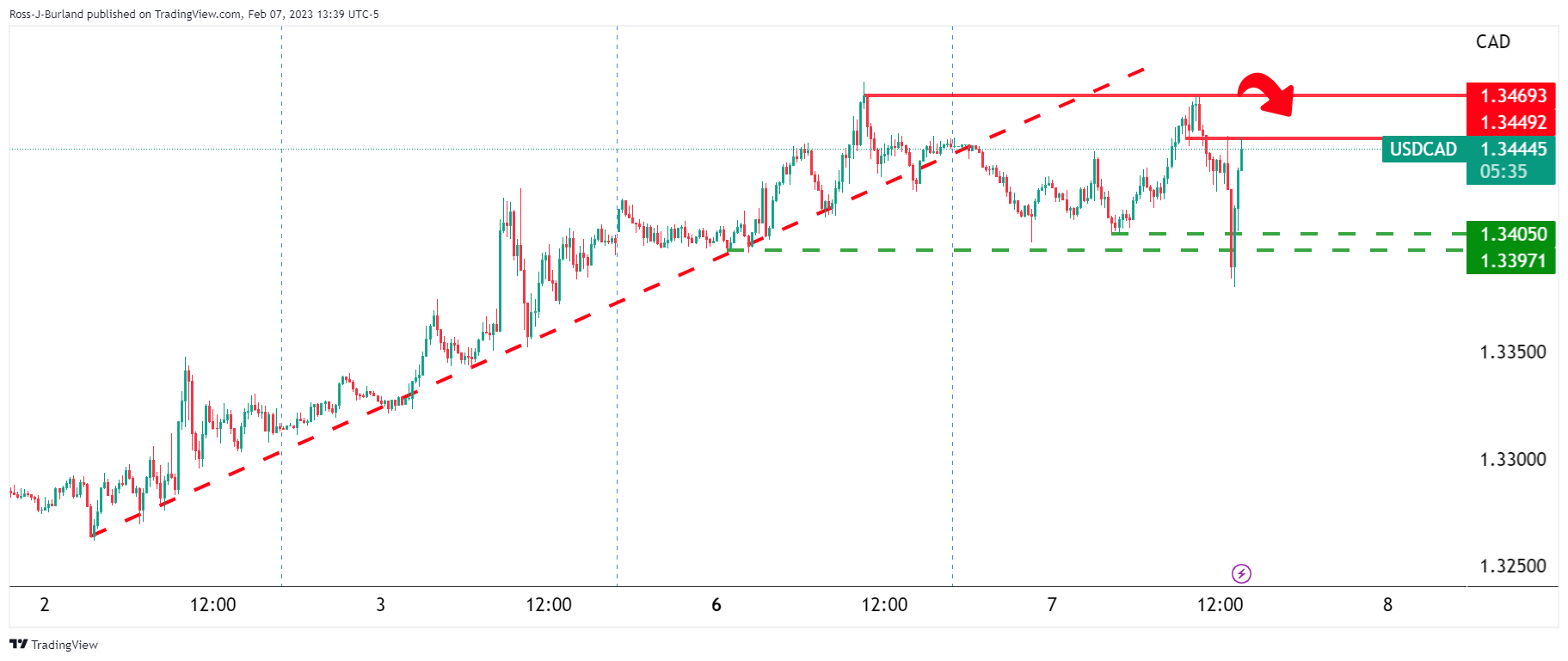
- The US Dollar longs were cleared out on Fed chairman Powell.
- However, the drop in the greenback could be seen as a discount to the most bullish of the US Dollar bulls.
The US Dollar, as measured by the DXY index, fell from a high of 103.49 to a low of 103.001 after comments from Federal Reserve's Jerome Powell circulated the wires. Powell is peaking at The Economic Club of Washington, D.C. Signature Event and repeated much of the same as he did at the press conference that followed last week's interest rate decision.
Key comments
The jobs report was certainly stronger than anyone expected.
The strong jobs report shows you why we think this will be a process that takes a significant period of time.
Expect 2023 to be a year of significant declines in inflation.
We probably need to do further interest-rate increases.
If data were to continue to come in stronger than expect, would certainly raise rates more.
2% inflation is a global standard and not something the Fed is looking to change.
Fiscal authorities are concerned about the debt limit.
The debt limit debate can only end with congress raising it, which has to happen.
Congress needs to raise debt ceiling in timely fashion
If debt ceiling isnt raised no one should think fed can shield economy from effects.
I am not actively contemplating the sale of securities.
It will be a couple of years before the fed's balance-sheet decline comes to an end.
The US is ‘just at the beginning’ of the disinflation process.
Worries most about when disinflation will take hold in larger services sector, also concerned about outside events.
The US economy added 517K jobs in January, the most since July and much more than market expectations of 185K. Following the release of the Nonfarm Payrolls data on Friday, ISM services data pointed to a strong services sector, adding to concerns about persistent inflation and bolstering the case for more rate increases.
EUR/USD and US Dollar reactions
However, we have seen a shake out of the in-the-money US Dollar longs during this event with a rally in the Euro, for instance:
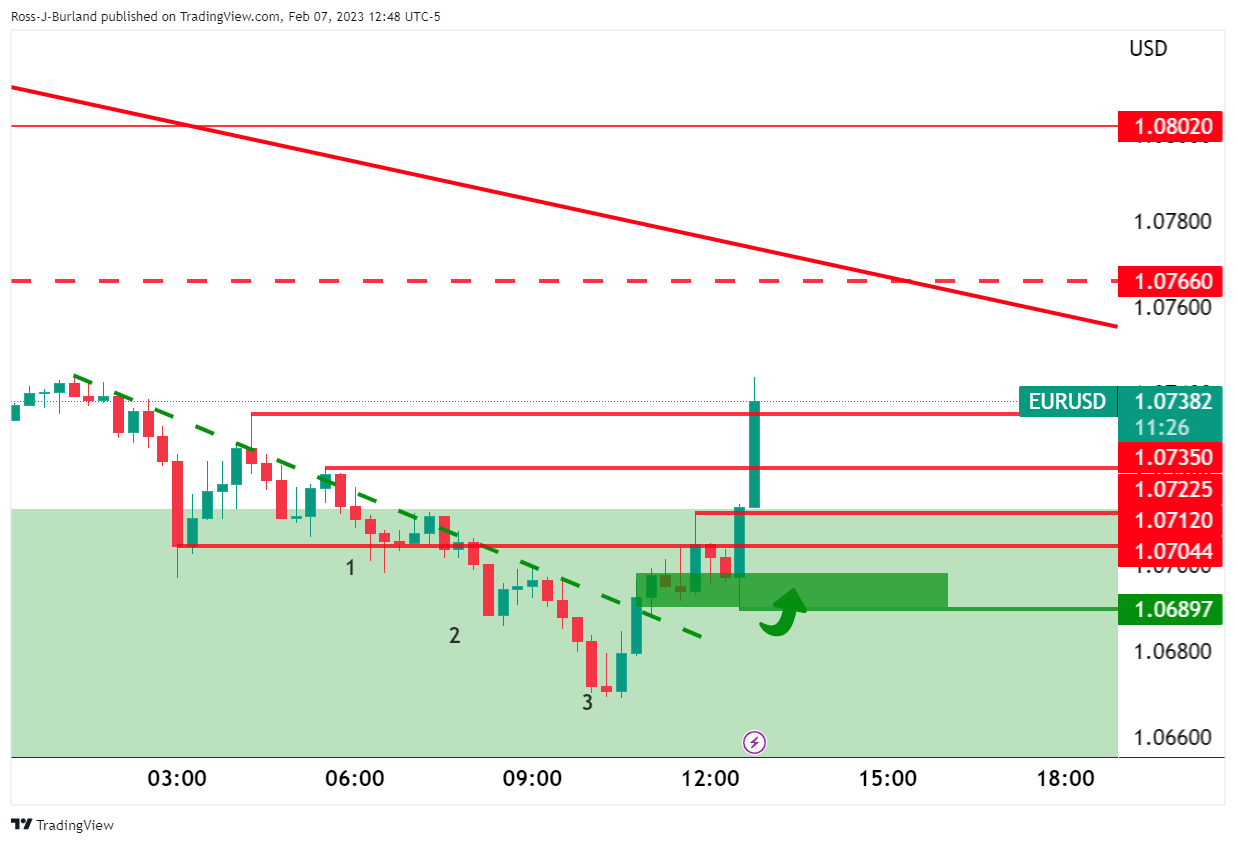
However, there was a bounce in the greenback in more recent moments during his comments which has sunk the Euro as risk appetite dwindled:
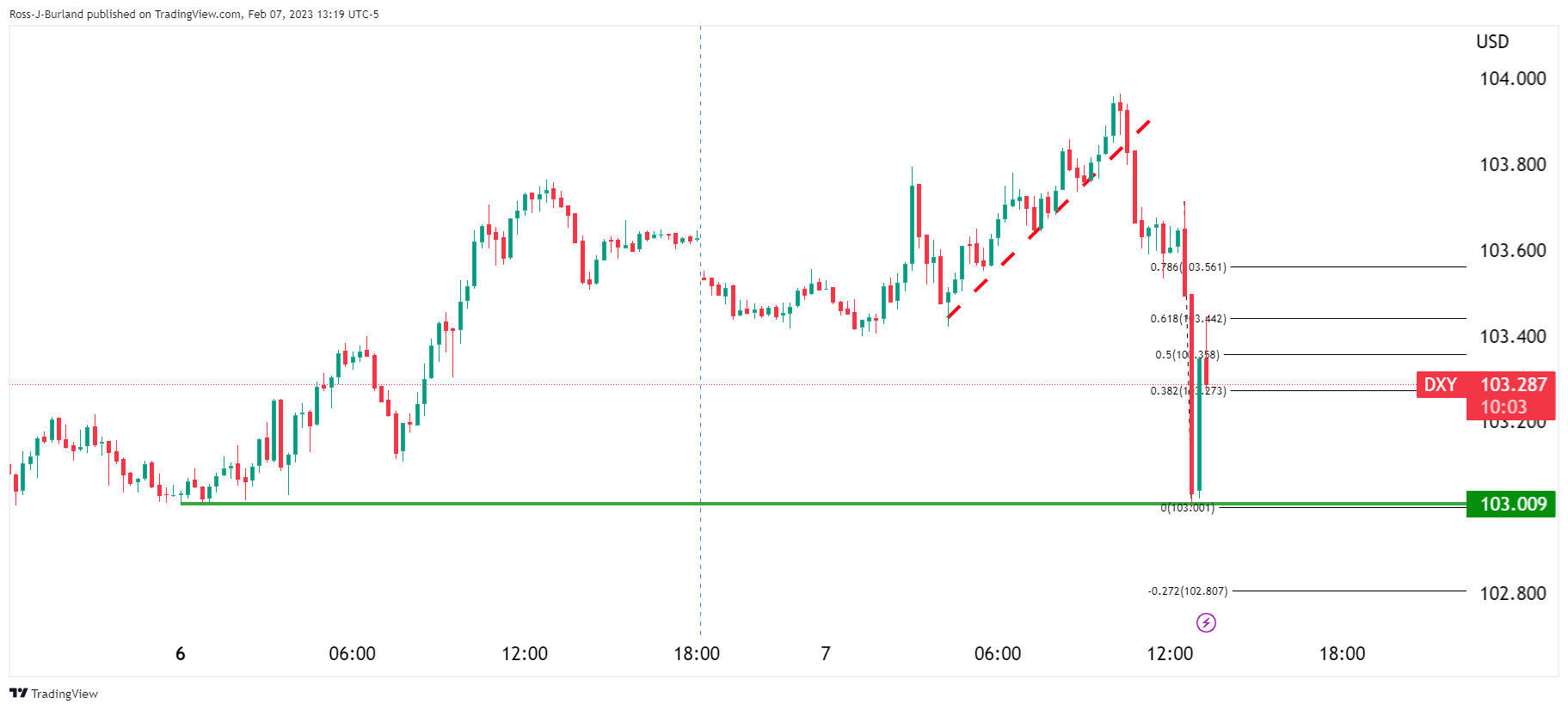
This is a 61.8% ratio retracement in the DXY index and a firm one at that with support at 103.00 holding steadfast. The longs were cleared out, but this could be seen as a discount to the most bullish of the US Dollar bulls.
This is a developing story.
Federal Reserve Chairman Jerome Powell is speaking at The Economic Club of Washington, D.C. Signature Event coming up in the next moments.
Key notes
The jobs report was certainly stronger than anyone expected.
The strong jobs report shows you why we think this will be a process that takes a significant period of time.
We probably need to do further interest-rate increases.
If data were to continue to come in stronger than expect, would certainly raise rates more.
2% inflation is a global standard and not something the fed is looking to change.
Fiscal authorities are concerned about the debt limit.
The debt limit debate can only end with congress raising it, which has to happen.
Congress needs to raise debt ceiling in timely fashion
If debt ceiling isnt raised no one should think fed can shield economy from effects.
I am not actively contemplating the sale of securities.
It will be a couple of years before the fed's balance-sheet decline comes to an end.
More to come...
EUR/USD update
The US Dollar is sinking and EUR/USD has rallied hard as follows:
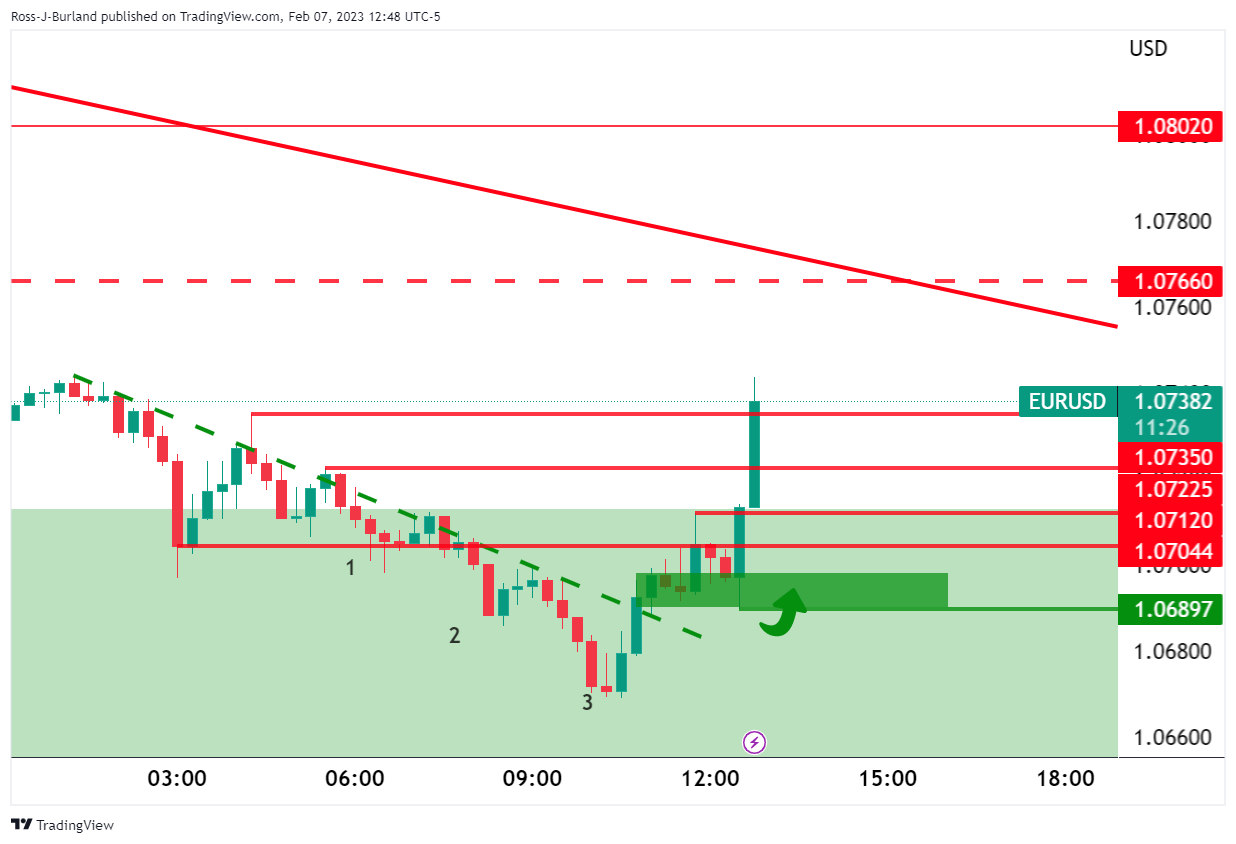
Isabel Schnabel, a Member of the ECB’s Executive Board, wrote in press release entitled, 'Monetary policy in times of pandemic and war' that inflation momentum remains ‘quite elevated,‘ but cannot give all clear on inflation yet and that the ECB Intends to raise rates by 50bps in March.
Key notes
Underlying inflation rate still extraordinarily high.
Inflation slowing not yet linked to ECB policy.
Keeping ‘particularly close eye’ on core inflation.
Sees unions continuing to keep demanding higher wage.
EUR/USD update
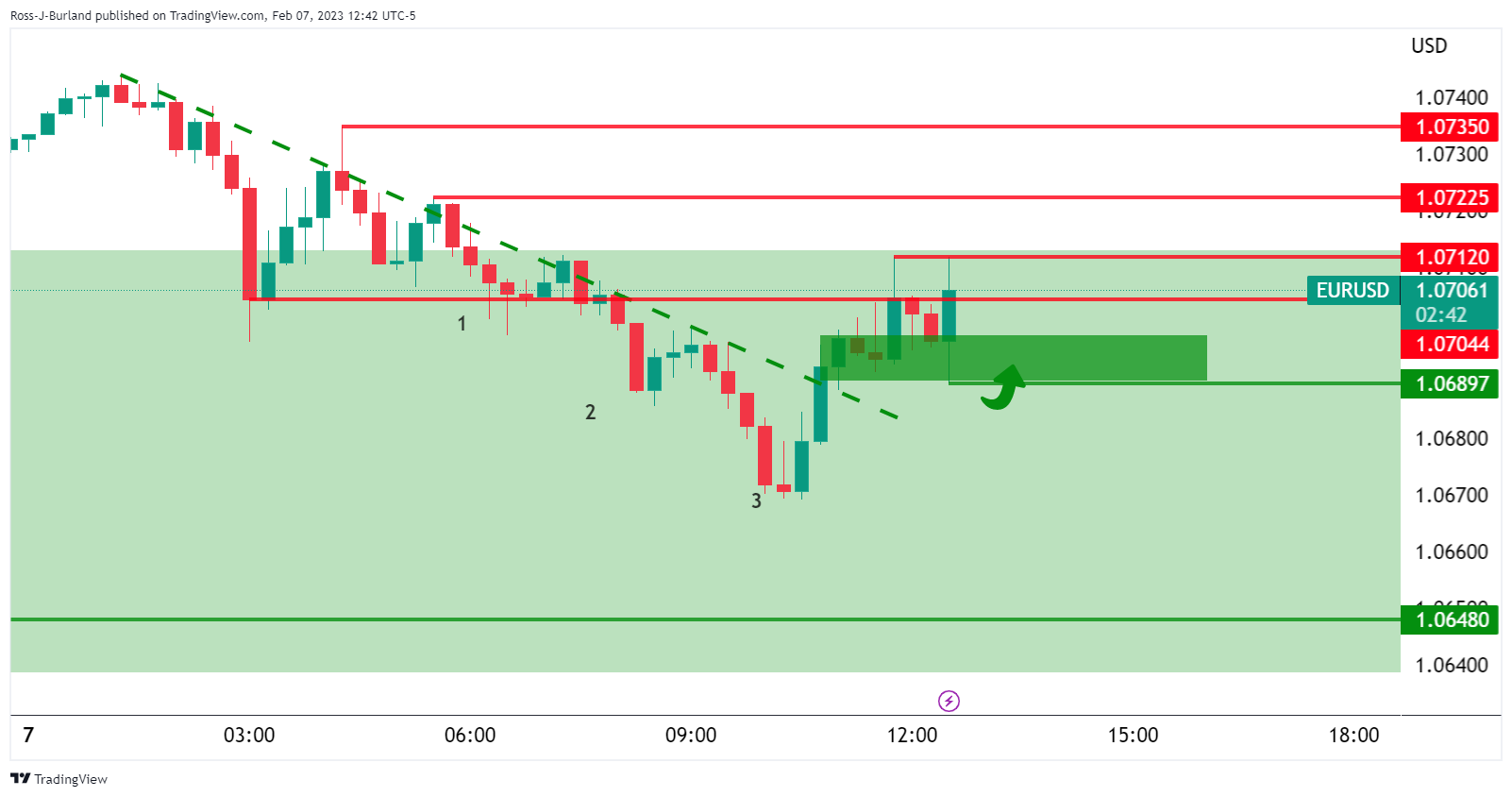
The price of EUR/USD is under pressure and volatile ahead of Federal Reserve Chairman Jerome Powell speaking. However, a bullish outcome could come from dovish rhetoric.
- Gold remained steadily firm, around $1870 ahead of Powell’s speech.
- US Federal Reserve officials expect rates to peak above 5%, with some estimating 5.4%.
- Gold Price Forecast: To remain neutral biased but slightly skewed to the downside.
Gold price clings to gains on Tuesday, though it remains below Monday’s high of 1881.31, ahead of Fed’s Chair Jerome Powell’s comments in an event at the Economic Club of Washington at 17:40 GMT. Hence, the XAU/USD is exchanging hands at 1874.20 after hitting a daily low of 1865.81 at the time of writing.
XAU/USD seesaws as investors expect a hawkish speech by Powell
Wall Street has turned positive, except for the Dow Jones Industrial. A late risk-on impulse at around the London Fix weighed on the US Dollar (USD), with Briton traders squaring their positions ahead of Powell’s speech. It’s the first time the Fed Chair takes the stand after an eye-opening US jobs report, with the economy adding more than 500,000 jobs and the unemployment rate diving to 53-year lows at 3.4%.
Comments from Federal Reserve officials spurred a reaction from market participants. Raphael Bostic, from the Atlanta Fed, commented that the Fed would need to raise rates further than previously foreseen. Echoing some of its comments was the Minnesota Fed President Neil Kashkari, a voter in 2023, that he anticipates the Federal Fund rate at around 5.4% due to the stronger-than-expected labor market report, which showed that the US central bank needs to keep raising rates.
The reflection of those comments is US bond yields. The 10-year benchmark note rate is 3.652%, up by two bps. After the US Nonfarm Payrolls report, the 10-year bond yield rallied 26 bps, as traders expect the Federal Funds rate to peak at around 5.25%. In addition, the US 10-year TIPS bond yield, a proxy for real yields, is advancing one bps, sitting at 1.369%, capping Gold’s rally on Tuesday.
What to Watch?
The US economic docket will feature further Fed speaking, Initial Jobless Claims for the week ending on February 4, and the University of Michigan Consumer Sentiment.
Gold Price Analysis: Technical outlook
XAU/USD remains neutral biased, trapped within the boundaries of the 20 and 50-day Exponential Moving Average (EMA) at the $1897-$1855 range. To resume its upward bias, Gold needs to break Monday’s high of $1882, which would exacerbate a test of the 20-day EMA, ahead of the $1900 mark. Otherwise, the XAU/USD will be under selling pressure, with the February 6 low at $1860.44, as the first demand area, followed by the 50-day EMA, ahead of December’s 27 daily high-turned-support at $1833.29
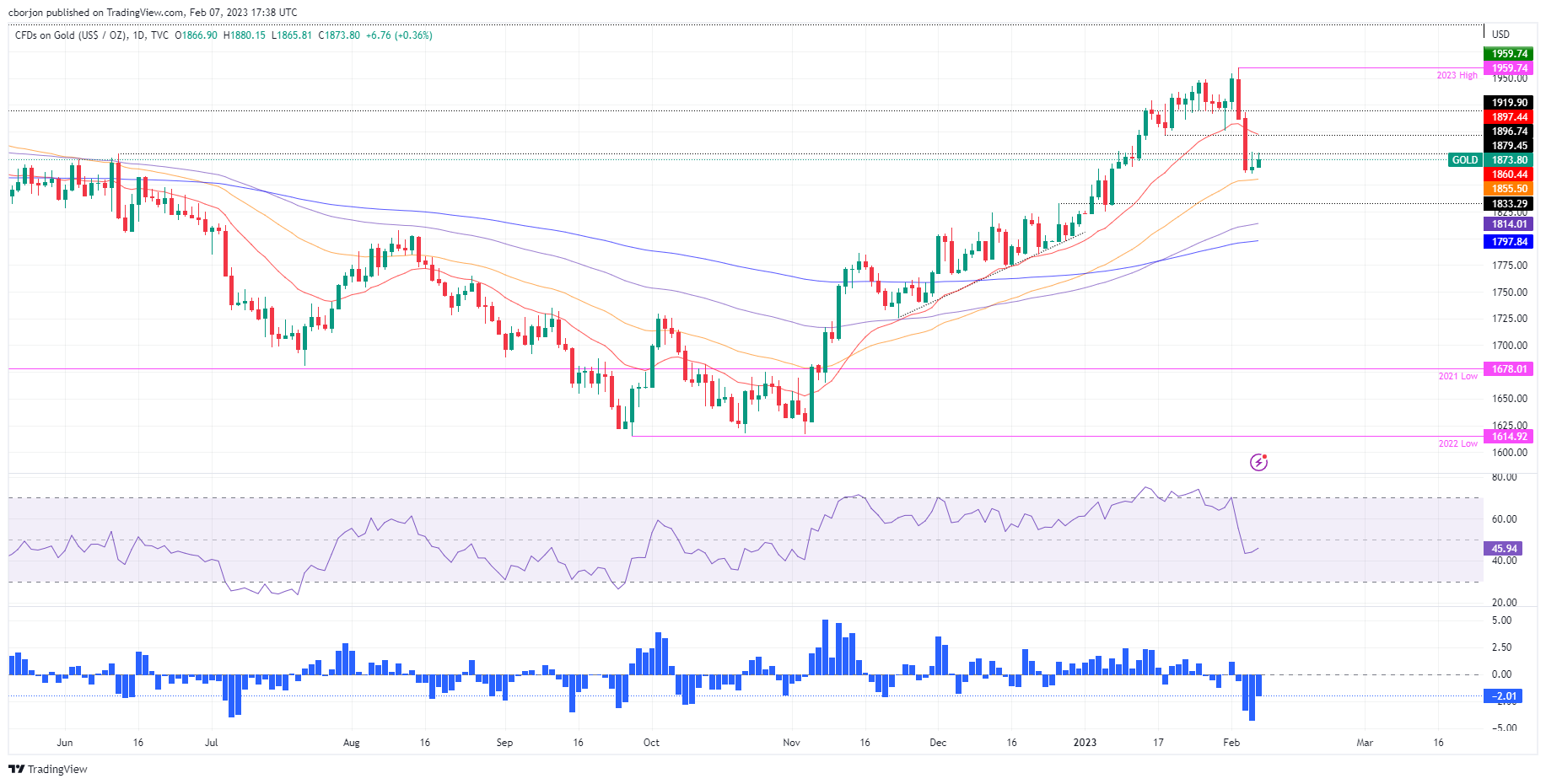
- EUR/USD bulls need a dovish tilt in the Fed chair Powell's speech that could weigh on the US Dollar.
- A break of session highs would leave the 1.0720s vulnerable in the near term.
- The daily ATR is 100 pips, so there is room for a range extension for the day.
EUR/USD is hitting a wall of resistance in the New York session as the countdown to the Federal Reserve's Jerome Powell gets underway. He speaks at The Economic Club of Washington, D.C. Signature Event coming up in the next moments.
Leading into the event, the US Dollar came under pressure that gave some life to the Euro bulls. We have seen a rally from the session lows that created a three-push pattern on the 15-min chart and a subsequent burst to the upside an hour after the cash-open on Wall Street.
The following illustrates the break of structure and prospects of a continuation higher depending on the outcome of the Powell event.
EUR/USD M15 chart
The bulls have moved in:
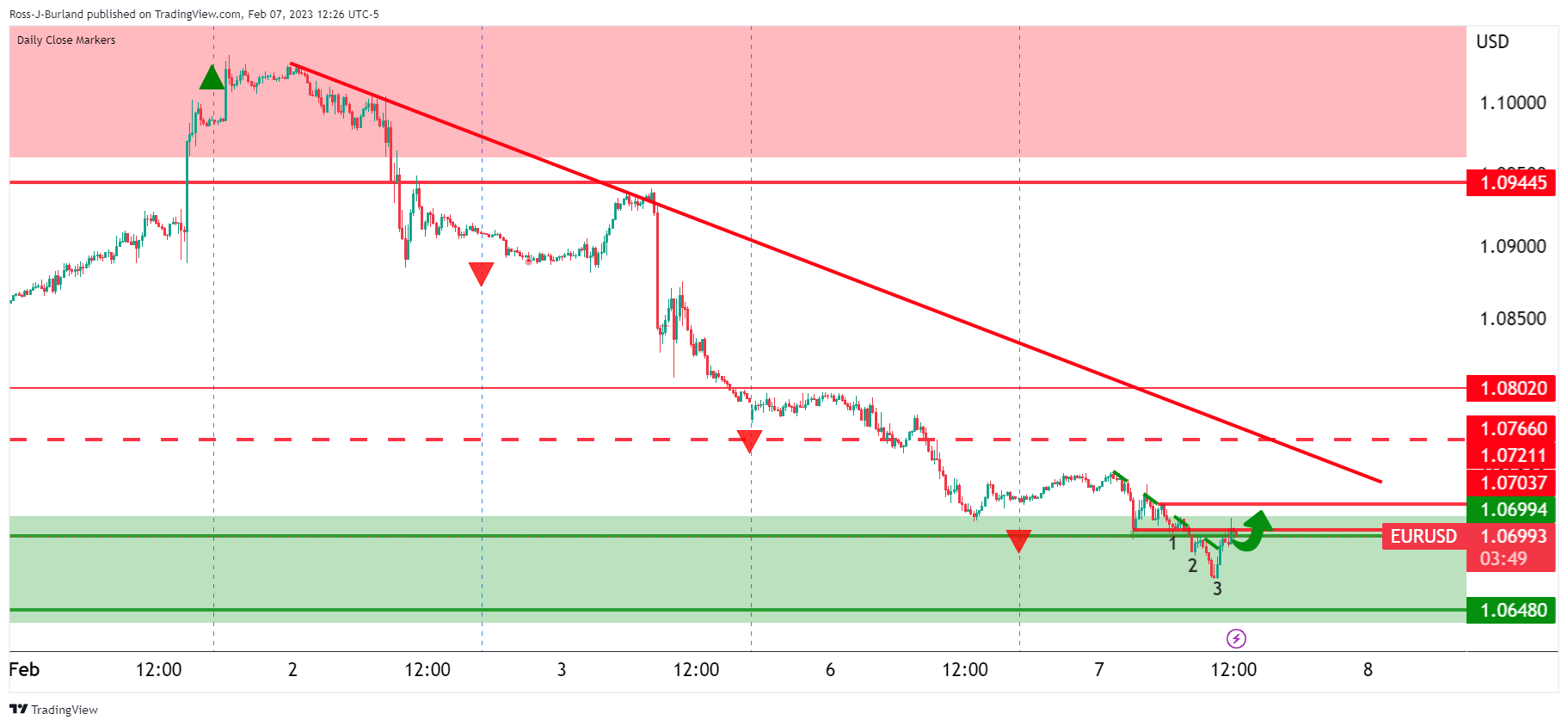
zoomed in ...
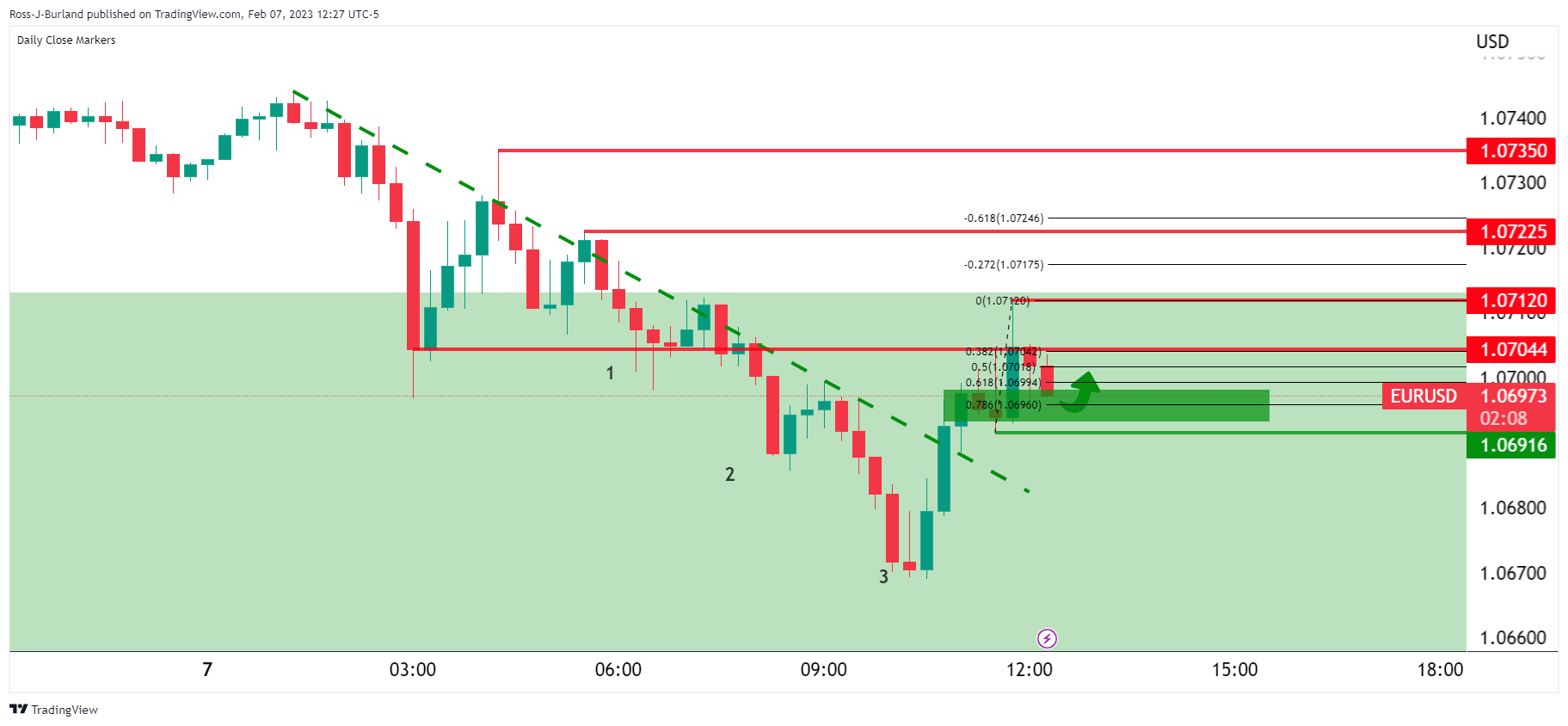
However, ahead of the event, there is a reluctance to hold onto positions. Should there be a dovish tilt in the speech, this could weigh on the US Dollar and see the price extend beyond the session highs and eye 1.0720s in the near term. The daily ATR is 100 pips, so there is room for a range extension for the day given the market has only completed around 75% of the ATR so far.
- GBP/USD rallies in the New York session ahead of Fed Powell.
- GBP/USD is the back side of the trendline resistance which is now expected to act as a counter-trendline with a focus on the upside.
- There are prospects of a move towards the 1.2050s with the 1.1990s eyed as support.
GBP/USD is breaking 1.20 the figure and the bulls eye 1.2050 for the sessions ahead. Cable has done 80% of the daily ATR of 122 so far and has travelled between a low of 1.1960 and 1.2057 on Tuesday.
The US Dollar lost some ground in the London fix which boosted the Pound to fresh session highs in New york, delving into 50% of the London session sell-off in a move that precedes a key speech from Federal Reserve's chairman, Jerome Powell. There will be other Fed speakers as well as the start of the refunding auctions with the 3-year auction today.
Fed Chairman Powell will be interviewed at a live transmitted event at the Economic Club of Washington, D.C., beginning at 18.00 CET. ''This could give Powell an opportunity to mitigate the markets' very dovish reaction to his press conference last week if he wants to, especially in light of the strong jobs report and ISM data we have seen since then,'' analysts at Danske Bank explained.
Meanwhile, the UK's Monetary Policy Committee recently raised its policy rate by 50bp to 4.00%, which was in line with consensus but above our forecast for a 25bp hike. The vote was split 7-2, with the two members voting against preferring no change at all in Bank Rate. However, the Bank of England is now moving into data-dependent mode and given that inflation is expected to be significantly lower by year-end and prospects of a rising unemployment rate, there are downside risks for the Pound should the BoE flip the script.
Nevertheless, we have heard from a hawkish BoE MPC member Catherine Mann this week who said ''the consequences of under-tightening far outweigh, in my opinion, the alternative. We need to stay the course, and in my view the next step in bank rate is still more likely to be another hike than a cut or hold.” In fact, BoE speakers are plentiful this week and we heard from Chief Economist Huw Pill as well who said, ''if you ask me where we are at the moment, I think we are still more concerned about the potential persistence of inflation.''
''Concerned about inflationary pressure in the labour market ‘probably tilts us to saying we haven't quite got to the point where we're confident to engage in a discussion of a turning point in rates.''
GBP/USD technical analysis
As per the start of the week's analysis, where it was registered that GBP/USD had closed in the red for three day's in a row, a move up into the in-the-money shorts was anticipated:

However, as the illustration above suggested, the bears could be lurking in a move-up to test the break of structure area (BoS) near 1.2090.
Meanwhile, we are starting to see the bulls move in as anticipated:
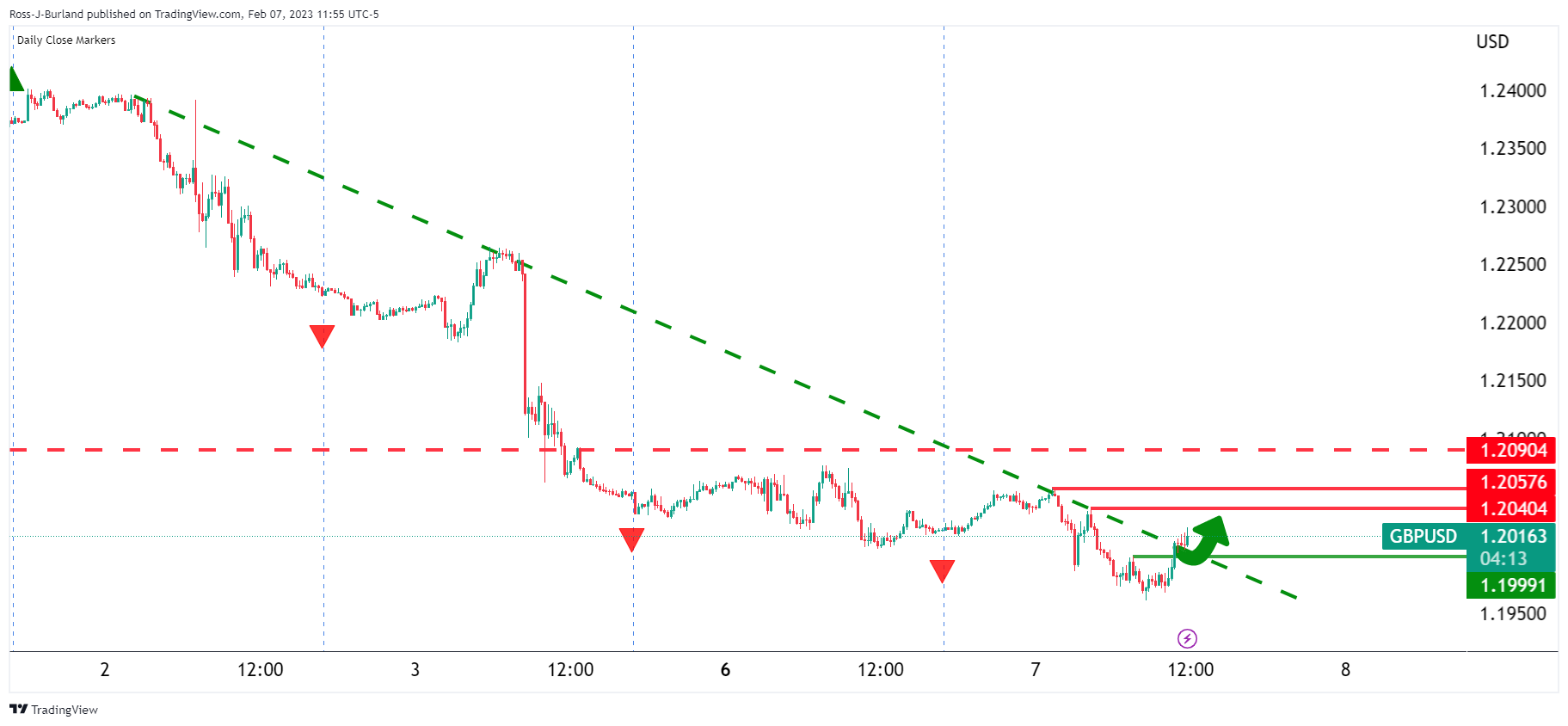
We are on the back side of the trendline resistance which is now expected to act as a counter-trendline with a focus on the upside. There are prospects of a move towards the 1.2050s with the 1.1990s eyed as support.
- AUD/USD resumes its uptrend after touching five-week lows around 0.6850.
- The RBA raised rates by 25 bps and projects additional increases to the cash rate.
- AUD/USD Price Analysis: Upward biased, it might test 0.7000 in the near term.
The Australian Dollar (AUD) recovered some ground vs. the US Dollar (USD) after the Reserve Bank of Australia (RBA) raised rates by 25 bps in the Asian session, which triggered a jump to fresh two-day highs of 0.6951. Nevertheless, solid US economic data increased the Fed’s likelihood of further rate hikes. Hence, the AUD/USD retreated some but is still up 0.52, trading at 0.6920.
AUD/USD is still underpinned by the Reserve Bank of Australia’s policy decision
The AUD/USD is holding to its gains. The RBA’s decision to lift rates to the 3.35% threshold keeps the Aussie Dollar (AUD) positive in the day, clinging to gains above the psychological 0.6900 level. The RBA reiterated that further increases would be needed due to core inflation being higher than expected as the central bank tries to curb elevated inflation to its 2-3% target.
ANZ analysts expect the RBA to continue to raise the cash rate to 3.85%. “Today’s RBA statement spells out that further rate hikes are coming. We continue to expect that the cash rate target will rise another 25bp in March and then to 3.85% by May 2023. We still see the risks to that peak as tilted to the high side given the momentum in inflationary pressure.”
Aside from this, investors’ eyes would dissect each word of the US Federal Reserve (Fed) Chair Jerome Powell, who would cross wires at around 17:00 GMT. Solid US economic data revealed since the first week of February would likely keep the Fed pressured to deliver price stability. January’s staggering employment report has opened the door for further tightening.
In the early morning, Minnesota’s Fed President Neil Kashkari said that he foresees the Federal Fund rate at around 5.4% due to the stronger-than-expected labor market report, which showed that the US central bank needs to keep raising rates.
AUD/USD technical analysis
Technically speaking, the AUD/USD fell to a 5-week low but found support around the 0.6850 area and reclaimed the 50-day Exponential Moving Average (EMA), which rests at 0.6876. Nevertheless, for the AUD/USD to resume its uptrend, it needs a daily close above 0.6948, which would expose the pair to further buying pressure. That said, the AUD/USD next resistance would be the 20-day EMA at 0.6975, followed by the psychological 0.7000 figure, ahead of the February 3 high at 0.7080.

According to the Federal Reserve Bank of Atlanta's GDPNow model, the US economy is expected to grow at an annualized rate of 2.1% in the first quarter, up from 0.7% in the previous estimate.
"After releases from the US Census Bureau, the Institute for Supply Management, the US Bureau of Labor Statistics, and the US Bureau of Economic Analysis, the nowcasts of first-quarter gross personal consumption expenditures growth, and first-quarter gross private domestic investment growth increased from 1.9% and -9.3%, respectively, to 3.0% and -6.2%, respectively," Atlanta Fed explained in its publication.
Market reaction
This report doesn't seem to be having a noticeable impact on the US Dollar's performance against its rivals. As of writing, the US Dollar Index was posting small daily gains at 103.67.
USD/JPY broke above the 132 level. Still, economists at HSBC expect the pair to inch lower this year.
The BoJ is likely to tweak its monetary policy in 1H23
“We expect another widening of the Yield Curve Control (YCC) range in 1H23. The timing is uncertain, though. The BoJ Governor Kuroda’s last meeting will be on 10 March, and the first and second meetings chaired by the new governor will be held on 28 April and 16 June, respectively.”
“Aside from the BoJ, we think there are other plausible domestic developments that could drive USD/JPY lower in 2023: resident investors FX-hedging their foreign investments, and an improvement in Japan’s balance of payments amid JPY undervaluation (based on its real effective exchange rate) and tourism resumption.”
Besides Gold, the prices of other precious metals also came under pressure in the wake of the robust US labour market data. Economists at Commerzbank update their forecasts for Palladium, Silver and Platinum.
Forecasts for Silver and Platinum unchanged
“We are downwardly revising our Palladium forecast and now envisage a price of $1,700 by mid-year and of $1,900 by year’s end (previously: $2,000 and $2,100 respectively).
“We are leaving our price forecasts for Silver and Platinum unchanged.”
“Silver is likely to be priced at $23 by mid-year and $25 by year’s end.”
“We expect Platinum to be trading at $1,050 by mid-year and $1,150 at the end of 2023.”
Higher absolute yields in the Eurozone and Japan may drag more capital home, strengthening Euro and Yen and deepening the fall of the Dollar, Kit Juckes, Chief Global FX Strategist at Société Générale, reports.
Will capital repatriation to Europe and Japan extend the Dollar's fall?
“What will drive currency trends in the coming weeks and months? Capital flows may provide some of the answer, and weaken the Dollar further even if rate differentials move less from here on.”
“For European investors, the attraction of higher US yields goes down as Bund yields rise in absolute terms, even if the spread remains wide. And that can keep the Euro (and Yen) climbing even while yield differentials stabilize.”
“In the Eurozone and Japan, central bank buying crowded domestic savers out of domestic bond markets and forced them abroad, weakening EUR and JPY. If the ECB and BoJ can successfully exit from the bond market (and it’s worth noting that in 2018-2018, the ECB tried and failed to do so), maybe their currencies will return to pre-QE ranges eventually, too.”
- USD/CAD holds to gains as traders brace for Federal Reserve Chair Jerome Powell’s speech.
- The US trade deficit widened, though market participants ignored it.
- Bank of Canada’s Governor Tiff Macklem will cross wires later.
The USD/CAD prolongs its gains to four straight days, though it remains below the weekly high of 1.3475, meandering around 1.3460, after hitting a daily low of 1.3401, shy of the 20-day Exponential Moving Average (EMA) at 1.3399. At the time of typing, the USD/CAD exchanges hands a 1.3457, registering minuscule gains of 0.08%.
USD/CAD remains underpinned by a buoyant USD
Wall Street opened in the red, except for the Nasdaq 100. Traders are preparing for the US Federal Reserve (Fed) Chair Jerome Powell’s speech at the Washington Economic Club around 17:00 GMT. Investors are looking for Powell’s pushback following a strong jobs report released last Friday that witnessed the US economy adding 517K jobs in January vs. expectations of almost 200K. Consequently, the Unemployment Rate dived to 3.4% from 3.5%. All-in-all such a tight labor market would warrant further tightening by the Fed.
Data-wise, the US Commerce Department revealed the trade deficit widened 10.5% to $-67.4B compared to November’s $-61.0B, but below the market’s expectations of $-68.5B.
Elsewhere, Minnesota Fed President Neil Kashkari crossed wires and commented that he foresees the Federal Fund rate at around 5.4% due to the stronger-than-expected labor market report, which showed that the US central bank needs to keep raising rates. He added that “No one should overreact to one report,” but added that the strength of the services sector is still very robust, and “that’s where I think a lot of us are focusing our attention.”
In the meantime, the US Dollar Index, which tracks the buck’s performance against six currencies, continues to record gains, up 0.28% at 103.910, a tailwind for the USD/CAD pair. Nevertheless, Crude Oil prices remain underpinned following an earthquake in Turkey and Syria, which disrupted one of Turkey’s ports that exported around 1% of global supplies in January. Therefore, WTI exchanges hands at $75.47, up 1.44%, capping the USD/CAD rally.
Aside from this, Statistics Canada revealed its trade balance narrowed, compared to December’s data, as lower Crude Oil prices weighed on energy export and imports of consumer goods fell, according to Reuters. Also, USD/CAD traders could get some cues from Bank of Canada (BoC) Governor Tiff Macklem, which would cross newswires around 17:30 GMT. Given that the BoC announced a pause after lifting rates to 4.50%, it could weigh on the Loonie (CAD). Therefore, any dovish hints could pave the way for further upside in the USD/CAD, though capped by rising Oil prices.
USD/CAD Key Technical Levels
Further comments by President Lula da Silva, which could have been seen as interference in monetary policy, are likely to have put additional downside pressure on BRL, according to economists at Commerzbank.
Recent developments in Brazil are causing some concern
“Lula yesterday confirmed his view that current key rate levels of 13.75% are too high. In his view, this is not justified, and he called on companies to complain about excessive financing costs.”
“If doubts were to arise about the autonomy of the central bank while the government also pursues an expansionary fiscal policy that would not be good news for BRL. That is why recent developments in Brazil are causing some concern.”
“We can only hope that Lula will backpaddle again. If he was to keep flogging the same horse, then BRL might come under further depreciation pressure.”
European Central Bank (ECB) policymaker Joachim Nagel said on Tuesday that ECB rate cuts are not on the agenda in the foreseeable future and noted that ECB rates are not yet restrictive.
"A timely chat is needed on how far to lift QR caps after June," Nagel added and reiterated that they need "further, significant" rate hikes.
Market reaction
The Euro struggles to capitalize on the these hawkish comments. As of writing, the EUR/USD pair was trading at 1.0692, losing 0.35% on a daily basis.
- USD/JPY comes under pressure following Monday’s top near 133.00.
- US yields trade on a mixed tone ahead of Powell.
- Fed’s Powell will speak later in the NA session.
USD/JPY comes under some moderate downside pressure and probes the area below the 132.00 yardstick on turnaround Tuesday.
USD/JPY now focuses on Powell
The upside momentum in USD/JPY run out of steam in the boundaries of the 133.00 neighbourhood at the beginning of the week, as the NFP-induced bounce appear to have lost some impulse.
Tuesday’s resurgence of the selling pressure in spot comes amidst the pick-up in the risk-off sentiment, which eventually lends support to the demand for the Japanese safe haven.
Additionally, the mixed performance in US yields see the short end of the curve giving away part of the recent strong advance vs. extra gains in the belly and the long end. In the Japanese debt market, the JGB yields drop marginally below the 0.50% level.
Data wise in Japan, Household Spending dropped 1.3% in the year to December, while advanced prints for the same month saw the Coincident Index and the Leading Economic Index at 98.9 and 97.2, respectively.
Later in the NA session, Chief Powell will participate in a discussion at the Economic Club of Washington.
USD/JPY levels to consider
As of writing the pair is retreating 0.50% at 131.95 and the break below 128.08 (monthly low February 2) would aim for 127.21 (2023 low January 16) and finally to 126.36 (monthly low May 24 2022). On the upside, the immediate hurdle comes at 132.90 (monthly high February 6) seconded by 134.77 (2023 high January 6) and then 136.78 (200-day SMA).
USD/MXN has virtually unwound the entirety of the 2020/22 pandemic and energy supply shock to trade back close to the 18.50 lows. Economists at ING maintain a bullish bias on the Mexican Peso.
Peso looks good
“The very credible fiscal (Mexico 5-year CDS at 120bp vs. 233bp for Brazil) and monetary (real rates are +2%) situation are strong drivers for MXN demand.”
“Banxico continues to match the Fed in its tightening cycle, meaning that the policy rate will be taken close to 11% by the end of the quarter. Not bad with inflation running at 8.5%. And as the market takes a greater interest in carry, 3m MXN implied yields at 11.40% provided very strong risk-adjusted carry.”
“The Banamex sale or high US inflation pose the biggest threats.”
New BoJ leadership will shape market expectations on what policy stance BoJ could adopt going forward. Economists at OCBC analyze how each contender could impact the USD/JPY pair.
Upside momentum likely to have slowed
“Daily momentum is bullish but rise in RSI moderated. Upside momentum is likely to have slowed.”
“Resistance at 133.20 (23.6% fibo retracement of October high to January low) should provide decent resistance before 134.50 levels.”
“Support at 131 (before the gap up) and 130 (21 DMA), 127.50 levels (double-bottom low).”
“Focus this week on the list of BoJ nominees that is likely to be presented to parliament on 10 February though there are reports suggesting a delay to next week. Amamiya’s appointment would be most supportive of USD/JPY upside while Yamaguchi’s appointment could weigh on USD/JPY. Ito and Nakao could see gradual policy normalisation and could also weigh on USD/JPY, but to a lesser extent.”
- GBP/USD turns lower for the fourth successive day and drops to a fresh one-month low.
- Hawkish Fed expectations, a softer risk tone underpins the USD and exerts some pressure.
- Traders look forward to Fed Chair Jerome Powell’s speech for some meaningful impetus.
The GBP/USD pair attracts fresh sellers following an intraday uptick to the 1.2055 area and turns lower for the fourth successive day on Tuesday. Spot prices drop to a fresh one-month low heading into the North American session, with bears now eyeing to challenge a technically significant 200-day SMA near mid-1.1900s.
The US Dollar reverses an intraday dip and holds steady near a one-month peak touched on Monday, which, in turn, is seen exerting downward pressure on the GBP/USD pair. The upbeat US monthly jobs data (NFP) released last week fueled speculations that the Federal Reserve (Fed) will stick to its hawkish stance. This, in turn, remains supportive of a modest intraday uptick in the US Treasury bond yields and acts as a tailwind for the greenback.
In contrast, the Bank of England last week signalled that it was close to pausing the current rate-hiking cycle. In fact, the UK central bank removed the phrase that they would "respond forcefully, as necessary". Furthermore, BoE Governor Andrew Bailey said that inflation will fall more rapidly during the second half of 2023. This, in turn, is seen weighing on the British Pound and contributing to the offered tone surrounding the GBP/USD pair.
Apart from this, the prevalent cautious market mood - amid looming recession risks - further benefits the greenback's relative safe-haven status against its British counterpart. Tuesday's intraday slide could also be attributed to some technical selling below the 1.2000 psychological mark. This, in turn, supports prospects for an extension of the depreciating move, though traders might wait for Fed Chair Jerome Powell's speech for a fresh impetus.
Investors will closely scrutinize Powell's comments on inflation and monetary policy for clues about the Fed's future rate-hike path. This, in turn, will play a key role in influencing the near-term USD price dynamics and produce some meaningful trading opportunities around the GBP/USD pair in the absence of any relevant market-moving economic releases.
Technical levels to watch
- Canada's international trade deficit narrowed slightly in December.
- USD/CAD trades virtually unchanged on the day at around mid-1.3400s.
Canada's merchandise trade deficit with the world narrowed from C$219 million in November to C$160 million in December, Statistics Canada reported on Tuesday. This reading came in better than the market expectation for a deficit of C$1 billion.
"In December, Canada's merchandise exports decreased 1.2%, mostly on lower exports of energy products," the publication read. "Meanwhile, imports were down 1.3%, mainly driven by lower imports of consumer goods."
Market reaction
USD/CAD showed no immediate reaction to these figures and was last seen trading flat on the day at 1.3448.
- US Goods and Services Trade Balance came in at -$67.4 billion in December.
- US Dollar Index continues to push higher after the data.
The United States international trade deficit in goods and services rose by $6.4 billion to $67.4 billion in December, the data published jointly by the US Census Bureau and the US Bureau of Economic Analysis revealed on Tuesday.
This reading came in better than the market expectation for a deficit of $68.5 billion.
"December exports were $250.2 billion, $2.2 billion less than November exports," the publication further read. "December imports were $317.6 billion, $4.2 billion more than November imports."
Market reaction
The US Dollar Index preserves its bullish momentum after this data and was last seen trading at its highest level in nearly a month at 103.85, rising 0.22% on a daily basis.
- EUR/USD adds to the ongoing bearish move and drops below 1.0700.
- Extra decline appears in the pipeline below the 1.0770 region.
EUR/USD remains well on the defensive and drops to new lows in the sub-1.0700 zone on Tuesday.
The pair has recently broken below the 3-month support line near 1.0770, and this now allows for the downtrend to gather extra impulse in the near term. Against that, the next interim support comes at the 55-day SMA at 1.0662, while the breach of this region could open the door to a deeper retracement to the 2023 low at 1.0481 (January 6).
In the longer run, the constructive view remains unchanged while above the 200-day SMA, today at 1.0319.
EUR/USD daily chart
Minneapolis Federal Reserve (Fed) President Neel Kashkari told CNN Tuesday that the labor market is still too hot and that it makes it harder to bring inflation down, as reported by Reuters.
"We may have to hold rates at a higher level for longer," Kashkari added and said that he is not forecasting a recession.
Earlier in the day, Kashkari told CNBC that they are totally committed to getting inflation back to the 2% target.
Market reaction
The US Dollar holds resilient against its major rivals after these comments with the US Dollar Index clinging to modest daily gains at 103.75.
The rally in EUR/USD came to a shuddering halt after the dovish market interpretation of the ECB rate decision. Still, economists at Société Générale note that the long-term points to the upside.
Further profit-taking cannot be ruled out
“Tactically, further profit-taking cannot be ruled out.”
“The ECB may try to correct the market’s dovish interpretation of the rate decision and statement last week. This could attract Euro buying but conviction is likely to remain at a low ebb until the CPI release in the US next week.”
“The longer-term trend for EUR/USD remains tilted to the upside thanks to the improved terms of trade, the boost in economic growth in China, narrowing of Fed/ECB policy spread and attractive valuation.”
“Main downside risks are associated with the new military offensive by Russia in Ukraine and escalation with the Western allies/disruption to energy supplies.”
- Gold price struggles to capitalize on its modest intraday uptick and hangs near a one-month low.
- Expectations that the Federal Reserve will stick to its hawkish stance seem to cap the XAU/USD.
- Subdued US Dollar price action lends some support ahead of Fed Chair Jerome Powell’s speech.
Gold price edges higher for the second straight day on Tuesday, albeit seems to struggle to capitalize on the modest intraday gains. The XAU/USD trades around the $1,872-$1,873 region heading into the North American session and remains close to a one-month low touched on Monday.
Subdued US Dollar demand lends support to Gold price
The US Dollar (USD) stalls its recent strong recovery move from a nine-month low and turns out to be a key factor lending some support to the Gold price. The downside for the USD, however, seems cushioned amid expectations that the Federal Reserve (Fed) will stick to its hawkish stance for longer. This, in turn, keeps a lid on any meaningful upside for the US Dollar-denominated commodity.
Hawkish Fed expectations cap the upside for Gold price
The latest monthly employment details from the United States (US) released last Friday pointed to the underlying strength in the labor market and could allow the Fed to continue raising interest rates. This, in turn, pushes the US Treasury bond yields higher and acts as a tailwind for the Greenback, capping gains for the non-yielding Gold price, at least for the time being.
Focus remains on Fed Chair Powell’s speech
Traders also seem reluctant to place aggressive bets ahead of Fed Chair Jerome Powell's appearance later during the US session. Powell's comments on inflation and monetary policy might influence market expectations about the Fed's rate-hike path. This, in turn, will play a key role in influencing the near-term USD price dynamics and provide a fresh directional impetus to Gold price.
In the meantime, the XAU/USD seems more likely to extend its sideways consolidative price move in the absence of any relevant market-moving economic releases from the US. Hence, it will be prudent to wait for strong follow-through buying before confirming that the recent sharp pullback from the highest level since April 2022 has run its course and positioning for additional gains.
Gold price technical outlook
From a technical perspective, the lack of any meaningful buying suggests that the recent downfall in Gold price might still be far from being over. Moreover, oscillators on the daily chart have just started drifting into negative territory and are still far from being in the oversold zone. This, in turn, supports prospects for a further near-term depreciating move. That said, it will be prudent to wait for some follow-through selling below the multi-week low, around the $1,860 region, before placing fresh bearish bets.
Gold price could then accelerate the fall towards the $1,825 horizontal support en route to the $1,800 round-figure mark. This is followed by the very important 200-day Simple Moving Average (SMA), currently around the $1,776-$1,775 area. The latter should act as a pivotal point, which if broken decisively will be seen as a fresh trigger for bearish traders set the stage for a deeper corrective decline.
On the flip side, any meaningful upside is likely to confront some resistance near the $1,890-$1.892 zone ahead of the $1,900 mark. A sustained strength beyond has the potential to lift the Gold price to the $1,920 horizontal barrier, above which a bout of a short-covering move could push the XAU/USD towards the $1,950 region. This is closely followed by the multi-month peak, around the $1,960 area touched last week.
Key levels to watch
The Yen has rebounded modestly supported by the release of stronger than expected wage data from Japan. Economists at MUFG Bank stick to their forecast of USD/JPY 120 this year.
Favourable outcome for spring wage negotiations needed to trigger a stronger JPY rally
“The stronger monthly wage data will need to be backed up as well by a favourable outcome for the spring wage negotiations to trigger a stronger rally for the Yen.”
“The Yen is currently lacking a fresh catalyst to trigger further gains although we still expect USD/JPY to move into the low 120.00’s this year.”
- The index adds to the ongoing rebound and approaches 104.00.
- Gains could now accelerate to the 105.60 region in the near term.
The dollar’s march north remains unabated on Tuesday and encourages DXY to challenge the 55-day SMA near 103.80.
In the near term, further gains appear in the pipeline while above the 3-month support line near 101.90. That said, the next target of note now emerges at the 2023 peak at 105.63 recorded on January 6.
In the longer run, while below the 200-day SMA at 106.45, the outlook for the index remains negative.
DXY daily chart
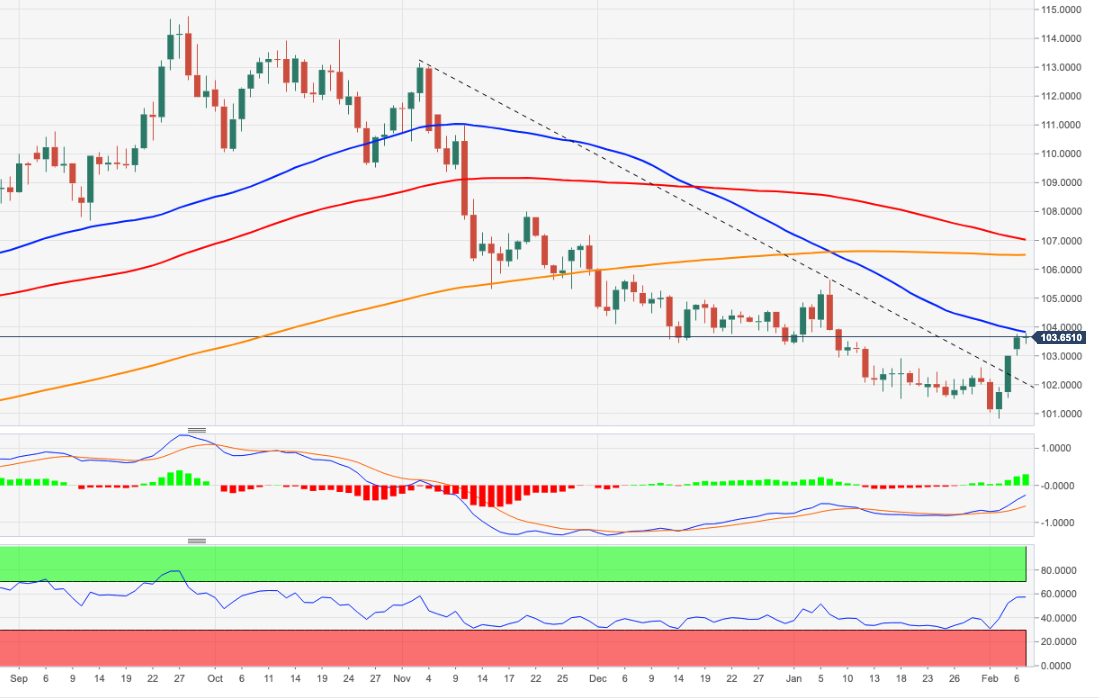
The Dollar is regaining ground as markets position themselves for a hawkish tone from FOMC Chairman Jerome Powell. In the view of economists at ING, the Dollar recovery may run a little longer.
The Dollar comeback hinges on Powell, again
“It looks like markets have already positioned themselves for some pushback against easing rate expectations, but the surprise strength of the US jobs report gives Powell ample room to sound more hawkish than expected. Ultimately, the ongoing upward correction may run a little longer before losing steam.”
“The overall environment is doing little to lure markets back into risk assets and away from the safe-haven Dollar. US-China tensions are a source of concerns and likely weighing on global sentiment, and the eurozone cannot count on a supportive data flow to keep the growth re-rating process going.”
“It looks like only another under-delivery (i.e. dovish surprise) by Powell can hurt the Dollar today.”
Two-year Treasury yield has dropped below the Fed funds rate. This development is usually supportive for equities though S&P 500 has already made a record annualized gain of 54.5% in just 50 days (since December 15, 2022), economists at the National Bank of Canada report.
A recession could still be avoided
“Whether or not there is a recession in the coming quarters, our research shows that the period between an inversion of the 2-year Treasury yield with the overnight rate and the first Fed rate cut tends to be relatively good for equity markets.”
“The reason why the stock market tends to perform well in the run-up to the Fed's first rate cut is that investors generally embrace a soft landing scenario. Things get more complicated for equity markets once the Fed has pivoted and the collateral damage of previous cumulative tightening is fully reflected in the economy.”
“Although a recession could still be avoided, we remain cautious about increasing our equity exposure after the recent record surge. We still recommend underweighting equities in relative terms and holding excess cash positions.”
Senior Economist at UOB Group Alvin Liew assesses the latest results from retail sales in Singapore.
Key Takeaways
“Singapore’s retail sales rebounded to end 2022 on a positive note, expanding 1.3% m/m, 7.4% y/y in Dec while Nov’s numbers saw some improvement to -3.6% m/m, 6.5% y/y. For the full year, retail sales rose by 10.5% in 2022, above our forecast of 10.5% but below 2021’s 11.1%.”
“The estimated total retail sales value was S$4.69bn in Dec (from S$4.0 bn in Nov). While the Dec months typically see a spike in retail sales value (likely due to festive spending and gift buying), the latest print is the highest monthly record since the data is made available in 1997. We suspect the high Dec sales was due to a combination of stronger demand (with some element of revenge spending), higher prices (inflation) and buying ahead of Jan 2023 GST hike.”
“Outlook – We have conservatively upgraded our 2023 retail sales growth forecast to 5.0% (from 2.3% previously) with the upside potential to our forecast mainly due to China’s lifting of zero-Covid policy.”
Minneapolis Federal Reserve (Fed) President Neel Kashkari told CNBC on Tuesday that he was surprised by the January jobs report, per Reuters.
Key takeaways
"We are not seeing much imprint of our actions on labor market."
"I am not lowering my rate path, still around 5.4%."
"I'm not changing my forecast for rates for now."
"I wish we saw more evidence underlying inflation was trending down more."
"Services side of economy is still very robust."
"We have to bring labor market into balance, haven't done enough yet."
"Nobody should overreact to one report, but there is underlying strength in services sector."
"Hard to imagine strong jobs growth can occur with wage growth moderating."
"We need to be disciplined."
"12 month PCE inflation is our ultimate goal."
"Core services ex housing has seen virtually no progress.",
"We haven't made enough progress to declare victory."
Market reaction
The US Dollar preserves its strength following these comments with the US Dollar Index clinging to modestly daily gains at around 103.70.
- EUR/JPY gives away part of the recent strong rebound to the 143.00 area.
- Losses could gather traction on a breach of the 200-day SMA.
EUR/JPY leaves behind two consecutive sessions with gains and comes under pressure after another failed attempt to break above the 143.00 region.
In the meantime, the 143.00 area remains a tough barrier for bulls. This key resistance zone appears reinforced by the 100-day SMA, today at 142.91
If the cross breaches the 200-day SMA at 140.99, the outlook is expected to shift to bearish.
EUR/JPY daily chart
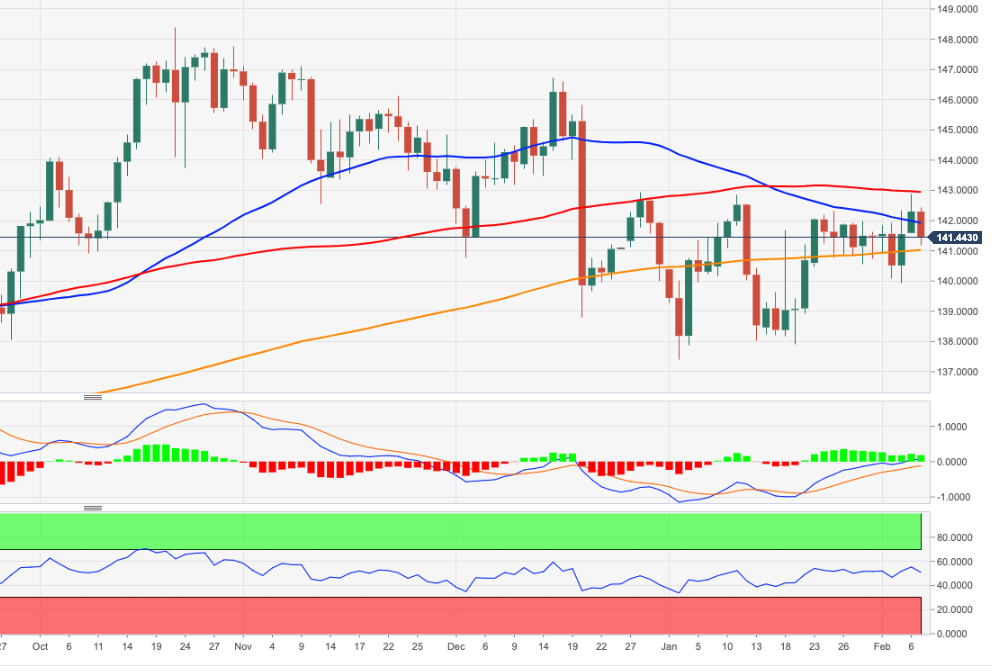
The Indian Rupee has had a reasonable start to the year, moving from about 82.70 to below 81.00 before drifting back up to around 82.00 currently. Economists at ING expect INR to remain steady.
RBI done, or close
“With inflation dropping back into the Reserve Bank of India’s target range, and below policy rates, central bank tightening is now probably complete, or at least, close to complete.”
“The latest budget contained aggressive growth-promoting capital expenditure measures, though the deficit is expected to shrink to below 6% after this year’s 6.4% target. The slightly tighter fiscal stance could help offset the end to monetary tightening to leave the currency relatively steady.”
The continuation of the upside pressure could put USD/IDR en route to visit the 15,190 level in the near term according to Quek Ser Leang, Markets Strategist at UOB Group.
Key Quotes
“We expected USD/IDR to decline further last week but we were of the view that ‘it is unlikely to challenge the major support at 14,770’. We added, ‘On a shorter-term note, 14,850 is already quite a strong support level.’
“USD/IDR dropped to a low of 14,830 on Thursday. The sharp rebound from the low has gathered considerable momentum and we see room for USD/IDR to rise to 15,190. In view of the overbought short-term conditions, a sustained rise above this level is unlikely this week. Support is at 14,980, followed by 14,920.”
Correction of the Gold price – what is going to happen next? Strategists at Commerzbank note that interest rate expectations are still the main factor driving the yellow metal.
First minor rate cut is now expected only at the end of the fourth quarter
“Interest rate expectations are still the main factor driving the price. The interest rate peak, as reflected in the Fed Fund Futures, is now at above 5% and is therefore more in line with recent comments by numerous Fed officials. Furthermore, this interest rate level is set to remain in place until into the late autumn, according to the Fed Fund Futures.”
“The first minor rate cut is now expected only at the end of the fourth quarter, rather than already in the summer. This also tallies more closely with the Fed rhetoric, which has so far excluded the possibility of rate cuts this year.”
There is really a lot to be liked about the Australian Dollar. Economists at ING expect the AUD/USD pair to reach the 0.75 level by the end of the second quarter.
All aboard the Aussie rally
“Australia is very uniquely exposed to a recovering growth outlook in China and the apparent improvement in Beijing’s diplomatic ties (remember the Sino-Australian trade war?).”
“Australian economy appears relatively resilient, and sticky inflation is likely to force the Reserve Bank of Australia to keep hiking, ultimately raising AUD's rate attractiveness.”
“We see few reasons to go against the AUD rally at the moment, and we expect AUD/USD to touch 0.75 by the end of the second quarter.”
- USD/CAD meets with some supply on Tuesday and snaps a three-day winning streak.
- Recovering oil prices underpin the Loonie and act as a headwind amid a softer USD.
- Recession fears, hawkish Fed expectations to limit losses for the USD and the major.
The USD/CAD pair comes under some selling pressure on Tuesday and snaps a three-day winning streak to over a two-week high, around the 1.3475 region touched the previous day. The pair maintains its offered tone through the first half of the European session and is currently placed near the daily low, just above the 1.3400 round-figure mark.
Crude oil prices build on the overnight goodish rebound from a nearly two-month low and gain traction for the second straight day amid optimism over a recovery in fuel demand. This, in turn, underpins the commodity-linked Loonie, which, along with a modest US Dollar weakness, exerts downward pressure on the USD/CAD pair. That said, a combination of factors helps limit losses for the major, at least for the time being.
Worries about economic headwinds stemming from the worst yet COVID-19 outbreak in China and rapidly rising borrowing costs might continue to act as a headwind for the black liquid. Apart from this, fresh speculations that the Federal Reserve will stick to its hawkish stance should lend some support to the safe-haven greenback. This, in turn, supports prospects for the emergence of some dip-buying around the USD/CAD pair.
Traders might also refrain from placing aggressive bets ahead of Fed Chair Jerome Powell and Bank of Canada Governor Tiff Macklem's scheduled speeches later during the North American session. Investors will look for fresh cues about the future rate-hike path, which, in turn, could determine the near-term trajectory for the USD/CAD pair. Apart from this, oil price dynamics will be looked upon for some meaningful impetus.
Technical levels to watch
European Central Bank (ECB) policymaker Francois Villeroy de Galhau said on Tuesday that the Eurozone was not very far from the peak of inflation, as reported by Reuters.
"I don't think we have to choose between fighting inflation and avoiding a recession," Villeroy added and said the better economic environment makes their monetary tasks easier.
Market reaction
EUR/USD stays on the back foot following these comments and the pair was last seen trading at 1.0710, where it was down 0.18% on a daily basis.
Economists at ING expect the EUR/JPY pair to edge lower as goldilocks year for the US economy could be too good to be true.
The hedge should goldilocks scenario fail
“Listening to Fed Chair Powell’s press conference on 1 February it almost sounded like 2023 could be a Goldilocks year for the US economy. Inflation could come down even though unemployment remained low. If that is too good to be true, then EUR/JPY should come lower.”
“There is also the case that the ECB’s new-found hawkishness in December – and marketed with mixed success in February – falls by the wayside. That is not our house view, which sees the ECB hiking a further 75 bps (deposit rate at 3.25%) and rates then unchanged through the fourth quarter of 2024.”
“The Japanese Yen also has the advantage of stronger Asian regional growth.”
Further gains could lift USD/MYR to revisit the 4.3250 level in the short-term horizon, notes Quek Ser Leang, Markets Strategist at UOB Group.
Key Quotes
“We highlighted last Monday (30 Jan, spot at 4.2380) that ‘further USD/MYR weakness is not ruled out but in view of the deeply oversold conditions, any decline is unlikely to break the support at 4.2000’. We added, ‘4.2200 is likely to offer strong support already’. USD/MYR dropped to a low of 4.2200 on Thursday before ending the week at 4.2560.”
“USD/MYR soared upon opening today and the rapid increase in momentum is likely to lead to further USD/MYR strength towards 4.3250. The next resistance at 4.3480 is likely out of reach this week. In order to keep the momentum going, USD/MYR should stay above 4.2500 . Minor support is at 4.2800.”
- AUD/USD regains positive traction on Tuesday in reaction to the RBA’s hawkish outlook.
- A modest USD downtick provides an additional lift and remains supportive of the move.
- Hawkish Fed expectations could help limit the downside for the buck and cap the major.
The AUD/USD pair catches fresh bids on Tuesday after the Reserve Bank of Australia (RBA) announced its policy decision and sticks to its gains through the first half of the European session. The pair is currently placed just below mid-0.6900s and for now, seems to have snapped a three-day losing streak to a one-month low touched on Monday.
The Australian Dollar strengthens across the board in reaction to the RBA's hawkish outlook, signalling that further rate increases will be needed to ensure that inflation returns to target. It is worth mentioning that the Australian central bank earlier this Tuesday raised its cash rate by 25 bps to a decade-high of 3.35%. Apart from this, a modest US Dollar weakness acts as a tailwind for the AUD/USD pair.
In fact, the USD Index, which tracks the Greenback against a basket of currencies, stalls the post-NFP strong recovery from a nine-month top and is weighed down by a combination of factors. A softer tone surrounding the US Treasury bond yields, along with signs of stability in the equity markets, seem to undermine the safe-haven buck. That said, hawkish Fed expectations help limit any meaningful slide for the USD.
The better-than-expected US monthly employment data released last Friday pointed to the underlying strength in the labor market. This could allow the US central bank to keep raising interest rates going forward, which, in turn, favours the USD bulls. This, in turn, warrants some caution before confirming that the AUD/USD pair's recent pullback from its highest level since June 2022 touched last week has run its course.
Moving ahead, there isn't any relevant market-moving economic data due for release from the US on Tuesday. Hence, the focus will remain glued to Fed Chair Jerome Powell's speech, which will be closely scrutinized for fresh clues about the central bank's future rate-hike path. This, in turn, will play a key role in influencing the USD price dynamics and provide a fresh impetus to the AUD/USD pair later during the US session.
Technical levels to watch
The Reserve Bank of Australia (RBA) hiked its cash rate by 25 bps to 3.35%. Economists at ANZ Bank expect two more hikes in March and May.
RBA cash rate target lifts to 3.35%; hawkish statement
“The RBA delivered the expected 25 bps rate increase. This took the cash rate target to 3.35%, with the cumulative increase since May now at 325 bps.”
“Today’s RBA statement spells out that further rate hikes are coming.”
“We continue to expect that the cash rate target will rise another 25 bps in March and then to 3.85% by May 2023. We still see the risks to that peak as tilted to the high side given the momentum in inflationary pressure.”
See: AUD/USD to struggle to gain further in the short term – Commerzbank
In the view of economists at ING, USD/JPY should continue to fall throughout the year. They target 120.
The BoJ is back on the map
“The Bank of Japan is now garnering much more focus than it has in years. Most pressing is the replacement of Governor Haruhiko Kuroda, who leaves in April. A successor will be presented to parliament on 10 February. The favourite, Deputy Governor Masayoshi Amamiya, is seen as the dovish continuity candidate.”
“Any surprise choice of the more hawkish Hiroshi Nakaso could probably send the Yen a lot stronger, with pressure building for 10-year JGB yields to burst above their current 0.50% ceiling.”
“USD/JPY has mainly been driven by the weaker Dollar story, but 120 looks like the target this year, helped by the BoJ and lower energy prices.”
- USD/JPY retreats from a one-month top and is pressured by a combination of factors.
- Japan’s FX intervention news and the risk-off environment benefit the safe-haven JPY.
- A modest USD weakness contributes to the slide, though the downside seems limited.
The USD/JPY pair comes under some selling pressure on Tuesday and erodes a part of the previous day's gains to the 133.00 neighbourhood, or a one-month top. The pair remains depressed through the first half of the European session and weakens further below the 132.00 mark, hitting a fresh daily low in the last hour.
A combination of factors helps revive demand for the Japanese Yen (JPY), which, along with a modest US Dollar downtick, exerts downward pressure on the USD/JPY pair. Japan's Ministry of Finance confirmed a stealth intervention in the FX markets twice in October to provide support to the domestic currency. Apart from this, speculation over an eventual hawkish tilt by the Bank of Japan (BoJ) and the prevalent risk-off environment offers additional support to the safe-haven JPY.
The USD, on the other hand, stalls last week's strong recovery from a nine-month low that followed the release of the upbeat US NFP report and acts as a headwind for the USD/JPY pair. The downside for the USD, however, remains cushioned amid expectations that the Federal Reserve will stick to its hawkish stance. The bets were lifted by Friday's stellar US jobs data, which pointed to the underlying strength in the labor market and should allow the Fed to keep hiking interest rates.
Hence, the focus shifts to Fed Chair Jerome Powell's speech, due later during the US session. Powell's remarks on inflation and monetary policy will be looked for clues about the Fed's rate-hike path. This, along with the US bond yields, will influence the USD price dynamics. Apart from this, the broader risk sentiment should provide some impetus to the USD/JPY pair. In the meantime, the mixed fundamental backdrop warrants some caution before positioning for any further intraday losses.
Technical levels to watch
The Indonesian Rupiah was a surprise outperformer in January. Economists at MUFG Bank expect the USD/INR to stabilize in the short-term before moving to 14,500 by year-end.
Some near-term consolidation after strong January gains
“For USD/IDR, we see some near-term consolidation after strong January gains. Thereafter, we retain our view of the IDR making more inroads against the USD later this year.”
“We forecast USD/IDR at 14,500 by the end of 2023.”
See – USD/IDR Price News: Rupiah rises towards $15,000 on upbeat Indonesia GDP, focus on China, Fed updates
Quek Ser Leang, Markets Strategist at UOB Group, suggests USD/THB could move into a consolidative phase ahead of potential extra gains in the near term.
Key Quotes
“Last Monday (30 Jan, spot at 32.78), we highlighted that ‘the combination of waning downward momentum and oversold conditions suggests USD/THB has moved into a consolidation phase’ and we expected USD/THB to ‘trade sideways between 32.60 and 33.05.’ However, USD/THB surged to a high of 33.51 on Friday.”
“While USD/THB extended its advance this week, deeply overbought conditions suggest it could consolidate for a couple of days first before heading higher. That said, any advance is expected to face solid resistance at 34.00 (minor resistance is at 33.85). Overall, only a break of 33.16 (minor support is at 33.45) would indicate that USD/THB is not advancing further.”
- The selling pressure around EUR/USD remains unchanged.
- German Industrial Production surprised to the downside.
- Chief Powell will take centre stage later in the NA session.
Sellers remain well in control of the sentiment in the global markets and now drag EUR/USD briefly to the sub-1.0700 region on Tuesday.
EUR/USD remains offered ahead of Powell
EUR/USD is down for the fourth session in a row and ephemerally probes the area below the 1.0700 support on Tuesday.
Further improvement in the sentiment surrounding the dollar, the resurgence of the risk aversion and increasing cautiousness ahead of Fed’s Powell (due later in the European evening) all keep the pair under extra downside pressure in the first half of the week and underpin the sharp rejection from 2023 peaks past 1.1030 recorded just four days ago.
Earlier in the session, the Industrial Production in Germany shrank more than expected 3.1% MoM in December, while the trade deficit in France widened more than forecast to €14.93B also in December.
In the US, Chair Powell’s interview at the Economic Club of Washington is expected to grab all the attention later in the NA trading hours. In the calendar, Balance of Trade results and Consumer Credit Change are due.
What to look for around EUR
The steep sell-off in EUR/USD post-US NFP remains unabated on Tuesday and drags the pair to briefly test multi-week lows in the sub-1.0700 zone.
In the meantime, price action around the European currency should continue to closely follow dollar dynamics, as well as the potential next moves from the ECB after the central bank delivered a 50 bps at its meeting last week.
Back to the euro area, recession concerns now appear to have dwindled, which at the same time remain an important driver sustaining the ongoing recovery in the single currency as well as the hawkish narrative from the ECB.
Key events in the euro area this week: Germany Flash Inflation Rate (Thursday).
Eminent issues on the back boiler: Continuation of the ECB hiking cycle amidst dwindling bets for a recession in the region and still elevated inflation. Impact of the Russia-Ukraine war on the growth prospects and inflation outlook in the region. Risks of inflation becoming entrenched.
EUR/USD levels to watch
So far, the pair is retreating 0.08% at 1.0716 and the breakdown of 1.0697 (monthly low February 7) would target 1.0662 (55-day SMA) en route to 1.0481 (2023 low January 6). On the flip side, the next up barrier emerges at 1.1032 (2023 high February 2) followed by 1.1100 (round level) and finally 1.1184 (weekly low March 31 2022).
- Silver attracts some buying on Tuesday and holds above the 38.2% Fibo. level support.
- The setup favours bearish traders and supports prospects for an eventual breakdown.
- A sustained strength beyond the 50-day SMA is needed to negate the bearish outlook.
Silver regains some positive traction on Tuesday and sticks to its modest intraday gains, just below mid-$22.00s through the early European session. The white metal, however, lacks bullish conviction and remains well within the striking distance of a nearly two-month low touched on Monday.
Looking at the broader picture, the XAG/USD last week confirmed a bearish breakdown through the lower end of a multi-week-old trading range support near the $23.00-$22.90 area. Moreover, bearish technical indicators on the daily chart support prospects for an extension of the recent sharp pullback from the highest level since April 2022 touched last Thursday.
The XAG/USD, however, manages to hold above the $22.15 support zone, or the 23.6% Fibonacci retracement level of the recent rally from October 2022, which should act as a pivotal point. Some follow-through selling below the $22.00 mark will reaffirm the negative bias and drag the white metal to the next relevant support near the 100-day SMA, around the $21.60-$21.55 zone.
On the flip side, any meaningful recovery is likely to confront a hurdle near the aforementioned support breakpoint, around the $23.00-$22.90 region. This is closely followed by the 50-day SMA, currently around the $23.30-$23.35 region. A sustained strength beyond will negate the near-term bearish outlook for the XAG/USD and prompt some short-covering rally.
The momentum might then allow bulls to reclaim the $24.00 round figure. The XAG/USD could eventually climb back to the $24.55-$24.60 heavy supply zone en route to the $25.00 psychological mark for the first time since April 2022 and the next relevant hurdle near the $25.35 region.
Silver daily chart

Key levels to watch
EUR/USD has declined towards the 1.07 level. Economists at ING expect the pair to test this support today.
ECB hawks to the rescue
“EUR/USD has pressed lower and may re-test the 1.0700 support today.”
“We’ll hear from three ECB hawks - Schnabel, Knot and Kazimir – and one ‘dove’ – Villeroy. All in all, a slew of hawkish comments and rate protests should be on the cards today. This could give some modest support to the Euro, but we believe this evening’s speech by Powell will have broader and longer-lasting implications for EUR/USD.”
“A contraction to the 1.0600-1.0650 area by the end of this week is now looking increasingly likely.”
Today's Reserve Bank of Australia's (RBA) decision was perceived by the market as hawkish and the AUD was able to gain. Nonetheless, economists at Commerzbank expect the Aussie to struggle to extend the rally in the near term.
Hawkish RBA
“As expected, the RBA raised its key interest rate by 25 bps to 3.35% and held out the prospect of further rate hikes.”
“What matters most now is the upcoming data releases. The RBA has again signaled its willingness to do more. However, it remains to be seen to what extent the economic and inflation developments will make this necessary.”
“In the short term, it could be difficult for the AUD to gain further against the USD since the Fed is also likely to stick to its hawkish stance and raise interest rates further.”
According to Markets Strategist Quek Ser Leang and Senior FX Strategist Peter Chia at UOB Group, the positive bias in USD/CNH appears unchanged while above the 6.7400 level.
Key Quotes
24-hour view: “Our expectation for USD to continue to rise did not materialize as it traded between 6.7784 and 6.8320 before closing largely unchanged at 6.8037 (+0.04%). The price actions appear to be consolidative and USD is likely to trade sideways. Today’s expected range is 6.7800/6.8200.”
Next 1-3 weeks: “We highlighted yesterday (06 Feb, spot at 6.8200) that while short-term conditions are deeply overbought, as long as the ‘strong support’ level, currently at 6.7400 is not breached, USD could rise further to 6.8500, as high as 6.8800. We continue to hold the same view.”
FX option expiries for Feb 7 NY cut at 10:00 Eastern Time, via DTCC, can be found below.
- EUR/USD: EUR amounts
- 1.0845 335m
- 1.0900 229m
- USD/CAD: USD amounts
- 1.3500 250m
- GBP/USD: GBP amounts
- 1.2500 180m
- 1.2550 254m
- EUR/GBP: EUR amounts
- 0.8635-50 390m
EUR/USD extended its slide and came within a touching distance of 1.0710 before recovering modestly. Economists at Commerzbank believe that the pair is unlikely to see lower levels.
Powell is likely to sound hawkish again
“At present, there is little reason for the Fed to deviate from its current stance. Therefore, central bank governor Jay Powell is likely to sound hawkish again at the Economic Club of Washington today, thus possibly providing a little more support for USD.”
“As the market is maintaining its rate cut expectations for the Fed and as the ECB is also likely to sound hawkish, the scope for lower levels in EUR/USD is limited – unless of course there are further (positive) economic surprises. However, there is no important data due for publication this week.”
- GBP/USD struggles to capitalize on its modest intraday bounce from a one-month low.
- Hawkish Fed expectations help limit the downside for the USD and act as a headwind.
- Speculations that the current BoE rate-hiking cycle is nearing the end contribute to cap.
The GBP/USD pair attracts some buyers near the 1.2000 psychological mark on Tuesday and snaps a three-day losing streak to a one-month low touched the previous day. Spot prices, however, trim a part of the modest intraday gains and retreat to the 1.2025 region during the early European session.
The upbeat US monthly jobs data inspired strong US Dollar recovery momentum from a nine-month low set on Friday stalls amid a modest downtick in the US Treasury bond yields. This is seen as a key factor lending some support to the GBP/USD pair. That said, any meaningful recovery seems elusive, warranting some caution for aggressive bullish traders.
Investors now seem convinced that the Federal Reserve will stick to its hawkish stance for longer and the bets were reaffirmed by the blockbuster US NFP report on Friday. This should act as a tailwind for the US bond yields and lend some support to the USD, which, in turn, should keep a lid on the GBP/USD pair, at least for the time being.
Furthermore, a dovish assessment of the Bank of England (BoE) policy decision last week suggests that the path of least resistance for the GBP/USD pair is the downside. In fact, BoE Governor Andrew Bailey said that inflation will continue to fall this year and more rapidly during the second half of 2023. This raises speculations that the current rate-hiking cycle might be nearing the end and adds credence to the near-term bearish outlook.
Moving ahead, there isn't any relevant market-moving economic data due for release on Tuesday, either from the UK or the US. Hence, the focus will be on Fed Chair Jerome Powell's speech later during the US session. This, along with the US bond yields and the broader risk sentiment, will influence the USD and provide some impetus to the GBP/USD pair.
Technical levels to watch
Considering advanced prints from CME Group for natural gas futures markets, open interest rose by around 15.6K contracts at the beginning of the week. On the other hand, volume extended the decline for the third straight session, this time by around 24.8K contracts.
Natural Gas: Initial support emerges near $2.50
Prices of the natural gas started the week in a positive fashion amidst rising open interest. Against that, and coupled with still oversold conditions, the commodity could extend further the current rebound. On the downside, the $2.50 region per MMBtu remains quite a decent support for the time being.
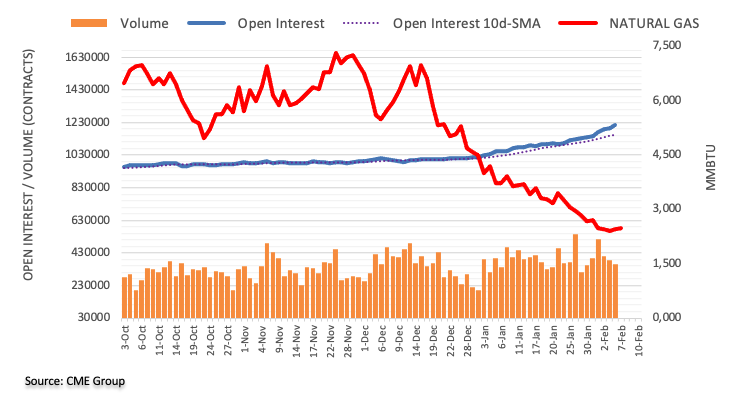
Here is what you need to know on Tuesday, February 7:
The US Dollar Index managed to build on last week's gains and closed in positive territory on Monday amid risk aversion. Early Tuesday, the US Dollar stays relatively quiet while the Australian Dollar outperforms its rivals following the Reserve Bank of Australia's (RBA) policy announcements. In the absence of high-impact data releases, investors will pay close attention to central bank speakers that include Bank of Canada Governor Tiff Macklem and FOMC Chairman Jerome Powell.
During the Asian trading hours on Tuesday, the RBA announced that it hiked its policy rate by 25 basis points to 3.35% as expected. In its policy statement, the RBA noted that the board expects further increases in interest rates. Boosted by the hawkish RBA tone, AUD/USD rose sharply and was last seen rising 0.7% on the day at around 0.6930.
RBA: Board expects further increases in interest rates.
EUR/USD extended its slide and came within a touching distance of 1.0710 before recovering modestly. As of writing, the pair was trading flat on the day near 1.0730. The data from Germany revealed that Industrial Production contracted by 3.1% on a monthly basis in December, compared to the market expectation for a decrease of 0.6%. European Central Bank (ECB) Governing Council member Isabel Schnabel will be delivering a speech later in the day.
Despite the broad-based US Dollar strength, GBP/USD stayed relatively quiet as encouraging Brexit-related headlines helped the Pound Sterling hold its ground. The Guardian reported late Monday that EU and UK negotiators have made a breakthrough in the Northern Ireland Protocol dispute. Bank of England (BoE) Chief Economist Huw Pill and BoE Deputy Governor Jon Cunliffe will speak on Tuesday.
The BoC's Market Participants Survey for the fourth quarter of 2022 showed on Monday that the median of responses for the policy rate by end-2023 stood at 4%, forecasting a 50 bps cut. USD/CAD closed in positive territory on Monday but seems to be struggling to preserve its bullish momentum early Tuesday. At the time of press, the pair was trading modestly lower on the day at 1.3425.
Following the bullish start to the week, USD/JPY is having a difficult time gaining traction early Tuesday and trading in negative territory slightly above 132.00. The data from Japan revealed earlier in the day that the Coincident Index declined to 98.9 in December's flash estimate and the Leading Economic Index edged slightly lower to 97.2 from 97.4 in November.
Gold price failed to make a decisive move in either direction on Monday before starting to stretch higher early Tuesday. With the benchmark 10-year US Treasury bond yield declining toward 3.6% following Monday's increase, XAU/USD trades in positive territory above $1,870.
Bitcoin closed in negative territory for the fifth straight day on Monday before going into a consolidation phase near $23,000 early Tuesday. Ethereum lost nearly 1% on Monday but managed to gain traction early Tuesday. At the time of press, ETH/USD was up 1.2% on the day at $1,635.
In light of the recent price action, further strength in USD/JPY should not be ruled out, comment Markets Strategist Quek Ser Leang and Senior FX Strategist Peter Chia at UOB Group.
Key Quotes
24-hour view: “We indicated yesterday that ‘further USD gains are possible but the major resistance at 133.35 might not come into view today’. Our expectations were not wrong as USD rose to high of 132.90. Upward momentum has eased somewhat and this coupled with overbought conditions suggests USD is unlikely to advance much further. We expect USD to trade sideways today, likely within a range of 131.80/133.00.”
Next 1-3 weeks: “Our view from yesterday (06 Feb, spot at 132.30) still stands. As highlighted, the outsized advance in USD last Friday and the corresponding sharp increase in upward momentum suggest it could rise further. The levels to watch are at 133.35 and 134.75. In order to keep the strong momentum going, USD must stay above the ‘strong support’ level at 130.20 (level was at 129.80 yesterday).”
India’s Monetary Policy Committee (MPC) is scheduled to announce its Interest Rate Decision on Wednesday, February 8 at 04:30 GMT and as we get closer to the release time, here are the expectations forecast by the economists and researchers of six major banks for the upcoming central bank's meeting.
RBI is expected to hike the repo rate by 25 basis points to 6.5%. At the last meeting on December 7, the bank hiked rates by 35 bps to 6.25%.
Commerzbank
“We expect RBI to hike rates further, albeit by a slower pace of 25 bps to 6.50%. This follows the aggressive hikes last year of a total of 225 bps. RBI could continue to signal further hikes, albeit more gradually, but it could still provide some support for INR.”
SocGen
“The consensus expectation for RBI’s policy decision is for a 25 bps hike, in line with our forecast. A dovish tilt from the Fed and from certain central banks in the region (Bank Indonesia), has prompted the markets to gradually price in the possibility of a pause in further tightening of financial conditions. If the RBI were to keep with this trend and deliver a ‘dovish’ 25 bps hike, this could potentially be positive for risk sentiment, adding some support to the currency. However, medium-term factors, such as an elevated trade deficit, benign portfolio inflow momentum, and low FX carry, should mean a continuation of INR’s relative underperformance vs rest of Asia FX.”
ANZ
“We expect the RBI to deliver its final 25 bps rate hike, taking the terminal repo rate in the current hiking cycle to 6.50%. Apart from the hike, we also expect a change in stance to ‘neutral’ from ‘withdrawal of accommodation’, and potentially a cut in inflation projections.”
ING
“The current repo rate is at 6.25%, which is 55 bps higher than the prevailing rate of inflation, which has since fallen back into the top end of RBI’s 2-6% tolerance range. Our contention has been that the RBI is at or close to the peak, and we believe that the RBI will put a pause on the hikes to give growth a chance.”
Standard Chartered
“We expect a 25 bps repo rate hike to 6.50%. The reduction in the size of the rate hike can be attributed to the recent softening in domestic inflation to sub-6% (upper end of the 4+/-2% band) primarily on a fall in prices of perishables (especially vegetables). With core CPI inflation remaining sticky at around 6%, the MPC will stay vigilant on inflation and is unlikely to signal any rate cuts in the near term. We also expect the MPC to maintain its ‘withdrawal of accommodation’ stance and do not see any major changes to growth and inflation projections. Given our expectation of inflation easing to 5% in FY24 (year starting April 2023) from 6.7% in FY23, we see this as the last terminal rate hike in the current policy cycle.”
TDS
“We expect the RBI to go with a final 25 bps hike and further signal that it is done with hikes by switching its stance to neutral from the stance of withdrawal of accommodation. Progress on inflation been encouraging, and the RBI may revise its quarterly CPI forecasts lower for this year and Governor Das may sound less hawkish on inflation compared to the previous meeting.”
- NZD/USD attracts some buyers on Tuesday amid a modest USD weakness.
- Hawkish Fed expectations limit the USD losses and keep a lid on the major.
- Traders now look forward to Fed Chair Powell’s speech for a fresh impetus.
The NZD/USD pair gains some positive traction on Tuesday and moves further away from a one-month low, around the 0.6270 region touched the previous day. Spot prices, however, trim a part of the intraday gains and retreat to the 0.6320-0.6325 area during the early European session.
The US Dollar edges lower and stalls the upbeat US jobs data-inspired strong recovery momentum from a nine-month low amid a modest downtick in the US Treasury bond yields. This, in turn, is seen as a key factor acting as a tailwind for the NZD/USD pair. The downside for the USD, meanwhile, remains limited amid speculations that the Federal Reserve will stick to its hawkish stance for longer.
The upbeat US monthly jobs report (NFP) released on Friday pointed to the underlying strength in the labor market and could allow the US central bank to keep raising interest rates. This should act as a tailwind for the US bond yields and lend support to the USD. Apart from this, the prevalent cautious market mood benefits the greenback's relative safe-haven status against the risk-sensitive Kiwi.
The fundamental backdrop seems tilted firmly in favour of the USD bulls, though investors might prefer to wait on the sidelines ahead of Fed Chair Jerome Powell's appearance later today. Powell's remarks on inflation and monetary policy will be looked for clues about the Fed's rate-hike path. This, in turn, will influence the USD and provide a fresh directional impetus to the NZD/USD pair.
From a technical perspective, the post-NFP slump below the 0.6425 horizontal support suggests that the path of least resistance for the NZD/USD pair is to the downside. This further makes it prudent to wait for strong follow-through buying before confirming that the recent pullback from the highest level since June 2022 has run its course and positioning for any meaningful appreciating move.
Technical levels to watch
- Gold price clings to mild gains while extending the week-start rebound from one-month low.
- US Dollar bears the burden of market’s cautious optimism to propel XAU/USD rebound.
- Fed Chair Powell needs to praise recently strong US data to challenge Gold buyers.
- US President Biden’s SOTU, Sino-American headlines also eyed for immediate directions.
Gold price (XAU/USD) picks up bids to refresh intraday high near $1,876 while printing a two-day uptrend during early Tuesday.
In doing so, the bright metal extends the week-start rebound from a monthly low as the US Dollar weakness joins cautious optimism in the market to favor the XAU/USD bulls. However, anxiety ahead of the Federal Reserve Chairman Jerome Powell and US President Joe Biden’s State of the Union (SOTU) comments seem to challenge the metal buyers of late.
The mildly positive sentiment could be linked to the comments from US Treasury Secretary Janet Yellen and President Joe Biden which pushed back the US recession concerns. On the same line were the comments from US President Joe Bide which appear to placate the Sino-American fears by saying, “The balloon incident does not weaken US-China relations.”
Alternatively, hawkish Fed talks seem to put a floor under the US Treasury bond yields, as well as the US Dollar. “The strong labor market probably means ‘we have to do a little more work,’” said Federal Reserve Bank of Atlanta President Raphel Bostic in an interview with Bloomberg. It’s worth noting that the firmer US jobs report and activity data for January renewed hawkish Fed bias the last Friday but a lack of directives seem to probe the greenback bulls afterward.
Against this backdrop, S&P 500 Futures print mild gains but the US Treasury bond yields struggle to extend the two-day rebound from the monthly low. It should be observed that the US Dollar Index (DXY) also retreats from the one-month high, marked the previous day, amid sluggish markets.
Looking ahead, Gold traders should concentrate on Fed Chair Powell’s capacity praises the latest upbeat US data, as well as US President Biden’s SOTU.
Gold price technical analysis
Gold price rebounds from one-month-old horizontal support surrounding $1,865 backed by an improvement in the oversold RSI (14), as well as the looming bull cross on the MACD.
However, 200-Simple Moving Average (SMA) surrounding $1,880 guards the XAU/USD’s immediate upside.
Even if the Gold price stays firmer past $1,880, a three-week-long resistance area around the $1,900 round figure could act as the last defense of the sellers before directing the prices towards the resistance line from mid-January, close to $1,968 at the latest.
Meanwhile, a clear downside break of $1,865 isn’t an open welcome to the Gold bears as an upward-sloping support line from December 15, 2022, around $1,850, could challenge the metal’s further downside.
Gold price: Four-hour chart
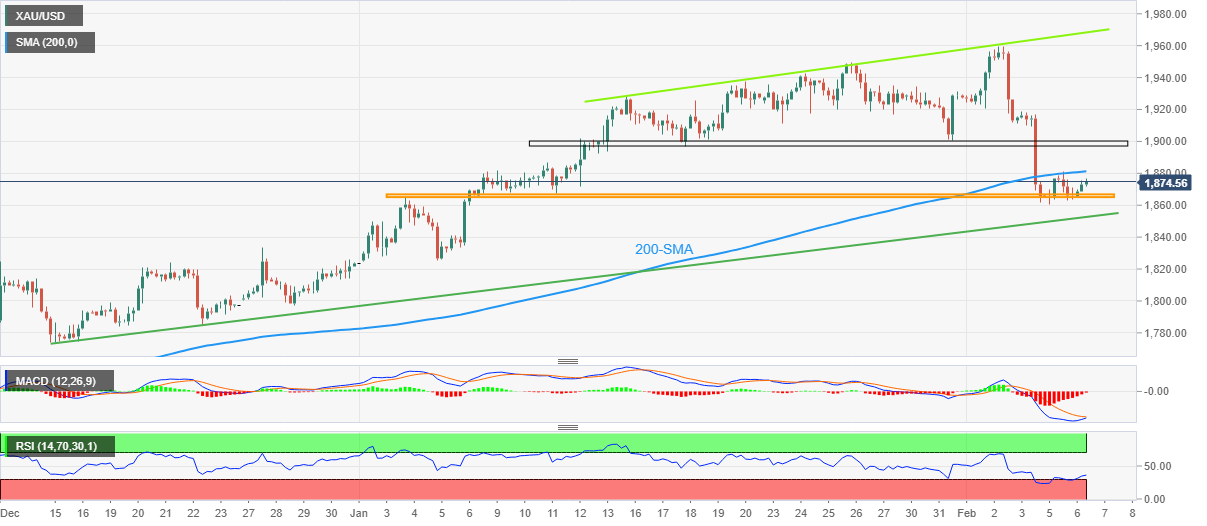
Trend: Limited recovery expected
Gold price is looking to build on the previous recovery gains as the Dollar retreats further from four-week highs. Will XAU/USD breach $1,850 on Fed Chair Powell’s speech? FXSTreet’s Dhwani Mehta analyzes the pair’s technical outlook.
Gold price stays supported above 50DMA at $1,850
“At the moment, the US Dollar is pulling back from monthly highs, as investors turn on the sidelines ahead of Jerome Powell’s speech. A fresh round of volatility is likely to be triggered by his comments, which could offer a fresh boost to the USD at the expense of Gold.”
“The four-week low of $1,860 needs to give way to initiate a fresh downswing toward the $1,850 psychological mark, where the bullish 50DMA aligns. A sustained break below the latter will see further declines toward the January 5 low of $1,825.”
“Gold could revisit the previous day’s high at $1,881 should the recovery regain traction. The next powerful barrier is seen at the $1,900 threshold.”
“It’s worth noting that XAU/USD remains exposed to downside risks so long as it stays below the 21-Daily Moving Average (DMA) at $1,912.”
CME Group’s flash data for crude oil futures markets noted traders added around 28.3K contracts to their open interest positions on Monday, extending further the ongoing uptrend. Volume, instead, kept the erratic activity and dropped by around 115.1K contracts following the previous daily build.
WTI looks supported near $72.00
Monday’s bounce off new YTD lows in prices of the WTI was on the back of increasing open interest, which is indicative that further recovery appears favoured in the very near term. There is an interim hurdle at the 55-day SMA at $77.45, while the vicinity of the $72.00 mark per barrel emerges as a decent support zone for the time being.
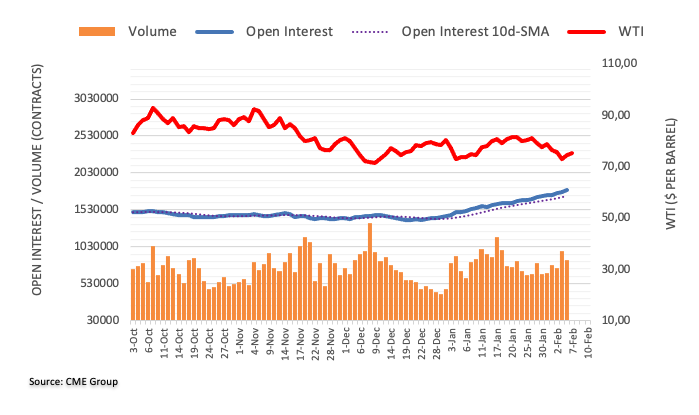
In the opinion of Markets Strategist Quek Ser Leang and Senior FX Strategist Peter Chia at UOB Group, further retracement lies ahead for NZD/USD in the short-term horizon.
Key Quotes
24-hour view: “Yesterday, we highlighted that NZD ‘is likely to weaken further but a drop below 0.6260 is unlikely.’ Our view was correct as NZD dipped to 0.6271 before rebounding to close at 0.6305 (-0.36%). Downward pressure has eased and NZD appears to have moved into a consolidation phase and it is likely to trade between 0.6280 and 0.6340 today.”
Next 1-3 weeks: “There is no change in our view from yesterday (06 Feb, spot at 0.6315) where the risk for NZD has shifted the risk to the downside to 0.6260. Further decline is possible but at this stage, the chance of a break of 0.6195 is not high. Overall, only a breach of 0.6425 (no change in ‘strong resistance’ level from yesterday) would indicate that the downside risk has faded.”
- The index faces some selling pressure near recent tops.
- US yields also give away part of the recent marked rebound.
- Chief Powell will take centre stage later in the NA session.
The greenback, when measured by the USD Index (DXY), comes under some downside pressure and recedes from tops near 103.80 (February 6) on turnaround Tuesday.
USD Index now looks at Powell
After three consecutive daily advances, some loss of momentum in the buying interest around the dollar now drags the index to the 103.50/40 band after climbing to multi-week highs near 103.80 at the beginning of the week.
Indeed, DXY trades in a context of rising expectation ahead of the participation by Chair Powell in a discussion panel at the Economic Club of Washington later in the European evening. Powell’s event has grown in importance as of late, particularly following the solid prints from January Nonfarm Payrolls (+517K).
In the US data space, December’s Balance of Trade figures are due followed by the Consumer Credit Change and the speech by FOMC’s M.Barr (permanent voter, centrist).
What to look for around USD
The dollar gives away a small part of the recent 3-day strong rebound to the 103.80 region, as the upcoming speech by Fed’s Powell prompts some prudence among market participants.
The idea of a probable pivot/impasse in the Fed’s normalization process now looks mitigated in favour of a tighter-for-longer narrative, which appears almost exclusively underpinned by the recent NFP prints.
The loss of traction in wage inflation, however, seems to lend some support to the view that the Fed’s tightening cycle have started to impact on the robust US labour markets somewhat.
Key events in the US this week: Balance of Trade, Fed Powell, Consumer Credit Change (Tuesday) – MAB Mortgage Applications, Wholesale Inventories (Wednesday) – Initial Jobless Claims (Thursday) – Flash Consumer Sentiment (Friday).
Eminent issues on the back boiler: Rising conviction of a soft landing of the US economy. Slower pace of interest rate hikes by the Federal Reserve vs. shrinking odds for a recession in the next months. Fed’s pivot. Geopolitical effervescence vs. Russia and China. US-China trade conflict.
USD Index relevant levels
Now, the index is retreating 0.20% at 103.41 and the breach of 100.82 (2023 low February 2) would open the door to 100.00 (psychological level) and finally 99.81 (weekly low April 21 2022). On the upside, the next barrier emerges at 103.76 (monthly high February 6) seconded by 105.63 (2023 high January 6) and then 106.45 (200-day SMA).
- EUR/USD seesaws around intraday high as it snaps three-day downtrend.
- Oversold RSI underpins corrective bounce off short-term key support.
- Bearish MACD signals join 200-SMA to challenge Euro bulls.
- Downside bias remains intact below 1.0830, ascending trend line from late November acts as additional support.
EUR/USD grinds near an intraday high of 1.0743 as it bounces off a five-week-old horizontal support during the early Tuesday in Europe. The major currency pair’s latest gains could also be linked to the oversold RSI (14).
However, the bearish MACD signals and the 200-SMA, close to 1.0765 by the press time, challenge the quote’s immediate upside.
Even if the quote stays firmer past 1.0765 SMA hurdle, a downward-sloping resistance line from the last Thursday, around 1.0830 at the latest, could act as the last defense of the EUR/USD bears.
Following that, the 1.0900 and the 1.1000 psychological magnet may act as buffers before directing the pair towards the latest swing high surrounding 1.1035.
Meanwhile, multiple levels marked since late December 2022, around 1.0710, challenge the EUR/USD bears. Also acting as short-term support is the 1.0700 round figure.
In a case where the EUR/USD pair remains bearish past 1.0700, an ascending support line from late November 2022, near 1.0650 as we write, will be important to watch.
It’s worth noting that the EUR/USD weakness below 1.0650 makes it vulnerable to refreshing the yearly low, currently around 1.0480.
EUR/USD: Four-hour chart
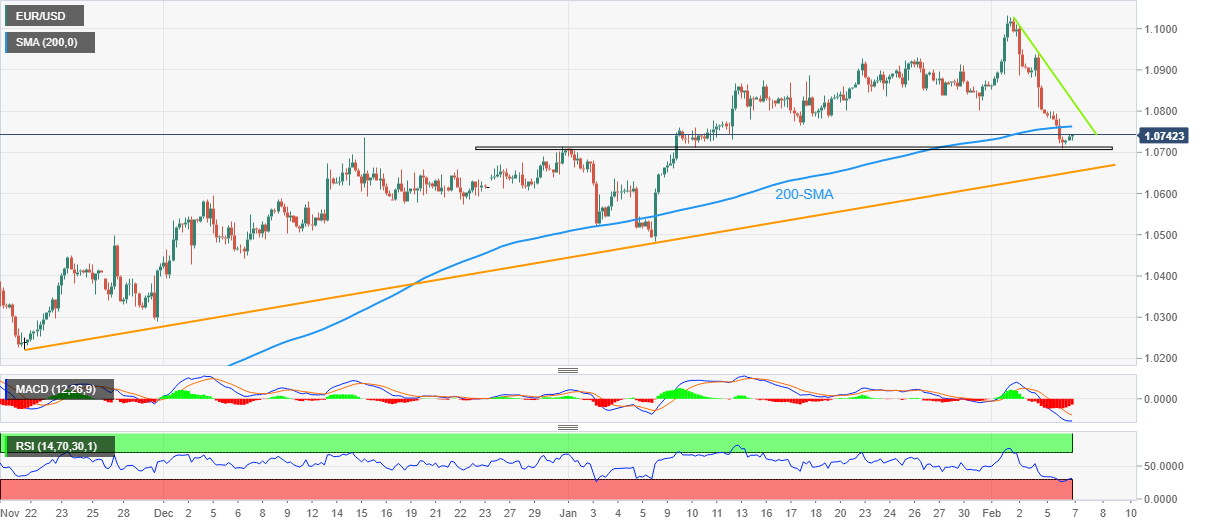
Trend: Limited recovery expected
- USD/CAD has picked strength after dropping to near 1.3400 as the risk-off impulse has rebounded.
- Federal Reserve’s Powell might sound hawkish in his commentary amid a fresh rise in the US NFP data.
- Bank of Canada’s Macklem to dictate rationale behind pausing policy tightening spell.
- USD/CAD has faced barricades while attempting to deliver a Filling Channel breakout.
USD/CAD has sensed buying interest after a drop to near the round-level support at 1.3400 in the early European session. The Loonie asset has recovered to near 1.3430 and is demonstrating volatility as investors are getting anxious ahead of the speech from Federal Reserve (Fed) chair Jerome Powell and Bank of Canada (BoC) Governor Tiff Macklem, scheduled for Tuesday.
The US Dollar Index (DXY) has gauged cushion around 103.10 after a corrective move, which has also supported USD/CAD. S&P500 futures have surrendered some gains recorded in the Asian session, portraying that the recovery movement in the risk-on impulse is fading away. A decline in investors’ risk appetite could be the outcome of anxiety among investors ahead of the central banks’ speech, which will provide fresh impetus.
The return generated by the 10-year US Treasury yields has dropped to near 3.62%, however, the upside bias is still intact.
Fed Powell might sound hawkish after upbeat US employment data
Investors are keenly awaiting the speech from Federal Reserve chair Jerome Powell for the interest rate guidance. December’s United States economic calendar showed a decline in consumer spending, a steep correction in the Producer Price Index (PPI) figures, and a slowdown in economic activities, which triggered the odds that the Federal Reserve might consider a pause in the interest rates and will observe the impact of higher interest rates for a period of time.
However, skyrocketing employment numbers and job openings despite weakening activities are indicating that firms are optimistic toward forward demand, which can trigger a rebound in the declining spell of the United States Consumer Price Index (CPI). Therefore, hawkish guidance on interest rates cannot be ruled out.
Investors seek rationale behind BoC’s policy tightening pause
After pushing interest rates vigorously to 4.5%, the highest level in the past 15 years, Bank of Canada Governor Tiff Macklem explicitly paused the policy tightening. The central bank believes that they have much done to the interest rate and the disinflationary process has already started. Therefore, a pause in policy tightening spell looks satisfactory at this current juncture. Therefore, BoC Governor Tiff Macklem might sound less hawkish on interest rate guidance.
It seems that investors are also showing confidence that the current monetary policy by the Bank of Canada is restrictive enough to contain inflation. The Market Participants Survey for the fourth quarter of 2022 published by the Bank of Canada showed on Monday that the median of responses for the policy rate by the end-2023 stood at 4%, forecasting a 50 bps cut.
Also, the median forecast for the real Gross Domestic Product (GDP) points to a fall of 0.4% in 2023 and an expansion of 2% in 2024.
Oil soars above $75.00 amid hopes of China’s economic recovery
Oil price has extended its recovery above the critical resistance of $75.00 on expectations that the economic recovery in China will be quicker than expected. The commentary from International Energy Agency (IEA) Executive Director Fatih Birol on the sidelines of the India Energy Week conference on Sunday that “Oil producers may have to reconsider their output policies following a demand recovery in China, the world's second-largest oil consumer,” as reported by Reuters has infused an adrenaline rush into the oil bulls. He further claimed, “Half of the growth in global oil demand this year will come from China.”
It is worth noting that Canada is a leading exporter of oil to the United States and higher oil price will strengthen the Canadian Dollar ahead.
USD/CAD technical outlook
-638113477725050614.png)
USD/CAD is facing barricades while attempting to break the Falling Channel chart pattern on the upside on an hourly scale. The Loonie asset has dropped marginally, however, the upside bias cannot be ruled out.
The 50-period Exponential Moving Average (EMA) at 1.3407 is acting as major support for the US Dollar bulls.
Meanwhile, the Relative Strength Index (RSI) (14) has shifted into the 40.00-60.00 range from the bullish range of 60.00-80.000, which indicates a loss in the upside momentum.
Extra decline in GBP/USD remains well on the cards for the time being, note Markets Strategist Quek Ser Leang and Senior FX Strategist Peter Chia at UOB Group.
Key Quotes
24-hour view: “We highlighted yesterday that ‘the oversold decline has scope to dip below 1.2000 before stabilization is likely.’ Our view did not materialize as GBP dipped to 1.2006 before recovering slightly to close at 1.2022 (-0.22%). While we still see room for GBP to move below 1.2000, any weakness is viewed as part of a lower trading range of 1.1980/1.2060. In other words, we do not expect a sustained decline below 1.1980.”
Next 1-3 weeks: “There is not much to add to our update from yesterday (06 Feb, spot at 1.2050). As highlighted, further increase in downward momentum suggests more GBP weakness but it remains to be seen if the significant support at 1.1845 will come into view. Overall, only a breach of 1.2150 (‘strong resistance’ level was at 1.2200 yesterday) would indicate that the weakness that started late last week has run its course.”
Open interest in gold futures markets shrank for the third session in a row on Monday, this time by around 7.5K contracts according to preliminary readings from CME Group. Volume followed suit and dropped markedly by more than 152K contracts after four daily builds in a row.
Gold: Decent support emerges around $1860
Gold prices started the week with modest gains. Monday’s uptick, however, was on the back of diminishing open interest and volume leaving the current recovery somewhat limited. In the meantime, the yellow metal looks well supported around the $1860 region.

- USD/CHF holds lower grounds near intraday low bottom, snaps three-day winning streak.
- US Dollar retreats as yields struggle amid mixed clues, light calendar and cautious mood.
- Swiss Unemployment Rate, Fed’s Powell and US President Biden’s SOTU eyed for fresh impulse.
USD/CHF clings to mild losses around 0.9265, after a three-day uptrend, as the US Dollar consolidates amid sluggish markets.
Adding strength to the Swiss Franc (CHF) pair’s pullback could be the cautious optimism in the market, as well as a light calendar. It’s worth mentioning that the anxiety ahead of a speech from Federal Reserve Chairman Jerome Powell and US President Joe Biden’s State of the Union (SOTU) comments also weigh on the quote of late. In doing so, the USD/CHF price retreats from the highest levels in three weeks.
That said, the US Dollar Index (DXY) traces sluggish yields to ease from a one-month high, down 0.18% intraday near 103.45 by the press time.
It’s worth noting that the growth optimism conveyed by US Treasury Secretary Janet Yellen and President Joe Biden seemed to have probed the US Dollar bulls. On the same line were the comments from US President Joe Bide which appear to placate the matter by saying, “The balloon incident does not weaken US-China relations.”
Even so, hawkish Fed talks seem to put a floor under the US Treasury bond yields, as well as the US Dollar. “The strong labor market probably means ‘we have to do a little more work,’” said Federal Reserve Bank of Atlanta President Raphel Bostic in an interview with Bloomberg. It’s worth noting that the firmer US jobs report and activity data for January renewed hawkish Fed bias the last Friday but a lack of directives seem to probe the greenback bulls afterward.
As a result, today’s speech from Fed Chair Powell will be closely observed as the US central bank appeared dovish in its latest monetary policy meeting and drowned the USD. Also important will be how well US President Biden is prepared to propel the world’s biggest economy amid looming recession fears.
Other than the stated speeches, the Swiss Unemployment Rate for January, expected to ease to 1.8% from 1.9%, will also be important for the USD/CHF pair traders to watch for clear directions.
Technical analysis
An 11-week-old descending resistance line, around 0.9285 by the press time, restricts short-term USD/CHF advances. The downside moves, however, will need validation from the 21-DMA support of 0.9218 to recall the pair sellers.
Markets Strategist Quek Ser Leang and Senior FX Strategist Peter Chia at UOB Group suggest EUR/USD could grind lower to the 1.0615 level in the near term.
Key Quotes
24-hour view: “We expected EUR to drop below 1.0755 yesterday and we held the view that ‘the next support at 1.0700 is unlikely to come under threat’. Our view was not wrong even though EUR dropped close to 1.0700 (low has been 1.0708). While conditions remain oversold, EUR could dip below 1.0700 before stabilization is likely. We do not expect the next major support at 1.0615 to come into view today (there is another support at 1.0670). Resistance is at 1.0750, followed by 1.0785. A break of the latter level would indicate that the weakness in EUR has stabilized.”
Next 1-3 weeks: “Yesterday (06 Feb, spot at 1.0795), we indicated that the price actions in EUR are likely the early stages of a pullback that could extend to 1.0700. While our view was not wrong, we didn’t quite expect EUR to approach 1.0700 so quickly (EUR dropped to a low of 1.0708 in NY trade). Further EUR weakness appears likely but oversold short-term conditions could slow the pace of any further decline. The next level to monitor below 1.0700 is at 1.0615. The downside risk in EUR is intact as long as it does not break above 1.0850 (‘strong resistance’ level was at 1.0890 yesterday).”
- AUD/USD retreats from previous support line, pares the first daily gains in four while bouncing off the key support confluence.
- RBA-inspired gains join 0.6860-65 support confluence to portray recovery moves.
- Bearish MACD signals, failure to cross support-turned-resistance tease Aussie pair bears.
- RBA’s hawkish move failed to impress Aussie bulls for long amid talks of easing inflation.
AUD/USD pares intraday gains around 0.6930 as bulls struggle near the short-term key hurdle heading into Tuesday’s European session. In doing so, the Aussie pair fades the bounce off a one-month low while snapping a three-day downtrend.
That said, the Reserve Bank of Australia’s (RBA) 0.25% rate hike, as expected, underpinned the AUD/USD pair’s rebound from the 0.6860-65 support confluence comprising the 50-DMA and 61.8% Fibonacci retracement of its June-October 2022 downside.
Also read: AUD/USD Outlook: Bulls look to seize back control on RBA’s hawkish outlook
It’s worth noting, however, that the mentioning of the fears of receding inflation fears and the inability to cross the support-turned-resistance line from early November 2022, close to 0.6930 by the press time, challenges the AUD/USD pair buyers.
In a case where the Aussie pair stays firmer past 0.6930, the odds of its run-up toward the 0.7000 psychological magnet can’t be ruled out. However, highs marked during August 2022 and the monthly top, close to 0.7135 and 0.7160 in that order, could challenge the AUD/USD bulls afterward.
Meanwhile, AUD/USD pullback remains elusive unless breaking the 0.6860 support confluence.
Even so, the 200-DMA support, around 0.6810 by the press time, could challenge the Aussie pair sellers. Also acting as the downside filter is the 0.6800 threshold, a break of which could quickly drag prices toward January’s low near 0.6685.
AUD/USD: Daily chart
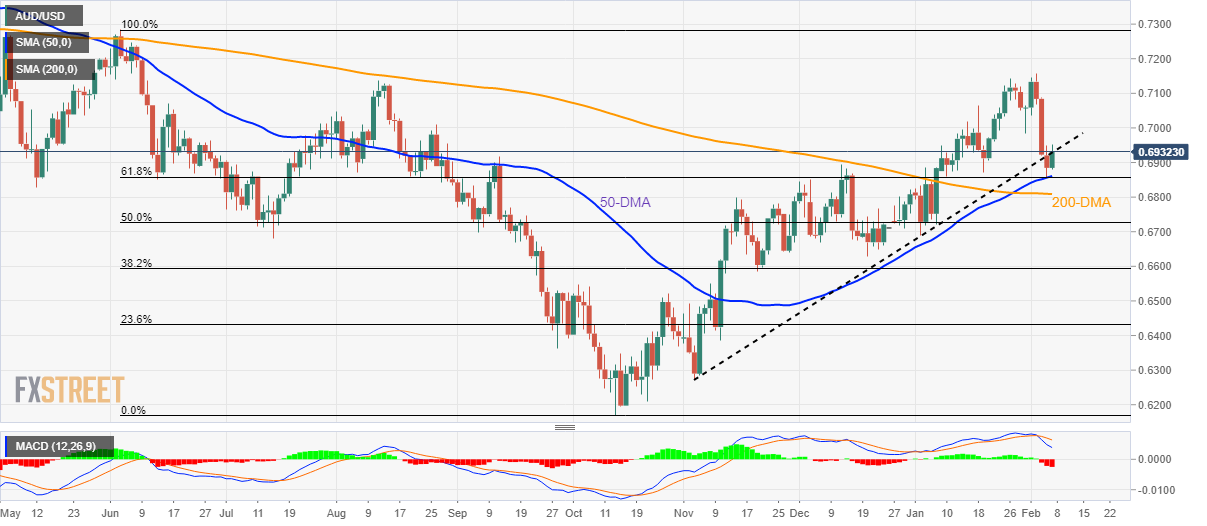
Trend: Pullback expected
- USD/INR grinds higher around monthly peak, bulls take a breather after three-day uptrend.
- Cautious sentiment ahead of Fed Chair Jerome Powell’s speech, RBI interest rate decision probes the Indian Rupee pair traders.
- Firmer Oil price, hopes of dovish guidance from RBI joins hawkish hopes from Fed to keep buyers hopeful.
- Reuters poll signals hardships for Indian Rupee buyers moving forward.
USD/INR traders struggle for clear directions around the highest levels in a month, making rounds to 82.80 during the initial hour of Tuesday’s Indian trading session. In doing so, the Indian Rupee pair portrays the market’s cautious mood ahead of the key events, namely a speech from Federal Reserve (Fed) Chairman Jerome Powell and the Reserve Bank of India (RBI) monetary policy announcements, up for publishing on late Tuesday and early Wednesday respectively.
Talking about the pair's positive catalysts, growth optimism conveyed by US Treasury Secretary Janet Yellen and President Joe Biden seemed to have probed the US Dollar bulls. The same joined hawkish Fed talks seem to put a floor under the US Treasury bond yields, as well as the US Dollar. “The strong labor market probably means ‘we have to do a little more work,’” said Federal Reserve Bank of Atlanta President Raphel Bostic in an interview with Bloomberg.
On the same line could be upbeat prices of Oil as it negatively affects the Indian Rupee (INR) due to the nation’s reliance on energy imports and record deficit. That said, WTI crude oil rises 0.70% intraday to $75.15 as it extends the previous day’s rebound from a two-month low.
It’s worth noting that the hopes of the RBI’s dovish hike also propel the USD/INR prices. The Reserve Bank of India is also near the end of a modest campaign to increase interest rates, and is due to deliver a final 25 basis point rise, to 6.50%, on Wednesday, per Reuters. The news also mentioned that the central bank's inflation forecast and management of the government's borrowing program will be scrutinized, while Governor Shaktikanta Das might also face questions on the banking sector's exposure to the embattled Adani Group.
Elsewhere, fears of a softer Indian Rupee, per a Reuters poll, also keep USD/INR buyers hopeful. “The latest Reuters poll of 43 foreign exchange analysts, taken after the Feb. 1 budget, showed the rupee strengthening just over 1% to 81.75 per dollar in the next six months,” said the survey findings.
Meanwhile, fears of a surprise move by the RBI and the recently upbeat budget seem to challenge the USD/INR pair buyers amid the broad pullback in the US Treasury bond yields and the US Dollar amid a sluggish Asian session on Tuesday.
Amid these plays, S&P 500 Futures print mild gains while stocks in Australia print mild losses at the latest.
Moving on, Fed Chair Powell’s capacity praises latest upbeat US data could help USD/INR bulls but RBI’s surprise hawkish move may probe the pair buyers. Also important to watch will be US President Joe Biden’s State of the Union (SOTU).
Technical analysis
A downward-sloping trend line from October 2022 challenges the immediate USD/INR upside near 82.80 ahead of the late 2022 peak surrounding 83.20, a break of which can’t stop the bulls from refreshing the all-time high. Meanwhile, pullback moves need a daily closing below the 100-DMA support surrounding 82.00 to recall the Indian Rupee pair bears.
- Gold price has sensed selling pressure after encountering significant offers near $1,875.00.
- A topsy-turvy performance is expected from the USD Index ahead of Fed Powell’s speech.
- The battle between the Fed and higher inflation could get uglier amid a fresh rise in US employment data.
Gold price (XAU/USD) is facing pressures in recovery extension above the critical resistance of $1,875.00 in the Asian session. The precious metal has sensed selling interest as the US Dollar Index (DXY) has attempted a recovery after correcting to near 103.10. A topsy-turvy performance is expected from the USD Index as investors are awaiting the speech from Federal Reserve (Fed) chair Jerome Powell for fresh impetus.
The USD Index (DXY) was highly expected to demonstrate some volatility contraction signs after a three-day winning streak post mammoth United States Nonfarm Payrolls (NFP) data. The USD Index bulls have exhausted after a sheer ride, and the upside bias is still intact. S&P500 futures are holding minor gains recorded in the Asian session.
The speech from Fed chair Jerome Powell ahead has become significant amid a fresh rise in the employment numbers in the United States labor market. After observing a meaningful decline trend in inflation, the street started expecting a pause in the policy tightening spell by the Fed. However, the upbeat January employment data has conveyed that the battle against inflation has a lot of steam left.
Gold technical analysis
Gold two-hour chart
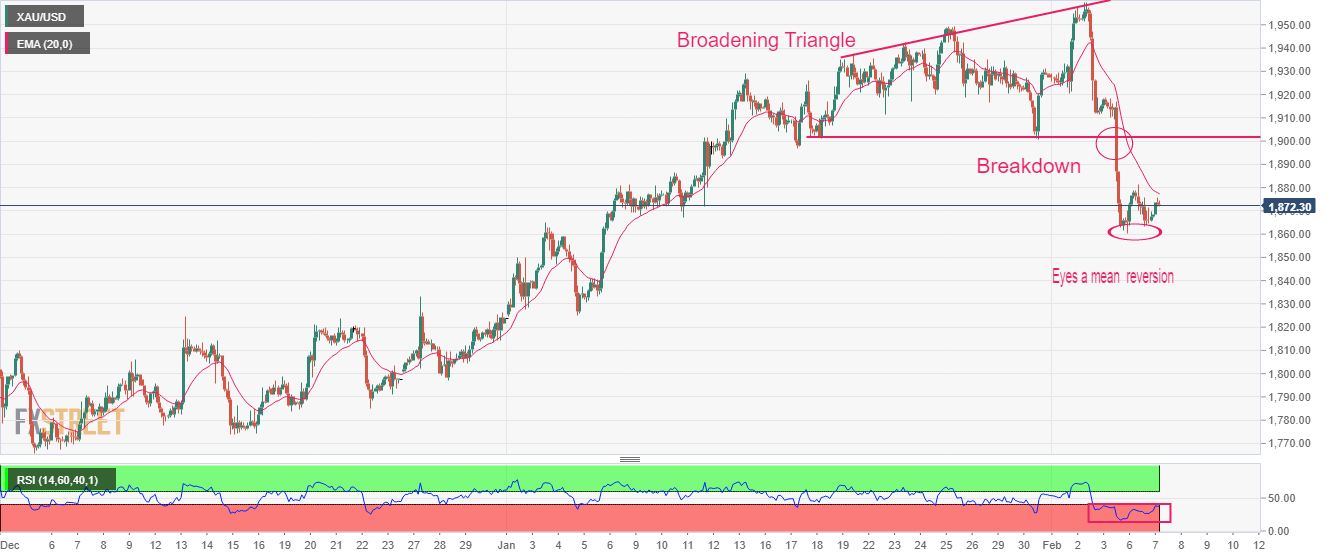
New Zealand’s new Prime Minister Chris Hipkins said ahead of his meeting with Australia’s Prime Minister Anthony Albanese on Tuesday, he will voice his criticism of China where necessary.
On Monday, the Australian and Chinese trade and commerce ministers conducted pragmatic and candid exchanges, providing fuel for the Australian Dollar.
Market reaction
At the time of writing, NZD/USD is holding gains at around 0.6320, adding 0.28% on the day.
- USD/JPY retreats from one-month high to snap two-day uptrend.
- RSI pullback from overbought territory favors the Yen pair’s U-turn.
- Bullish MACD signals, sustained trading beyond the previous key resistance, 200-SMA favor bulls.
USD/JPY grinds near intraday low during the first loss-making day in three, mildly offered near 132.30 heading into Tuesday’s European session.
In doing so, the Yen pair takes clues from the RSI (14) to retreat from the 50% Fibonacci retracement level of the pair’s moves between the last December and January 2023. Even so, the quote remains on the bull’s radar as it keeps the previous week’s upside break of the key hurdles, now supports.
That said, the RSI retreat from the overbought territory and hence consolidation of the latest run-up appears logical. However, the bullish MACD signals and the successful trading beyond the resistance-turned-support levels seem to favor the Yen pair buyers.
The 200-SMA level surrounding 130.80 appears to be the immediate support for the USD/JPY bears to watch ahead of the 130.00 psychological magnet.
Following that, the previous resistance line from mid-December 2022, near 129.40 at the latest, could act as the last defense of the USD/JPY bulls.
On the contrary, a clear upside break of the 50% Fibonacci retracement level of 132.75 could propel the USD/JPY towards the 61.8% Fibonacci retracement, also known as the golden level of 134.05.
Even if the Yen pair remains firmer past 134.05, January’s top close to 134.80 may challenge the upside momentum.
USD/JPY: Four-hour chart
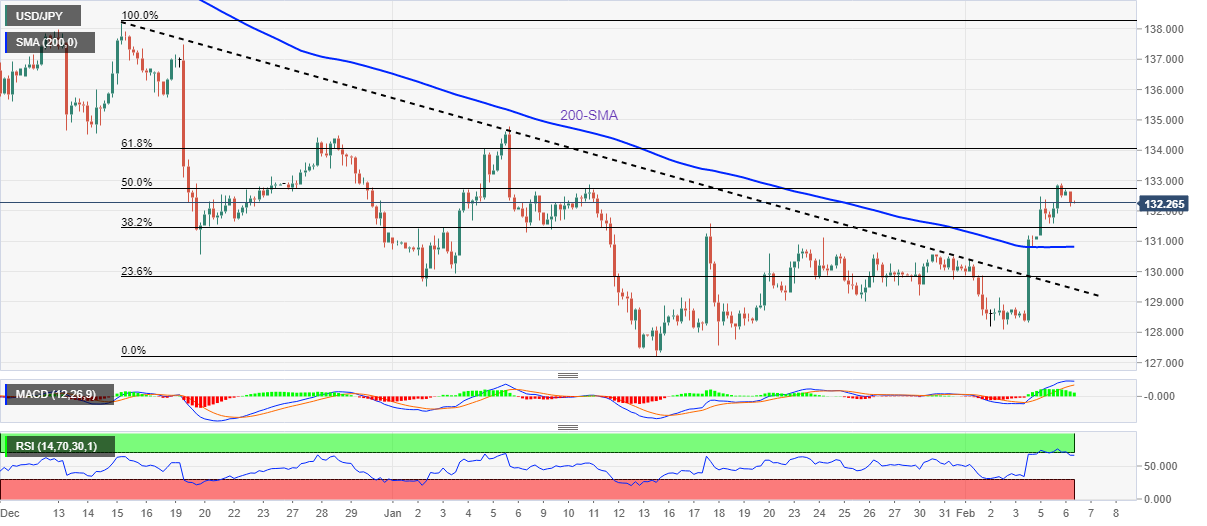
Trend: Further upside expected
- EUR/USD retreats from intraday high, fades bounce off one-month low amid sluggish session.
- Cautious optimism, mixed concerns surrounding Fed, ECB probe Euro traders.
- Policymakers from ECB, Fed could entertain traders but major attention will be given to the yields and risk catalysts.
- Pair sellers will seek confirmation of recently hawkish bias for the US Dollar, upbeat yields.
EUR/USD fades the early Asian session recovery by retreating from the daily top. Even so, the major currency pair clings to the first daily gains in four around 1.0740 during early Tuesday in Europe.
The quote’s latest retreat could be linked to the fresh uptick in the US Dollar Index (DXY), following a downbeat start of the day. It’s worth noting that the DXY jostles with the 50-DMA amid an inactive session ahead of the key central speeches, mainly from Europe and the US.
Other than the pre-event anxiety and the light calendar, the DXY’s bounce off the intraday low traces the US Treasury bond yields. That said, the benchmark 10-year Treasury yields pick up bids to reverse the initial pullback but stay mostly inactive near 3.62% by the press time.
The comments favoring hawkish actions from the Federal Reserve (Fed) officials and receding recession woes surrounding the US, as per Federal Reserve Bank of Atlanta President Raphel Bostic, US Treasury Secretary Janet Yellen and President Joe Biden, also probe the EUR/USD bulls.
It’s worth noting, however, that the strong points of the Eurozone Sentix Investor Confidence index, Retail Sales and German Factory Orders fail to put a bid under the EUR/USD prices as the ECB policymakers appear a bit less hawkish than their Fed counterparts. On Monday, European Central Bank (ECB) policymaker Robert Holzmann said that the risk of doing too little dwarfs the risk of the over-tightening policy.
Against this backdrop, US stock futures print mild gains and the equities in the Asia-Pacific region remain sidelined, which in turn keeps the EUR/USD buyers hopeful ahead of speeches from the ECB and the Federal Reserve (Fed) officials. Also important to watch will be US President Joe Biden’s State of the Union (SOTU), not to forget Germany’s Industrial Production for December.
Technical analysis
EUR/USD bears remain hopeful unless witnessing a clear downside break of an ascending trend line from early November, around 1.0850 by the press time.
- AUD/NZD has climbed to near 1.0985 as the RBA has pushed interest rates by 25 bps as expected.
- A 25 bps interest rate hike RBA has pushed the OCR to 3.35%.
- The RBA is expecting inflation to soften this year without seeing signs of an Australian recession.
The AUD/NZD pair has displayed a stellar upside move above 1.0980 as the Reserve Bank of Australia (RBA) has announced a hike in the Official Cash Rate (OCR) by 25 basis points (bps). The extent of the hike in the OCR has remained in line with expectations, which has pushed the OCR to 3.35%. This is the fourth consecutive 25 bps interest rate hike by the RBA and the ninth consecutive interest rate hike after the pandemic period.
The street was already expecting a hawkish monetary policy from RBA Governor Philip Lowe as Australian inflation has not shown signs of a slowdown yet. Australian Consumer Price Index (CPI) has already reached 7.8% amid a tight labor market and is not responding as expected by higher interest rates.
In the February monetary policy statement presented by RBA Governor Philip Lowe, the central bank sees inflation softening this year due to both global factors and slower growth in domestic demand. The RBA has forecasted an increase in the Unemployment Rate to 3.75% by the end of this year and 4.5% by mid-2025. While the Gross Domestic Product (GDP) growth is expected to slow to around 1.5% in 2023 and 2024. It is worth noting that the central bank doesn’t see signs of recession in the Australian economy despite an extremely restrictive monetary policy.
On the New Zealand front, higher interest rates by the Reserve Bank of New Zealand (RBNZ) to contain soaring inflation have started impacting the employment data. New Zealand employment data remained downbeat last month and signs of a slowdown in its inflation rate indicate that RBNZ Governor Adrian Orr could sound less hawkish in its upcoming monetary policy this month.
- GBP/USD picks up bids to refresh intraday high, snaps three-day downtrend to recover from one-month low.
- Nearly oversold RSI triggers corrective bounce but bears stay hopeful.
- Clear downside break of previous key support lines, bearish MACD signals favor sellers.
- Cable buyers remain confused unless crossing 1.2450 hurdle.
GBP/USD consolidates recent losses while picking up bids to 1.2050 during early Tuesday morning in Europe, printing the first daily gains in four. In doing so, the Cable pair justifies the nearly oversold RSI (14) as traders await fresh clues.
Even so, the quote holds on to the previous week’s downside break of the key support lines from October and September 2022, now resistance around 1.2150 and 1.2275 in that order.
Also keeping the Cable bears hopeful is the clear U-turn from the two-month-old horizontal resistance area surrounding 1.2450.
As a result, the GBP/USD rebound remains elusive unless it crosses the 1.2450 resistance while the 1.2150 appears the nearby hurdle for the intraday buyers to cross.
In a case where the Cable pair stays firmer past 1.2450, the May 2022 high near 1.2665 could lure the bulls.
On the flip side, the 1.2000 psychological magnet puts a floor under the GBP/USD prices ahead of the 200-DMA support of 1.1950.
Following that, the previous monthly low near 1.1840 and the September high around 1.1735 could challenge the pair sellers before giving them control.
GBP/USD: Daily chart
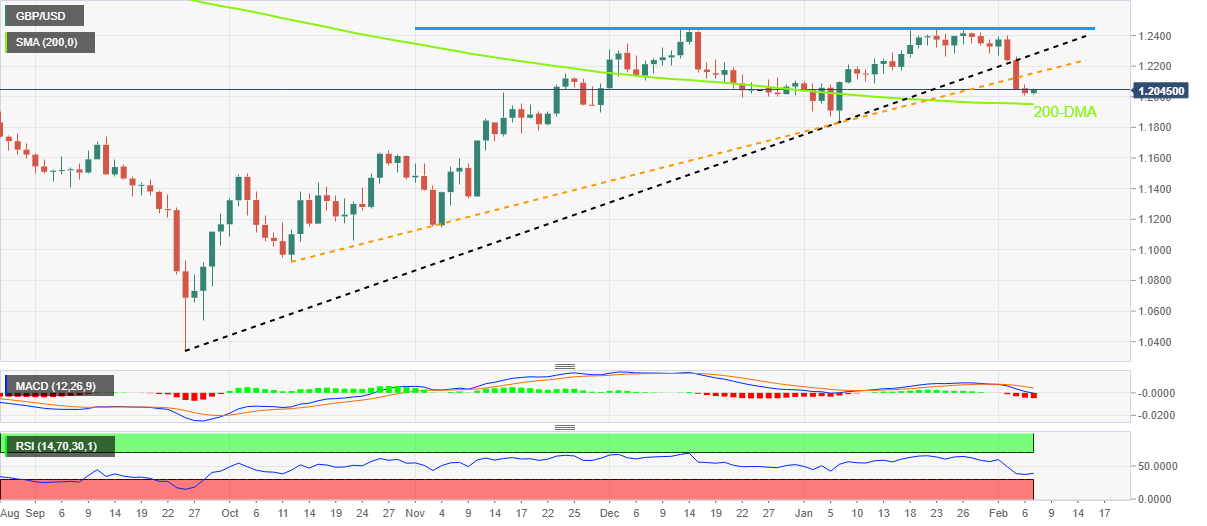
Trend: Further downside expected
- AUD/JPY adds to intraday gains even as RBA’s 0.25% rate hike.
- RBA matches market forecasts but fails to please hawks by expecting softer inflation.
- BoJ’s Kuroda struggle to push back hawkish bias, MoF Japan confirms market intervention.
- Sluggish sentiment also act as an upside filter.
AUD/JPY takes the bids to refresh intraday high near 92.00 Reserve Bank of Australia (RBA) announced the fourth consecutive 0.25% hike in the benchmark interest rate during early Tuesday. RBA matches the market forecasts and allowed the cross-currency pair to remain firmer for the second consecutive day.
As the move was widely priced-in and the Aussie central bank failed to offer any major hawkish clues, the AUD/JPY failed to cheer the rate lift and clings to mild gains during two-day uptrend. The RBA’s inability to please the pair buyers could be linked to the statements expecting softer inflation moving forward.
Also read: Breaking: RBA raises OCR by 25 bps to 3.35% in February, as expected
In addition to the RBA’s inability to please Aussie bulls, hawkish concerns surrounding the Bank of Japan’s (BoJ) next moves and Japan’s money market interventions seem to challenge the AUD/JPY bulls, despite the initial spike.
On Monday, Bank of Japan (BoJ) Governor Haruhiko Kuroda said that the central bank will seek to achieve 2% inflation in a stable, sustainable manner while keeping an eye out on side effects. Earlier in the week, chatters surrounding the BoJ Deputy Governor Masayoshi Amamiya’s selection as the next Japanese central bank leader and the hawkish results of the same seem to have teased the Japanese Yen (JPY) traders.
During the Asian session, Reuters mentioned that the Bank of Japan's (BoJ) aggressive market operations to defend its policy band for yields has not only sapped liquidity in the government bond market but also drastically limited the scope for speculation in bond futures. Following that, Japanese Ministry of Finance (MoF) confirmed stealth market intervention during October 21 and 24 of the last year.
On a different page, sluggish yields also challenge AUD/JPY buyers as the US 10-year Treasury bond yields probe two-day uptrend by retreating to 3.619% at the latest.
It’s worth noting that the market sentiment remains indecisive as the previous day’s fears of US-China tussles over the balloon shooting seemed to have faded while the Aussie-China ties appear to improve of late. On the same line were the receding fears of the global recession.
Amid these plays, S&P 500 Futures print mild gains while stocks in Australia print mild losses at the latest.
Moving on, the preliminary readings of Japan’s Coincident Index and Leading Economic Index for January may entertain AUD/JPY traders but major attention will be given to the BoJ chatters and risk catalysts like recession woes and the US-China tussles.
Technical analysis
A three-week-old bull flag formation keeps AUD/JPY buyers hopeful unless the quote drops back below the 90.00 psychological magnet.
- AUD/USD has soared to near 0.6950 as RBA has announced a 25 bps interest rate hike to 3.35%.
- RBA’s Lowe has announced a fourth consecutive OCR hike by 25 bps to tame the historic inflation.
- Easing US-China tensions have supported the risk appetite of investors.
The AUD/USD pair has climbed to near 0.6950 as the Reserve Bank of Australia (RBA) has increased the Official Cash Rate (OCR) by 25 basis points (bps), as expected by the street. A fourth consecutive 25 bps rate hike by RBA has pushed the OCR to 3.35%. . This is the ninth consecutive interest rate hike by RBA Governor Philip Lowe to tame stubborn inflation.
A hawkish interest rate policy was widely anticipated by the RBA as the Australian Consumer Price Index (CPI) showed a historic surge in the fourth quarter of CY2022. Households in the Australian regions are bearing the higher cost of living pressures amid the absence of slowdown signals in the overall inflation figures.
Meanwhile, easing tensions between the United States and China have brought some optimism for the Australian Dollar. US President Joe Biden conveyed that the spy balloon incident doesn’t weaken US-China relations. Apart from that, International Energy Agency (IEA) Executive Director Fatih Birol's faith in hopes of China’s economy, stating that “Half of the growth in global oil demand this year will come from China.” has also infused optimism for the Australian Dollar.
It is worth noting that Australia is a leading trading partner of China and rising hopes for an economic recovery in China support the Australian Dollar.
A recovery move by the S&P500 futures as investors shrugged off uncertainty over hawkish Federal Reserve (Fed) bets has weakened the risk aversion theme. Improved risk appetite has also impacted the US Dollar Index (DXY), which has corrected to near 103.10. The return generated by 10-year US Treasury bonds has slipped below 3.62%.
Later the day, the speech from Fed chair Jerome Powell will be keenly watched. The speech from Fed Powell will provide cues about the likely monetary policy action ahead.
Following are the key headlines from the February Reserve Bank of Australia (RBA) monetary policy statement, via Reuters, as presented by Governor Phillip Lowe.
Inflation is expected to decline this year due to both global factors and slower growth in domestic demand.
Board expects further increases in interest rates.
Board resolute in its determination to return inflation to target.
The central forecast is for cpi inflation to decline to 4¾ per cent this year and to around 3 per cent by mid-2025.
GDP growth expected to slow to around 1½ per cent over 2023 and 2024.
Path to achieving a soft landing remains a narrow one.
The labour market remains very tight.
Central forecast is for the unemployment rate to increase to 3¾ per cent by the end of this year and 4½ per cent by mid-2025.
Wages growth is continuing to pick up from the low rates of recent years and a further pick-up is expected due to the tight labour market and higher inflation.
Some households have substantial savings buffers, but others are experiencing a painful squeeze on budgets.
Household balance sheets are also being affected by the decline in housing prices.
Uncertainties mean that there are a range of potential scenarios for the australian economy.
-
AUD/USD shoots to near 0.6950 as RBA hikes interest rate by 25 bps to 3.35%
-
AUD/JPY jumps to 92.00 on RBA rate hike, ignores hawkish BoJ concerns, Japan intervention news
About RBA rate decision
RBA Interest Rate Decision is announced by the Reserve Bank of Australia. If the RBA is hawkish about the inflationary outlook of the economy and rises the interest rates it is positive, or bullish, for the AUD. Likewise, if the RBA has a dovish view on the Australian economy and keeps the ongoing interest rate, or cuts the interest rate it is seen as negative, or bearish.
The Reserve Bank of Australia (RBA) board members decided to raise its official cash rate (OCR) by another 25 basis points (bps) from 3.10% to 3.35%, as widely expected, when they met at their February 7 monetary policy meeting, the first of this year.
According to the latest Reuters poll, the RBA was expected to deliver a fourth successive quarter-point interest rate hike on Tuesday. The central bank would likely follow it up with a fifth in March as it continues its battle to tame inflation.
AUD/USD reaction
In an immediate reaction to the RBA decision, the AUD/USD pair leaped nearly 30 pips to test 0.6950. At the time of writing, the Aussie is up 0.92% on the day, trading at 0.6944.
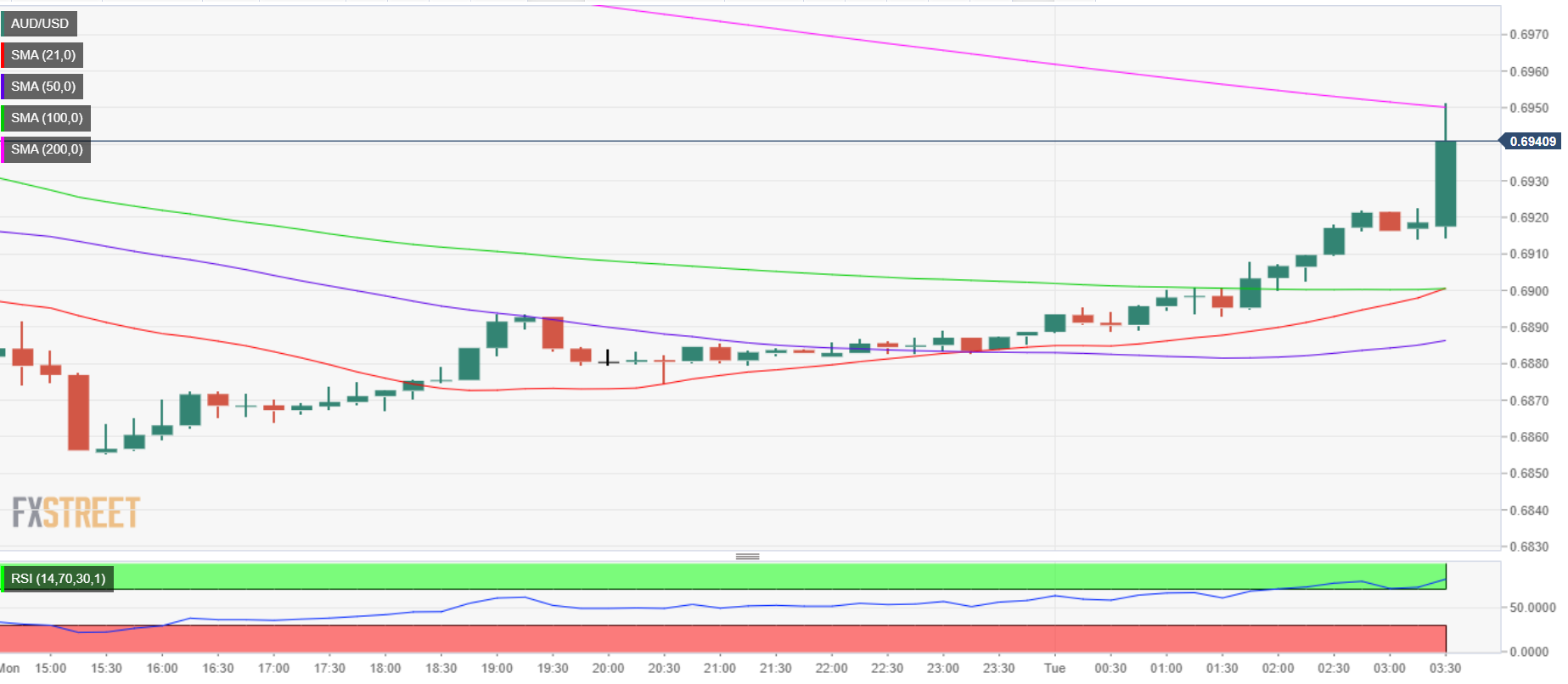
AUD/USD: 15-minutes chart
About the RBA rate decision
RBA Interest Rate Decision is announced by the Reserve Bank of Australia. If the RBA is hawkish about the inflationary outlook of the economy and rises the interest rates it is positive, or bullish, for the AUD. Likewise, if the RBA has a dovish view on the Australian economy and keeps the ongoing interest rate, or cuts the interest rate it is seen as negative, or bearish.
| Raw materials | Closed | Change, % |
|---|---|---|
| Silver | 22.264 | -0.15 |
| Gold | 1867.68 | 0.19 |
| Palladium | 1601.45 | -0.91 |
- GBP/JPY bulls struggle to keep the reins after two-day uptrend.
- 10-DMA, 21-DMA and two-month-old resistance line challenge immediate upside amid sluggish MACD.
- Bears should wait for 61.8% Fibonacci retracement breakdown.
GBP/JPY makes rounds to 159.40 while fading the two-day uptrend during early Tuesday. In doing so, the cross-currency pair jostles with the 10-DMA hurdle amid a sluggish session, as portrayed by the indecisive MACD.
Even if the quote crosses the immediate DMA resistance surrounding 159.50, which is less expected due to the MACD conditions, the 21-DMA could challenge the GBP/JPY buyers around 159.90.
Following that, the 160.00 round figure and a downward-sloping resistance line from December 13, 2022, close to 160.15 by the press time, appear as the last defense for the GBP/JPY bears before giving control to the bulls.
In that case, the previous monthly high and late December swing top, respectively near 161.85 and 162.35, will be in focus.
On the flip side, the 61.8% Fibonacci retracement level of the cross-currency pair’s September-October 2022 upside, near 157.65, puts a floor under the GBP/JPY price.
Also acting as the key support is an upward-sloping support line from the last September, close to 156.85 by the press time.
Should the GBP/JPY price stays weaker past 156.85, the odds of witnessing a slump toward the previous monthly low near 155.35 can’t be ruled out.
GBP/JPY: Daily chart
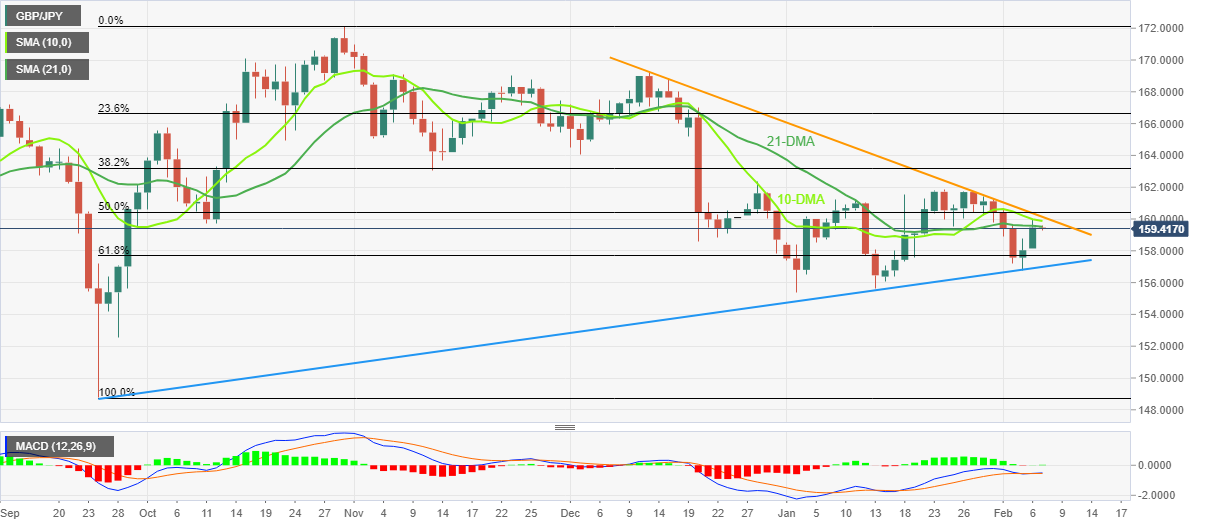
Trend: Pullback expected
- A meanwhile correction in NZD/USD is playing out.
- However, a break of structure can be noted as a bearish bias for the days ahead.
NZD/USD was significantly lower after Friday’s outsized US Nonfarm Payrolls print, but the bulls are moving in as the following technical analysis illustrates.
However, market expectations for the peak in the Fed funds rate up around 30bp since the data and the technical outlook show a broken down market on the charts with structures being broken.
Additionally, the latest data showed that New Zealand's Unemployment rate edged up to 3.4% in the 4th quarter of 2022 from 3.3% in the 3rd quarter, bolstering bets that the central bank will shift to a less aggressive stance. Annual inflation also jumped to a near 3-decade high of 7.2% in the December quarter but below the Reserve Bank of New Zealand's 7.5% projection. If the sentiment that the Reserve Bank of New Zealand were to downshift to a 50 basis point rate hike in February after delivering a record 75 basis point increase in November, the downside bias on the charts will be underpinned:
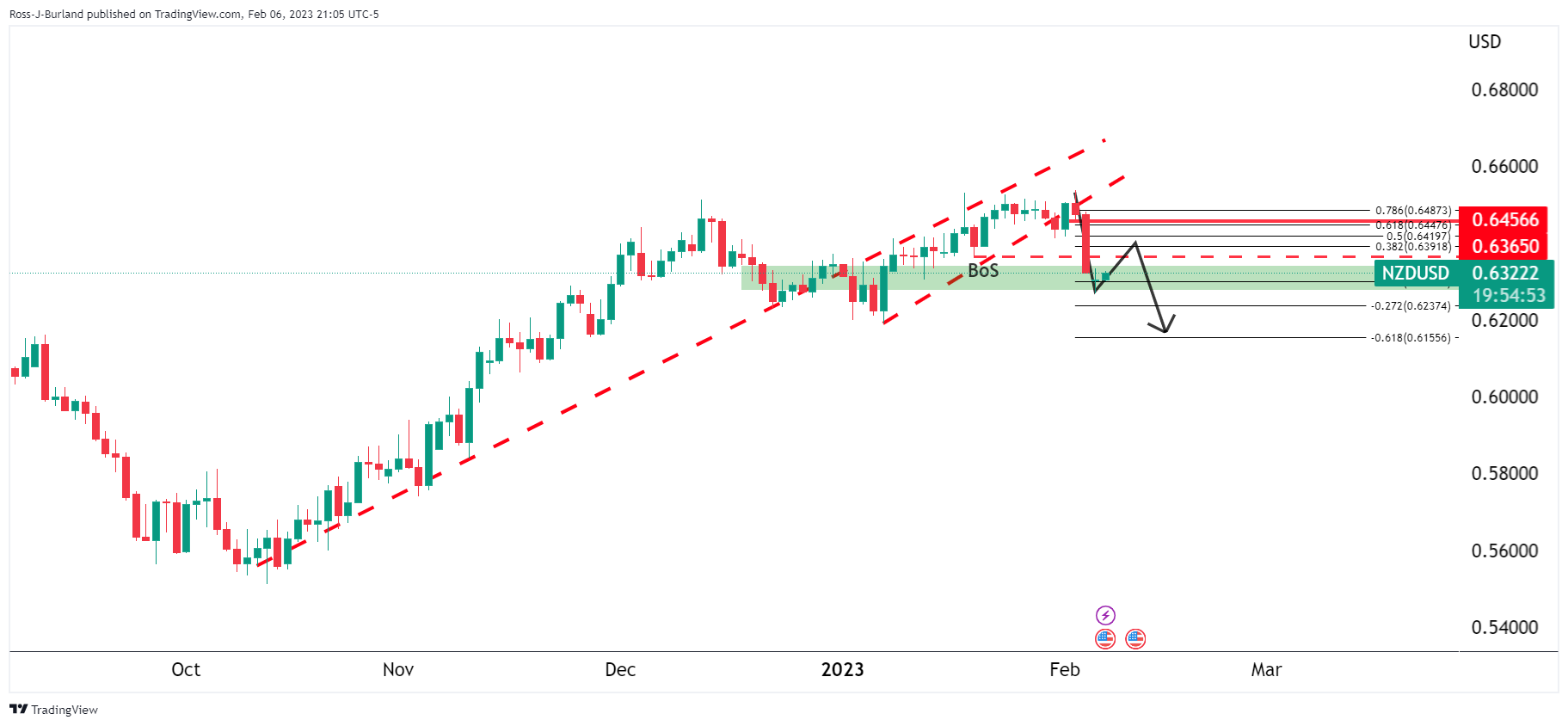
Zoomed in ...
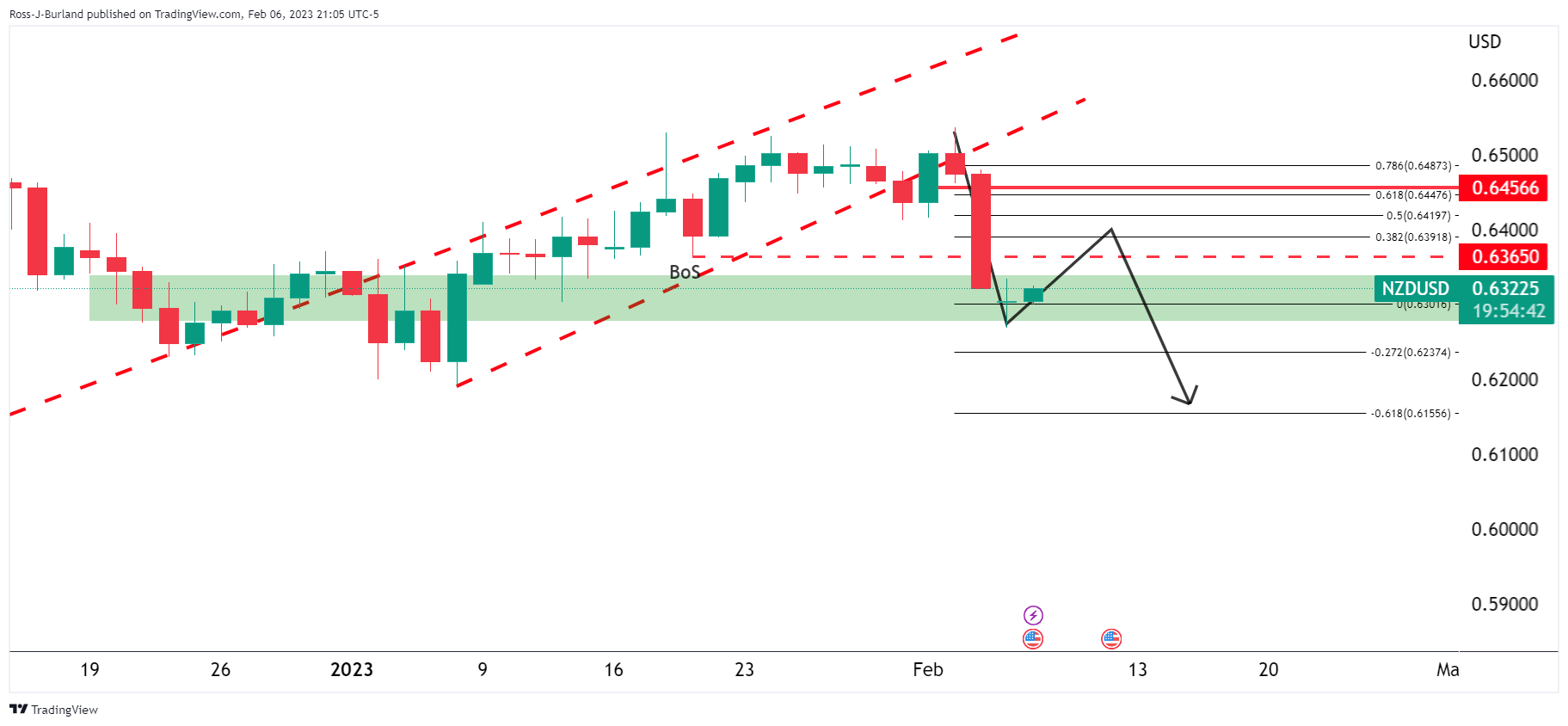
A meanwhile correction is playing out but the break of structure can be noted as a bearish bias for the days ahead that leaves 0.6200 vulnerable.
After announcing consecutive eight rate increases so far, the Reserve Bank of Australia (RBA) is up for another hawkish monetary policy outcome, despite teasing doves of late, during the scheduled Interest Rate Decision of around 03:30 AM GMT on Tuesday.
The RBA is expected to carry out the slow and steady interest rate hike by lifting the benchmark interest rate by 25 basis points (bps) to 3.35%, the third such in a row.
Given the recently mixed statements in the RBA minutes and a contrasting play between inflation and growth numbers, the AUD/USD traders will be more interested in hearing about the end of the rate hike trajectory, making this event crucial.
Ahead of the event, Westpac said,
Westpac anticipates that the RBA will lift the cash rate by 25bps, to 3.35%. Markets are fully priced for 25bp. The RBA, in responding to a significant inflation challenge and the tightest labor market in 50 years, has quickly raised interest rates. Rates have been raised from a record low of 0.1% in May 2022, with moves at each monthly Board meeting, including 50bp hikes for the four meetings July to September. The RBA slowed the pace of tightening at the October meeting, back to 25bp increments, with policy arguably moving into the contractionary zone.
On the same line, FXStreet’s Valeria Bednarik said,
A 25 bps is mostly priced in by market players, which means the focus will shift on whatever Governor Philip Lowe and co. hint for the near future. If policymakers somehow diminish the chances of at least two more rate hikes, the market will read it as dovish, resulting in AUD/USD extending its slide.
How could the RBA decision affect AUD/USD?
AUD/USD picks up bids to renew intraday high around 0.6900 amid the market’s cautious optimism during early Tuesday. The quote’s recent recovery takes clues from headlines that suggest easing fears of the US recession woes, as well as improvements in the Aussie-China ties. In doing so, the Aussie pair also cheers the pullback in the US Treasury bond yields and the US Dollar ahead of the key RBA, as well as Fed Chairman Jerome Powell’s speech.
That said, the RBA is up for 0.25% rate hike but can surprise the bulls with a 0.50% rate lift, considering the inflation woes. The same teases the AUD/USD bulls ahead of the event. That said, the headline Consumer Price Index (CPI) marked stellar numbers on a quarterly and monthly basis but the Aussie economic growth appears to lag the 3.0% RBA forecasts for 2022.
Should the RBA shows readiness to pause the rate hike trajectory from the next meeting, the AUD/USD may have a further downside to trace. However, the need for more rate lift could allow the quote to extend the latest rebound.
Technically, a convergence of the 50-DMA and 61.8% Fibonacci retracement level of the June-October 2022 downturn, around 0.6860 by the press time, defends the AUD/USD bulls. However, bearish MACD signals and a sustained closing below the three-month-old previous support line, close to 0.6930 by the press time, keep the Aussie bears hopeful.
Key quotes
Reserve Bank of Australia Preview: Hinting toward an end to its rate hike cycle?
AUD/USD grinds above 0.6860 key support on softer Aussie trade surplus, RBA, Fed’s Powell eyed
About the RBA interest rate decision
RBA Interest Rate Decision is announced by the Reserve Bank of Australia. If the RBA is hawkish about the inflationary outlook of the economy and rises the interest rates it is positive, or bullish, for the AUD. Likewise, if the RBA has a dovish view of the Australian economy and keeps the ongoing interest rate, or cuts the interest rate it is seen as negative, or bearish.
- USD/CAD snaps three-day uptrend as it eases from two-week high.
- Cautious optimism in the market allows WTI crude oil to remain firmer.
- US Dollar retreats amid anxiety over Powell’s speech after the last week’s disappointment from Fed.
- BoC’s Macklem needs to defend the hawkish bias to please bears.
USD/CAD holds lower grounds near the intraday bottom during the first negative daily performance in four, mildly offered near 1.3430 amid early Tuesday. Even so, the Loonie pair remains near the highest levels in 12 days as traders await speeches from Bank of Canada (BoC) Governor Tiff Macklem and Federal Reserve (Fed) Chairman Jerome Powell.
The quote’s latest weakness could be linked to the market’s mildly positive sentiment amid receding recession fears. Adding strength to the pullback moves could be the firmer prices of WTI crude oil, Canada’s key export item.
That said, WTI crude oil rises 0.40% to $75.00 while extending the previous day’s rebound from a two-month low. The black gold’s recovery could be linked to the easing fears of the US economic slowdown, as well as recent positive headlines surrounding the Sino-American ties.
Although the US economic calendar was mostly silent but growth optimism conveyed by US Treasury Secretary Janet Yellen and President Joe Biden seemed to have probed the US Dollar bulls. Even so, joined hawkish Fed talks seem to put a floor under the US Treasury bond yields, as well as the US Dollar. “The strong labor market probably means ‘we have to do a little more work,’” said Federal Reserve Bank of Atlanta President Raphel Bostic in an interview with Bloomberg.
Elsewhere, a dash on the US diplomatic visit to Beijing and China’s harsh reaction to the US shooting down its balloon by terming it a spying attempt triggered the market’s risk-off mood and propelled the USD/CAD pair the previous day. However, the latest comments from US President Joe Bide appear soothing on the matter as he said, “The balloon incident does not weaken US-China relations.”
While portraying the mood, S&P 500 Futures print mild gains but the US 10-year Treasury bond struggled for clear directions around 3.63%, after a two-day rebound from the monthly low.
Furthermore, upbeat prints of the Canada Ivey Purchasing Managers Index for January, 60.1 versus 55.2 expected and 49.3 prior, also seem to exert downside pressure on the USD/CAD price.
Looking forward, USD/CAD traders could initially react to the Canadian trade numbers for December. However, speeches from BoC’s Macklem, Fed’s Powell and US President Joe Biden’s State of the Union (SOTU) will be crucial for clear directions.
Technical analysis
Another failure to cross the 50-day Exponential Moving Average (EMA), around 1.3450 by the press time, keeps USD/CAD bears hopeful.
- The oil price has soared nearby $75.00 amid hopes of a solid recovery in China.
- IEA’s Birol claimed half of the growth in global oil demand this year will come from China.
- Investors should brace for a hawkish interest rate guidance in Fed Powell’s speech.
West Texas Intermediate (WTI) is on the verge of capturing the critical resistance of $75.00 in the Asian session. The black gold recovered dramatically after dropping to near $72.60 amid growing hopes of an economic recovery in China after dismantling the pandemic controls.
The recovery move in the oil price was extremely firmer despite caution in the market mood. Meanwhile, the US Dollar Index (DXY) has corrected to near 103.17 after printing a fresh four-week high of 103.40. After a three-day strong winning spell, the USD Index is expected to display a sideways performance ahead of the speech from Federal Reserve (Fed) chair Jerome Powell, which is scheduled for Tuesday.
Rising fears of a recession in the United States have already dented oil demand for the past one year. And, a further decline in oil orders looks likely on expectations that the Fed will hike interest rates amid skyrocketing employment additions in the US labor market in January. A sheer increase in the US employment numbers despite slowdown in activities has made the battle against inflation uglier. Stronger-than-anticipated fresh additions of labor could propel a rebound in the declining trend of the US Consumer Price Index (CPI).
Meanwhile, commentary from International Energy Agency (IEA) Executive Director Fatih Birol on the sidelines of the India Energy Week conference on Sunday that “Oil producers may have to reconsider their output policies following a demand recovery in China, the world's second-largest oil consumer,” as reported by Reuters has infused an adrenaline rush into the oil bulls. He further claimed, “Half of the growth in global oil demand this year will come from China.”
For further guidance, investors will keep an eye on the oil stockpiles data by the US American Petroleum Institute (API) for the week ending February 03.
- EUR/USD consolidates recent losses around one-month low, probes three-day downtrend.
- ECB hawks forget the last week’s failed attempt to please bulls, upbeat EU data also favors Euro buyers.
- Receding concerns about US recession, hawkish Fedspeak exerts downside pressure on the pair.
- Fed Chair Powell, ECB’s Schnabel could entertain traders, Sino-American news are important too.
EUR/USD licks its wounds around 1.0735 while probing bears at the monthly low, after a three-day dominance, during early Tuesday. In doing so, the major currency pair portrays the market’s indecision ahead of the key events, namely speeches from the European Central Bank (ECB) and Federal Reserve (Fed) officials.
The Euro failed to cheer hawkish ECB speak, as well as firmer Eurozone data, on Monday as it dropped to the lowest levels since January 09 amid broad US Dollar recovery.
“The risk of doing too little dwarfs thr risk of overtightening policy,” European Central Bank (ECB) policymaker Robert Holzmann said on Monday.
Talking about the data, the Eurozone Sentix Investor Confidence index improves further to -8.0 in February from -17.5 in January vs. -12.8 expected. On the same line, Eurozone Retail Sales arrived at -2.8% YoY in January vs. -2.7% expected and -2.5% prior. Furthermore, German Factory Orders growth jumped to 3.2% MoM following an upwardly revised 4.4% fall in December, as well as 2.2% market forecasts.
On the other hand, the US economic calendar was mostly silent but growth optimism by US Treasury Secretary Janet Yellen and President Joe Biden joined hawkish Fed talks to propel the US Treasury bond yields, as well as the US Dollar. “The strong labor market probably means ‘we have to do a little more work,’” said Federal Reserve Bank of Atlanta President Raphel Bostic in an interview with Bloomberg.
That said, a dash on the US diplomatic visit to Beijing and China’s harsh reaction to the US shooting down its balloon by terming it a spying attempt triggered the market’s risk-off mood and weigh on the EUR/USD pair the previous day. However, the latest comments from US President Joe Bide appear soothing on the matter as he said, “The balloon incident does not weaken US-China relations.”
Against this backdrop, S&P 500 Futures print mild gains but the US 10-year Treasury bond struggle for clear directions around 3.63%, after a two-day rebound from the monthly low.
Looking forward, sluggish markets and pre-event anxiety may restrict immediate EUR/USD moves ahead of German Industrial Production for December, a speech from ECB policymaker Isabel Schnabel and Fed Chair Jerome Powell, not to forget US President Joe Biden’s State of the Union (SOTU) comments.
Although the ECB hawks may try to keep the EUR/USD afloat, major attention will be given to the US policymakers’ statements for clear directions amid hawkish Fed bets.
Technical analysis
A sustained downside break of an ascending trend line from early November, around 1.0850 by the press time, keeps EUR/USD sellers hopeful amid bearish MACD signals and the downbeat RSI (14), not oversold. That said, the pair’s further downside towards the 50-DMA, around 1.0690, appears imminent unless the quote stays below 1.0850.
In recent trade today, the People’s Bank of China (PBOC) set the yuan at 6.7967 vs. the last close of 6.7988.
About the fix
China maintains strict control of the yuan’s rate on the mainland.
The onshore yuan (CNY) differs from the offshore one (CNH) in trading restrictions, this last one is not as tightly controlled.
Each morning, the People’s Bank of China (PBOC) sets a so-called daily midpoint fix, based on the yuan’s previous day's closing level and quotations taken from the inter-bank dealer.
Further to the earlier announcements by Japan's Ministry of Finance, Japan's Finance Minister Shun'ichi Suzuki has crossed the worse and stated that the intervention last year was in response to excessive volatility.
The announcements in Tokyo have coincided with a stronger Yen:
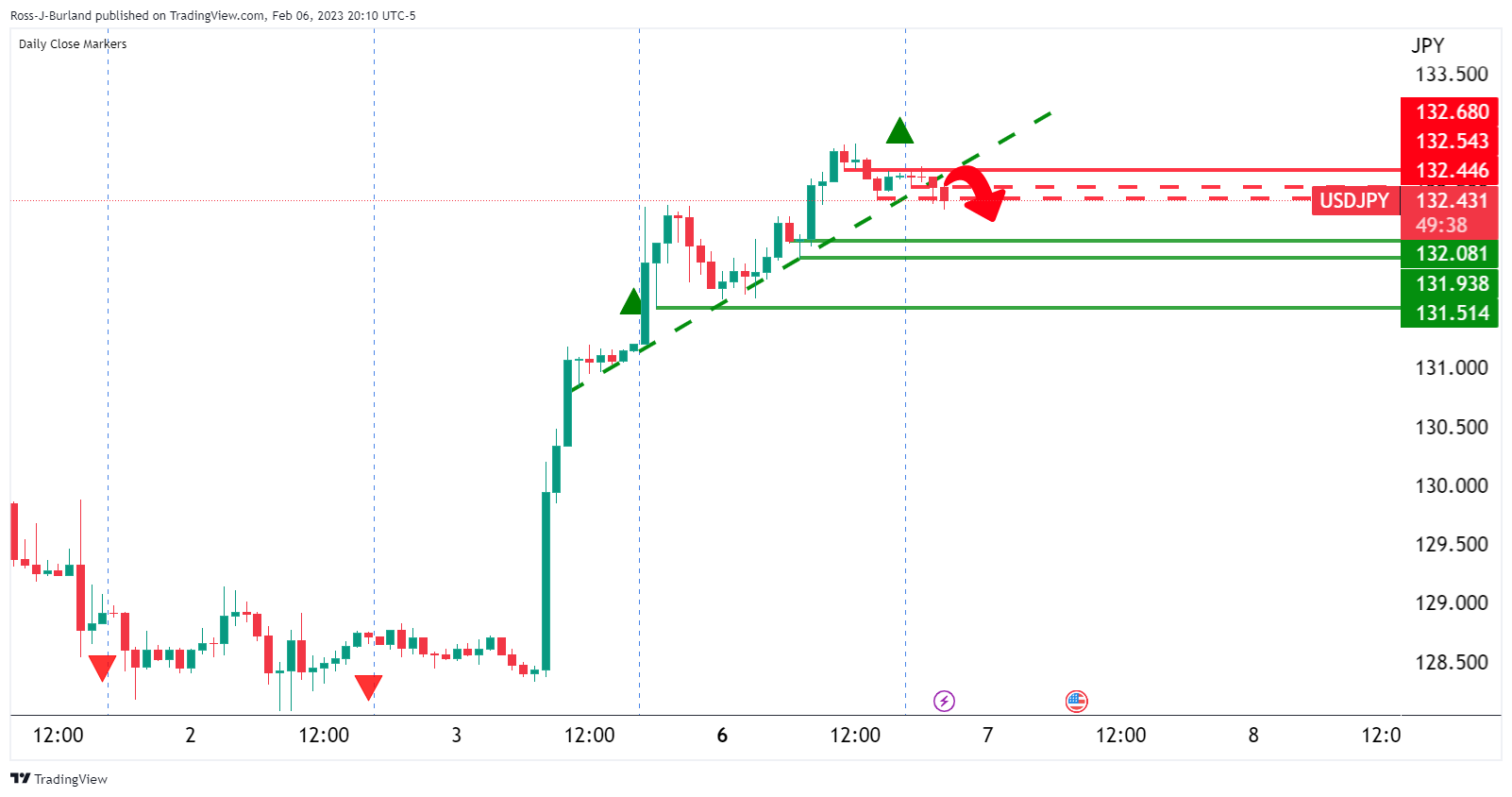
The Yen is breaking down structures which leaves low-hanging fruit for the bears to target for the day ahead with eyes on the 132.00 area as 132.50 gets broken down.
On the 15-min chart, the bears are potentially locking in a high for the day but are yet to crack below Monday's higher low of the day around 132.39:

- A busy week ahead for GBP/USD with domestic growth and central bank speakers.
- GBP/USD bulls are attempting to correct the US Dollar's strength.
- On the daily chart, the 38.2% Fibonacci is around the psychological 1.2150 area.
GBP/USD is flat on the day at 1.2025 so far as we enter the Tokyo session with the price sticking to a narrow 1.2013-1.2027 so far. The Pound Sterling fell to a one-month low against the US Dollar at the start of this week with traders focussing on British growth data and Bank of England speakers.
Analysts at TD Securities explained that the ''further strikes, a fall in hospital visits, and heavy snowfall likely drove a sharp decline in December'sGross Domestic Product''
''However,'' they said, ''even this bad a monthly reading won't quite tip the UK into recession—for now at least. On a sectoral level, we look for a 0.5% fall in the services sector (market: -0.4%) but think strong auto-production drove manufacturing output up 0.2% MoM (market: -0.2%).''
Central bank speakers on tap
Meanwhile, the Bank of England's Monetary Policy Committee member Catherine Mann on Monday spoke and was advocating for more hikes in the BoE's interest rates. She said pausing will risk a confusing "policy boogie". Looking ahead, Huw Pill and Governor Andrew Bailey will be heard.
''We continue to expect the BoE to deliver a final 25bp hike in March,'' analysts at Danske Bank said. ''Our expectations fall below current market pricing (currently 34bps until June 2023) as we expect the rest of the BoE committee to increasingly turn less hawkish amid a weakening growth backdrop and easing labour market conditions. Markets are pricing in 40bp of cuts during H2, while we keep our forecast of the first cut to be delivered at the beginning of 2024,'' the analysts added.
All in all, global equity markets dropped to start the week and the US Dollar firmed again from Friday's rally on the back of the US jobs market suggesting interest rates will stay higher for longer. Central banks are fighting to slow inflation amid relatively strong economic growth.
In this regard, there will be a slew of Federal Reserve officials also speaking this week. We will hear from Chair Jerome Powell later today in the New York session and the tone as suggested by Federal Reserve Bank of Atlanta President Raphael Bostic could be hawkish. He said January’s strong jobs report raises the possibility that the central bank will need to increase interest rates to a higher peak than policymakers had previously expected.
“It’ll probably mean we have to do a little more work,” Bostic told Bloomberg News in a phone interview on Monday. “And I would expect that that would translate into us raising interest rates more than I have projected right now.”
GBP/USD technical analysis
GBP/USD has closed in the red for three day's in a row and given the stage o the week, we could be in for some consolidation and a move up into the in-the-money shorts:

However, as the illustration above suggests, the bears could be lurking in a move-up to test the break of structure area (BoS) near 1.2090.

On the daily chart, this would tally up with a correction of the daily bearish impulse but the 38.2% Fibonacci, a targetted level in such scenarios, is higher in at around the psychological 1.2150 area.
- USD/JPY has slipped below 132.50 as risk-on mood attempts recovery amid easing US-China tensions.
- Anticipation for further continuation of interest rate hikes by the Fed after mammoth labor additions has soared.
- BoJ’s aggressive market operations have drastically limited the scope for speculation in bond futures.
The USD/JPY pair has slipped below the immediate cushion of 132.50 in the Asian session. The asset is sensing selling interest after a two-day positive move amid a rebound in the risk-on market mood. Positive commentary from US President Joe Biden on US-China relations has improved the risk appetite of the market participants.
US President Joe Biden cited on Monday at the White House “The balloon incident does not weaken US-China relations.” This has infused some optimism in the overall negative market impulse. Risk-perceived assets like S&P500 futures are showing some strength after a two-day sell-off in early Asia. However, the return generated by the 10-year US Treasury bonds is still higher at 3.64%.
The US Dollar Index (DXY) settled Monday on a promising note and is expected to remain bullish ahead of the speech from Federal Reserve (Fed) chair Jerome Powell, which is scheduled for Tuesday. The speech from Fed’s Powell will provide cues about the likely monetary policy action in March. The street is expecting a further continuation of interest rate hikes by the Fed as mammoth fresh additions in the United States in the labor market have triggered the risk of a rebound in US inflation.
The US Consumer Price Index (CPI) is in a downtrend for the past few months. However, tight labor market conditions possess the capability of infusing fresh blood into the inflation projections as a major of households equipped with higher earnings could accelerate consumer spending.
On the Japanese Yen front, stronger-than-expected Japanese Labor Cash Earnings indicate that wage inflation is effectively increasing and could propel the overall inflation ahead. The economic data has increased by 4.8%, higher than the consensus of 0.9% and the former release of 0.5%.
Meanwhile, a report from Reuters claims “the Bank of Japan's (BoJ) aggressive market operations to defend its policy band for yields has not only sapped liquidity in the government bond market but also drastically limited the scope for speculation in bond futures.”
Reuters explained deeply that traders cannot profitably short-sell the nearest three-month futures contract, maturing in March, because the BOJ owns most of the so-called cheapest-to-deliver bonds that the futures contract is pegged to.
- AUD/USD struggles to gain clear directions from Aussie trade numbers for December.
- Australia trade surplus, exports dropped in December, imports improved.
- Market sentiment remains dicey ahead of top-tier events.
- AUD/USD upside hinges on RBA’s more than 0.25% rate hike, Fed’s Powell may praise latest data to defend US Dollar.
AUD/USD remains sidelined around the intraday high near 0.6890, portraying the typical pre-data anxiety, as the Aussie pair traders await the Reserve Bank of Australia’s (RBA) monetary policy meeting announcements on early Tuesday. In doing so, the risk barometer pair also takes clues from the sluggish market sentiment, as well as mixed data at home.
Australia’s headline Trade Balance eased in December to 12,237M from 13,245M expected and 13,201M prior. Also negative was the Exports growth which sank to -1.0% from 0.0%. However, the improvement in Imports, from -1.0% to 1.0%, seemed to have defended the AUD/USD bulls.
It should be noted that the recent improvement in the Aussie-China ties seemed to have triggered trade optimism for the AUD/USD pair traders. Following a virtual meeting between trade ministers of Australia and China on February 6, China’s Commerce Ministry said that Australian and Chinese trade and commerce ministers conducted pragmatic and candid exchanges.
Elsewhere, comments rejecting fears of the US recession from Treasury Secretary Janet Yellen and President Joe Biden allow S&P 500 Futures to print mild gains. However, hawkish concerns surrounding the Fed, backed by the US data and Fed talks, seem to challenge the risk appetite, as well as the AUD/USD bulls.
“The strong labor market probably means ‘we have to do a little more work,’” said Federal Reserve Bank of Atlanta President Raphel Bostic in an interview with Bloomberg.
Amid these plays, the US 10-year Treasury bond yields grind higher around 3.63%, after a two-day rebound from the monthly low.
Looking ahead, AUD/USD pair traders should pay attention to how the RBA justifies the latest jump in inflation and economic challenges. That said, the Aussie central bank is up for 0.25% rate hike but can surprise the bulls with a 0.50% rate lift.
Following the RBA action, Fed Chair Jerome Powell’s speech, as well as US President Joe Biden’s State of the Union (SOTU) comments, will also be important for the AUD/USD pair traders to watch. Should Powell chooses to praise the latest economic developments in the US, as well as reiterate hawkish bias for the monetary policy, the AUD/USD could have a further downside to track.
Also read: Reserve Bank of Australia Preview: No choice but to keep hiking rates
Technical analysis
A convergence of the the 50-DMA and 61.8% Fibonacci retracement level of the June-October 2022 downturn, around 0.6860 by the press time, defends the AUD/USD bulls. However, bearish MACD signals and a sustained closing below the three-month-old previous support line, close to 0.6930 by the press time, keep the Aussie bears hopeful.
The Aussie trade balance released by the Australian Bureau of Statistics is out as follows:
- Australia December balance goods/services A$+12,237 mln, s/adj (Reuters poll: A$+12,500 mln).
- Goods/services exports -1 pct MoM, seasonally adjusted.
- Goods/services imports +1 pct MoM, seasonally adjusted.
AUD/USD update
The markets are waiting for the Reserve Bank of Australia's interest rate decision and AUD/USD is holding in familiar ranges on the data.
AUD/USD licks its wounds below 0.6900 with eyes on RBA Interest Rate Decision, Fed’s Powell
About the Trade Balance
The trade balance released by the Australian Bureau of Statistics is the difference in the value of its imports and exports of Australian goods. Export data can give an important reflection of Australian growth, while imports provide an indication of domestic demand. Trade Balance gives an early indication of the net export performance. If a steady demand in exchange for Australian exports is seen, that would turn into a positive growth in the trade balance, and that should be positive for the AUD.
- Gold price fades week-start rebound from one-month low amid sluggish markets ahead of key data, events.
- United States policymakers tame recession woes, bolster hawkish bias over the Federal Reserve.
- Hawkish Fed bets underpin United States Treasury bond yields and US Dollar, as well as weigh on Gold price.
- Fed Chair Jerome Powell needs to praise recent firmer US statistics to please XAU/USD bears.
Gold price (XAU/USD) treads water around $1,865, following a corrective bounce off the one-month low, as the bullion traders await Federal Reserve (Fed) Chairman Jerome Powell’s speech amid hawkish bias over the United States central bank’s next move. It’s worth noting that the optimism among the US policymakers also weighs on the precious metal prices ahead of the key event.
Easing United States recession woes tease Gold sellers
After witnessing strong United States employment and activity data on Friday, policymakers from the US appear optimistic about the economic transition. The same joins the recent hawkish bias over the Federal Reserve’s (Fed) next move, as well as the technical confirmation, to keep the Gold sellers hopeful.
On Monday, US Treasury Secretary Janet Yellen and President Joe Biden pushed back recession woes by praising the latest statistics. Additionally supporting the hawkish Fed concerns were comments from Federal Reserve Bank of Atlanta President Raphel Bostic. “The strong labor market probably means ‘we have to do a little more work,’” said Fed’s Bostic in an interview with Bloomberg.
US-China tension probes XAU/USD price
While the hawkish Fed bets and the hopes of US growth favor Gold sellers, the receding fears of the US-China tussles seem to put a floor under the metal prices. A dash on the US diplomatic visit to Beijing and China’s harsh reaction to the US shooting down its balloon by terming it a spying attempt triggered the market’s risk-off mood and challenged the Gold buyers the previous day. However, the latest comments from US President Joe Bide appear soothing on the matter as he said, “The balloon incident does not weaken US-China relations.”
US Treasury bond yields favor US Dollar bulls, probe Gold bulls
Given the hawkish Fed bias and the receding recession woes in the United States, the US Treasury bond yields extend Friday’s rebound from the multi-day low, which in turn underpins the US Dollar run-up and weighs on the Gold price. That said, the benchmark US 10-year Treasury bond yields grind higher around 3.63%, after a two-day rebound from the monthly low.
Federal Reserve Chairman Jerome Powell eyed
Given the scheduled speech from Federal Reserve (Fed) Chairman Jerome Powell, the Gold price is likely to remain sluggish ahead of the key event. That said, Fed Chair Jerome Powell could choose to praise the latest improvement in the US data and hawkish Fed bets to exert downside pressure on the XAU/USD. It should be noted that US President Joe Biden’s State of the Union (SOTU) comments will also be observed for short-term directions.
Gold price technical analysis
Gold’s week-start corrective bounce off the one-month low failed to cross the previous support line from late November 2022, now resistance around $1,885, which in turn keeps the XAU/USD bears hopeful.
Adding strength to the downside bias could be the bias signals from the Moving Average Convergence and Divergence (MACD) indicator, as well as the steady Relative Strength Index (RSI) line placed at 14.
With this, the Gold price remains on the way to the 50-DMA support of $1,851. However, a horizontal area comprising multiple levels marked since early August 2022, close to $1,805, will precede the $1,800 threshold to challenge the quote’s further downside.
On the flip side, a daily closing beyond the support-turned-resistance near $1,885 will need validation from the $1,900 threshold to recall the Gold buyers.
Following that, the latest peak and highs marked during March 2022, respectively near $1,960 and $1,966, could lure the XAU/USD bulls.
Gold price: Daily chart
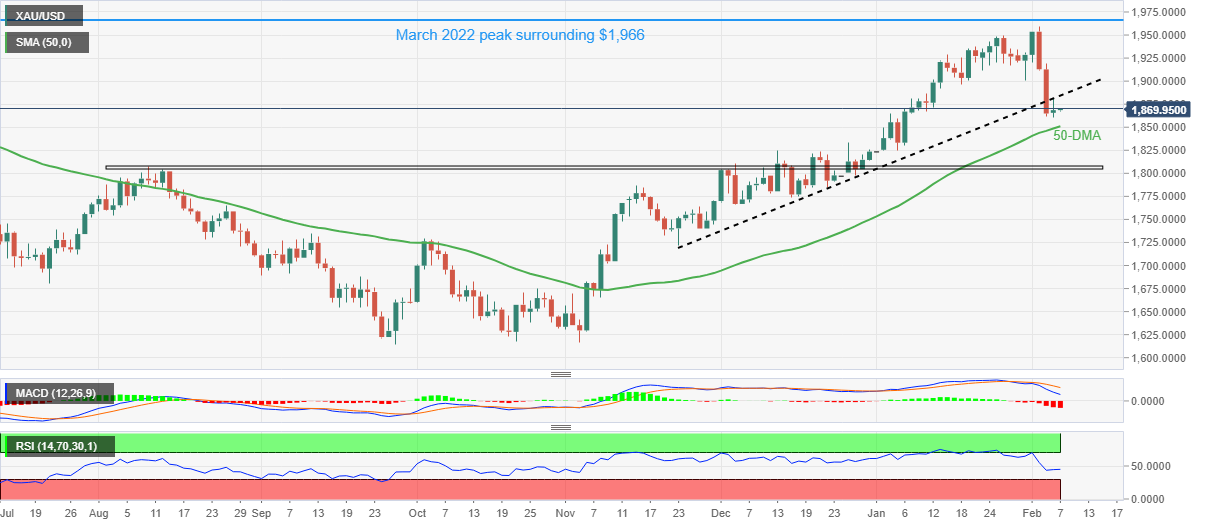
Trend: Further downside expected
| Index | Change, points | Closed | Change, % |
|---|---|---|---|
| NIKKEI 225 | 184.19 | 27693.65 | 0.67 |
| Hang Seng | -438.31 | 21222.16 | -2.02 |
| KOSPI | -42.21 | 2438.19 | -1.7 |
| ASX 200 | -19.1 | 7539 | -0.25 |
| FTSE 100 | -65.09 | 7836.71 | -0.82 |
| DAX | -130.52 | 15345.91 | -0.84 |
| CAC 40 | -96.84 | 7137.1 | -1.34 |
| Dow Jones | -34.99 | 33891.02 | -0.1 |
| S&P 500 | -25.4 | 4111.08 | -0.61 |
| NASDAQ Composite | -119.5 | 11887.45 | -1 |
USD/JPY is sinking in the Tokyo open as Japan's Ministry of Finance confirmed stealth USD/JPY intervention.
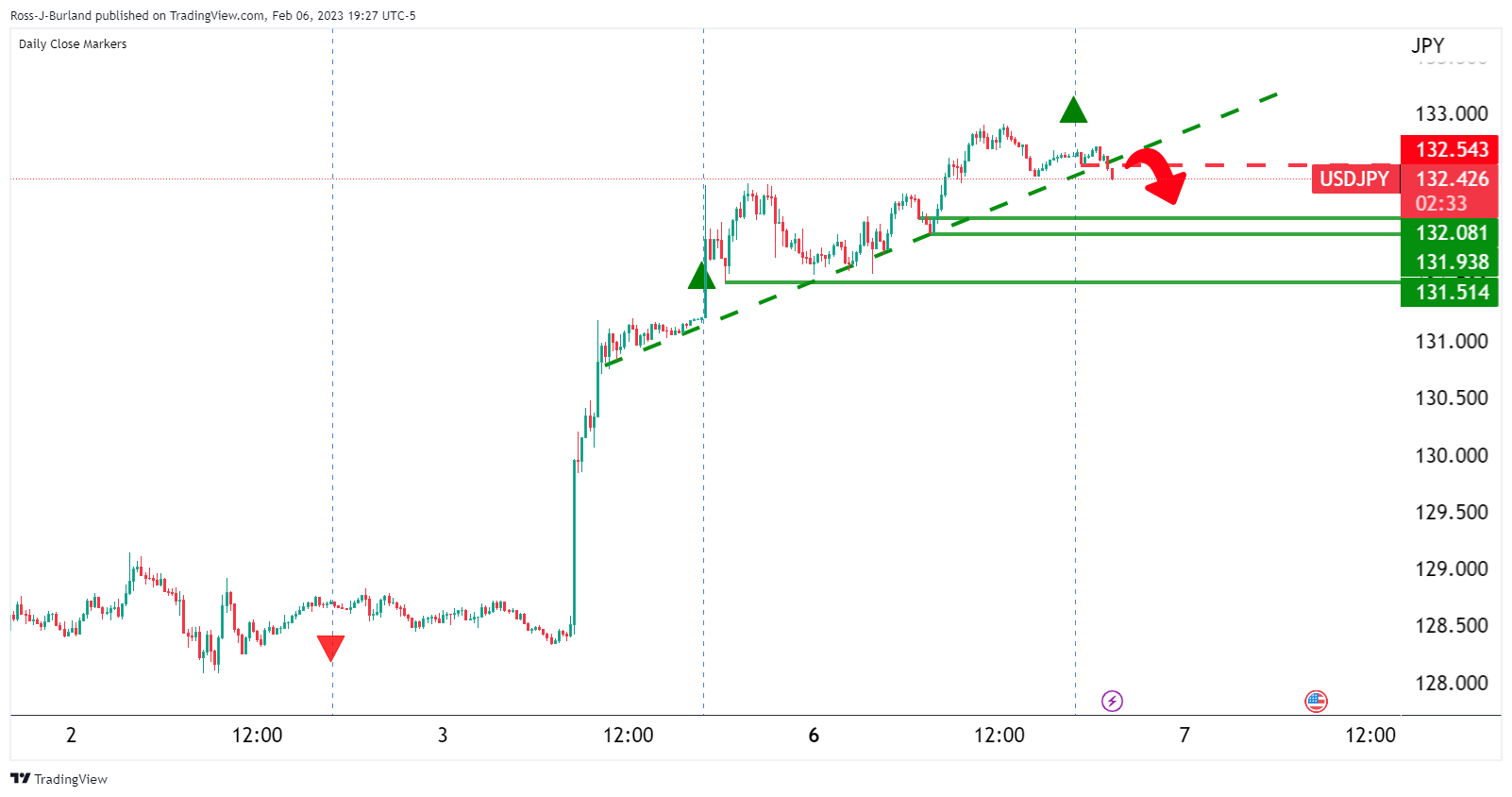
On October 21 and 24th of 2022, the Ministry of Finance conducted a stealth operation intervention. At the time, USD/JPY was soaring and made life uncomfortable for the Japanese central bank.
With the US Dollar skyrocketing on Friday's Nonfarm Payrolls and ending Monday as another green day, investors are jittery. The Yen has a habit of reacting swiftly and sharply in the Asian session as it is. Today, and around the announcement, the Yen jumped and broke through a key structure on the charts as the above technical analysis illustrates. This could lead to a first red day and as a foundation for traders to lean on a directional bias for the day ahead.
| Pare | Closed | Change, % |
|---|---|---|
| AUDUSD | 0.6883 | -0.07 |
| EURJPY | 142.263 | -0.23 |
| EURUSD | 1.07248 | -0.54 |
| GBPJPY | 159.442 | 0.23 |
| GBPUSD | 1.202 | -0.09 |
| NZDUSD | 0.63053 | -0.05 |
| USDCAD | 1.34468 | 0.26 |
| USDCHF | 0.92826 | 0.11 |
| USDJPY | 132.647 | 0.34 |
- EUR/JPY is displaying a subdued performance as fresh hawkish ECB bets failed to strengthen the Euro.
- The ECB might continue hiking interest rates considering a sheer deviation b/w the current inflation rate and the desired one.
- Higher Japan’s Labor Cash Earnings data might propel inflation projections ahead.
The EUR/JPY pair is displaying topsy-turvy moves in a narrow range above the critical resistance of 142.00 in the early Asian session. The cross is expected to witness a downside move below the same despite the hawkish European Central Bank (ECB) bets.
A significant downside in the Eurozone inflation to 8.5% and a recent increase in interest rates by 25 basis points (bps) to 2.50% by ECB President Christine Lagarde in the battle against higher inflation still does not carry confidence for inflation softening. ECB President in her commentary claimed that the price index in Eurozone has peaked now more decline will be recorded in the inflation rate.
The inflation rate is extremely skewed from the desired rate of 2%, therefore the street sees a continuation of the policy tightening spell. Economist at UOB Group Lee Sue Ann cited “In line with our current forecasts, the ECB is expected to hike by another 50bps at the next meeting on 16 Mar. This will bring the refinancing rate to 3.50% and the deposit rate to 3.00% by 1Q23. The Mar meeting will also feature a new set of economic forecasts that should heavily influence the ECB’s decision going forward.
Meanwhile, the Japanese Yen has not responded actively to the Overall Household Spending data. The economic data has contracted by 1.3% vs. the estimates of 0.2% and the former release of 1.2%. This might impact the Bank of Japan’s aim of keeping inflation steady around 2%.
Contrary to that, the Labor Cash Earnings data has jumped to 4.8% against the consensus and the prior release of 0.9% and 0.5% respectively. Japanese officials and the Bank of Japan (BoJ) are dedicating time heavily to escalae wage growth. Further, higher funds equipped by households for disposal will support Producer Price Index (PPI) and eventually the inflation rate.
- US Dollar Index grinds near one-month high as bulls take a breather after three-day uptrend.
- US President Biden, Treasury Secretary Yellen pushed back recession woes and favored hawkish bias over Fed, underpinning DXY run-up.
- Absence of escalation in US-China tussles, cautious mood ahead of Fed Chair Powell’s speech probe greenback buyers.
- Powell needs to praise recently firmer US data to keep US Dollar Index bulls on the table.
US Dollar Index (DXY) makes rounds to 103.60 as buyers flex muscles ahead of the key speech from Federal Reserve (Fed) Chairman Jerome Powell. In doing so, the greenback’s gauge versus the six major currencies tracks upbeat US Treasury bond yields, as well as hawkish concerns surrounding the Fed, to keep the DXY bulls hopeful.
That said, statements from US Treasury Secretary Janet Yellen and President Biden favor DXY bulls, by pushing back the recession woes and bolstering the hawkish bets on the Fed’s next moves. That said, both policymakers turned down expectations of the US recession in their respective speeches. The greenback also cheered sustained run-up in the US Treasury bond yields and downbeat equities as traders renew hawkish bets on the Fed after strong US data.
It’s worth noting that the last week’s upbeat prints of the US employment, wages and activity numbers renewed hopes that the Fed has a way to go before welcoming the rate cute chatters, as well as the policy doves.
Other than the receding recession fears and upbeat US data-led hawkish Fed bias, the recent talks surrounding the Sino-American ties also entertain the DXY bulls the previous day, especially after the US shot down a Chinese balloon and pushed back a diplomatic visit to Beijing. However, the latest comments from US President Joe Bide appear soothing on the matter as he said, “The balloon incident does not weaken US-China relations.”
Against this backdrop, Wall Street closed in the red and the US 10-year Treasury bond yields extended the last Friday’s rebound, which in turn allowed the DXY to remain firmer for the third consecutive day.
Looking forward, US Dollar Index may witness a sideways move ahead of the key Fed Chair Jerome Powell’s speech, as well as US President Joe Biden’s State of the Union (SOTU) comments. Should Powell chooses to praise the latest economic developments in the US, as well as reiterate hawkish bias for the monetary policy, the DXY could have further upside to track.
Technical analysis
Although confirmation of a three-month-old falling bullish chart formation keeps the US Dollar Index (DXY) bulls hopeful, the 50-DMA resistance surrounding 103.60 challenges the immediate upside momentum.
© 2000-2024. All rights reserved.
This site is managed by Teletrade D.J. LLC 2351 LLC 2022 (Euro House, Richmond Hill Road, Kingstown, VC0100, St. Vincent and the Grenadines).
The information on this website is for informational purposes only and does not constitute any investment advice.
The company does not serve or provide services to customers who are residents of the US, Canada, Iran, The Democratic People's Republic of Korea, Yemen and FATF blacklisted countries.
Making transactions on financial markets with marginal financial instruments opens up wide possibilities and allows investors who are willing to take risks to earn high profits, carrying a potentially high risk of losses at the same time. Therefore you should responsibly approach the issue of choosing the appropriate investment strategy, taking the available resources into account, before starting trading.
Use of the information: full or partial use of materials from this website must always be referenced to TeleTrade as the source of information. Use of the materials on the Internet must be accompanied by a hyperlink to teletrade.org. Automatic import of materials and information from this website is prohibited.
Please contact our PR department if you have any questions or need assistance at pr@teletrade.global.
